« May 2006 | Main | July 2006 »
June 30, 2006
panasonicEmotion
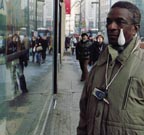
Audio-Prosthesis
The Panasonic Emotions Testing Line, by "nomadic" development designer JIŘÍ ČERNICKÝ, is a conceptual SD audio-prosthesis that aims to grasp the issue of the emotional deficits in society.
The device is a substitute, personal container for the emotions of users who are not able, or do not want, to experience life through their own emotional perceptions. It looks like a Walkman-type device with headphones that does not play music inside, but rather outside, of the head. The device facilitates the user's emotional communication with the world around him. It is not designed for his/her personal use only but is equipped with a tiny amplifier.

The memory of the SD Audio Player chip card contains a great amount of data containing recordings of authentic human emotions. For instance, if the user finds himself in a situation where he has to argue with someone, yet he does not want to get into confrontation and to waste his own emotions, he locates a password on his SD Audio Player representing an appropriate emotional response, which he then applies accordingly.
The SD Audio Player can also record and thus appropriate other people's emotions: sniveling, peevishness, sobbing, moaning, crying, gradual emotional collapse, breakdown, yelling by a beaten person, the state of mind between laughter and crying, the hysterical family argument from Fellini's film Amarcord, pubescent giggling, comforting and fondling of a baby, a feeling of well-being, enthusiastic effusions, wearing somebody out, cuddling, soothing, etc. Such recordings, including those from movies, can be further edited and modified on a computer. In this way, the user can appropriate the emotions that are conveyed by celebrities and other prominent individuals.
Via VVork. See also Ku: iyashikei-net by Urico Fujii and Ann Poochareon is a networked crying sculpture that allows people to communicate through the interface of tears. [blogged by Régine on we-make-money-not-art]
Posted by jo at 05:35 PM | Comments (0)
Suite Soil Digital Media

Two New Commissioned Audio Works
Concert, June 30, 2006, 8:00 p.m.: A live stream of the June 30th concert is available at this link under SPIKED.
Guy van Belle (Bratislava): "slashtops": The concert program "slashtops" consists of real time manipulations with sound transforming light to sound and sound to light in three parts to investigate the relationship between sound and image, audio art and the visual, a persistent tension in the arts for generations. The first part of the program is a trilogy of arrangements between synthetic and real sounds the source material and inspiration based on recordings made in Quebec based on the movement of the artbots that comprise 'thoughts go by air'. A second source of audio content comes from Munich based on sounds from the city environment and a third from Bratislava, around Zlaty Piesky (an industrial - recreational - commercial area). The second component of the program is based on a translation of light into sound using the computer as an instrument. The third part of the program is a concert version of the installation TICS, which is a translation of light into sound and back to light, with a score based on the novel 'istanbul' by the Turkish writer Orhan Pamuk (2006).
Biography: Guy Van Belle (working and living on the road and in Bratislava) has been prominently involved in the use and development of media for artistic purposes since 1990. Since 2000 xgz has been working under the name of the collective digital band mxHz.org (machine cent'red humanz), creating collaborative performances, concerts, workshops, exhibitions and unexpected experimental/abstract art projects. MxHz.org is co-organizer of the umbrella organisation okno, a non-profit technological art organisation situated in Brussels.
MxHz.org are currently developing 2 sets of autonomously communicating heliumbots. The title of the project is "thoughts go by air". Performances were set up in Brussels, Den Hague, and New York. The current new generation is being developed in Brussels (http://okno.be) and Berlin. A special focus for mxHz.org is on Balkan/Central/Eastern Europa to work towards a new sustainable kind of collaborative projects. A recent ongoing work - 2WR or two-way-radios - is a net-remake of John Cage's Imaginary Landscapes #4 (for 12 radios and 24 performers) based on some historical texts by innovative radio artists. The project started in Prague during the FM@dia conference 2004 and was recently set up as a networked installation at Skolska Prague. With Akihiro Kubota he started the Society of Algorithm in 2001, working on netbased music performances. They participate in festivals and connected concerts. Since 2005 open workshops were added and a residency exchange between Europe and Japan to expand the concept. Recently, they contributed to the Berlin Sonambiente Exhibition.
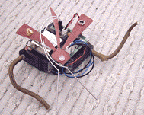
June 30 - July 29, 2006 - Installation: Peter Courtemanche's (Vancouver): "Preying Insect Robots", Opening reception Friday, June 30. Work created for the commission series, "Living with artificial beings" for Soil Digital Media Suite. Preying Insect Robots c. 2006 by Absolute Value of Noise.
Preying Insect Robots is a set of autonomous creatures that move about and communicate using a wireless Internet connection. These robots are modeled after an imaginary jade-green preying mantis - a mechanical creature that is described in the "Martian Chronicles" (by Ray Bradbury). The robots are adaptable to both indoor and outdoor environments - galleries, sidewalks, parks, and performance spaces. They engage in solo and choreographed group activities. The sound of their motors, motion and engagement creates an eerie soundtrack. The piece has a number of manifestations including an installation, a public intervention (performance), a web-presence, and an audio CD based on the sounds of the robots. As the robots wander, they transmit poetry to the Internet - creating montages of found text from a number of science fiction stories, including Feersum Endjinn (1994) and Excession (1996) by Iain M. Banks; The Martian Chronicles (1946 - 1958) by Ray Bradbury; Autofac (1955), Do Androids Dream of Electric Sheep (1968), and The Electric Ant by Philip K. Dick; Mortal Engines (1972 - 1976) by Stanislaw Lem; and For a Breath I Tarry (1966) by Roger Zelazny.
To hear the poetry created by the preying insect bots, go to this link;
http://www.soilmedia.org/preying/
Biography: Peter Courtemanche is a contemporary sound and installation artist from Vancouver. He is the Director and Curator of the Western Front's Media Arts Program - which supports the production and dissemination of experimental audio and electronic art. He has worked extensively in radio-art and electronic/interactive interventions. His art works often have a literary basis - inspired by narrative texts and the history of specific installation sites. As a curator, collaborator and producer he has worked with many established and emerging artists in the production and installation of video, audio, and computer/electronic based art.
Events take place at Neutral Ground
1856 Scarth Street, Regina, Saskatchewan
Curated by Brenda Cleniuk
For funding support, we thank the Canada Council for the Arts, the Saskatchewan Arts Board, Sask Lotteries Trust, the City of Regina and the Department of Canadian Heritage
Posted by jo at 04:42 PM | Comments (0)
June 29, 2006
Second Life
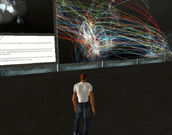
Transposition Opens in Ars Virtua
Friday June 30: Temporal abstractions of information have always been important to communicate ideas, whether simple or complex. By translating information into a visual form, we’re able to reflect upon it with a different perspective. This creation of perspective is the key to transposition.
Transposition is the ability to translate data from one form to another without a loss of information. Transposition is most often used as an algorithmic process to translate information into a more coherent and understandable format. With an increasingly computer enabled world, our collection and cataloging of data is growing by the second. With new forms of data comes the demand for new means to display those forms, and herein lies the job of the transpositionist.
The transpositionist must decide upon the appropriate algorithm to use to convey their perspective on the information. This can be for analysis, speculation, criticism, aesthetic abstraction, or simply experimentation. The end goal influences the disciplines the transpositionist must call upon to appropriately execute his or her idea.
This show includes projects with very different data sets and very different intentions. Data sets ranging from four letter words to prescription pharmaceuticals, to the blogosphere and beyond. Each takes on a unique method for presenting a perspective on information that otherwise would remain unseen.
Opening Friday June 30 from 8pm - 10pm SLT (Pacific Time); secondlife://dowden/41/58
Ars Virtua is a new type of exhibition venue that leverages the tension between the 3d rendered game space and the space occupied by meat. It is part of a series of projects that explore the virtual as the new real.
Located at the edge of Butler and Dowden, in the world of Second Life. To view the exhibit you will need to create an account, download the client and create an avatar http://secondlife.com/join
Ars Virtua's 3000 square meter two story building is divided into a main gallery space, a lounge and shop and residency space.
Posted by jo at 02:39 PM | Comments (0)
Mobile Troops - Urban Jungle/Mobile Media Art
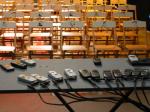
Call for Participation
Mobile Troops Workshop by Laura Beloff & Erich Berger: 12-15 September, 2006 at Atelier Nord Oslo/Norway :: The recent years have witnessed the emergence of mobile and wireless art works in the media arts. The somewhat blurry definition "mobile art" is commonly used as a reference to works, which are incorporating a mobile device (phone, pda, gps) as a part of the work or which are made to be viewed on a screen of a mobile device. Various mobile devices, wireless networks and the concept of technologically enabeld presence are conditions for this kind of art works.
The wide variety of works (locative media, wearables etc) under the category of "mobile art" share usually at least two similarities, they have a technological component as a vital part of them and they are related to a physical object.
Works, which use mobile media as a critical artistic medium are not necessarily always inventing new functions or features for the devices, but are transforming existing possibilities and by doing it they are exposing the characteristics of these devices, networks, and the society using them.
Mobile Troops ironically points to the fact that we tend to increasingly equip us with all kinds of necessary interfaces for surviving the urban jungle. The electronic car key is as important as mobile phone and credit card. Mobile troops is a workshop about media art which is mobile, (possibly) networked, and experimenting with new ideas and artistic concepts.
Utilizing everyday objects and interfaces, like the mobile phone, the workshop introduces strategies, concepts and technologies for artists, designers and practitioners who are interested in mobile art and or working with mobile and networked devices.
The workshop will consist of:
* Introduction into the theory and history of mobile art
* Introduction into the technology of mobile art
* Technological infrastructure
* Potential for mobile art
* Concept development and discussions
* Hands on experiments, research and presentations
There is no technological pre-knowledge necessary.
Tools employed:
Java and Symbian based mobile phones
Mobile Processing
Pure Data
Arduino physical computing platform
WORKSHOP PARTICIPATION
Participation is free of charge. Artists, designers and practitioners interested in participating are asked to apply with a CV to sense[at]anart.no. Application deadline Friday 11th of August. Workshop directors and producer:
Laura Beloff(FI) http://www.saunalahti.fi/~off/off
Erich Berger(AT/FI) http://randomseed.org
Mobile Troops is part of the Interface and Society project at Atelier Nord.
Upcoming:
Interface and Society conference 10th,11th of November
and exhibition 10th - 19th of November -
Henie Onstad Kunstsenter Oslo / Norway.
ATELIER NORD
PHONE +47 23060880
FAX +47 23060884
E-MAIL office[at]anart.no
URL http://anart.no
MAIL Lakkegata 55 D, N-0187 Oslo, Norway
Posted by jo at 02:06 PM | Comments (0)
art.ficial emotion 3.0

Life Writer
Life Writer, by Christa Sommerer and Laurent Mignonneau, consits of an old-style type writer that evokes the area of analogue text processing. A normal piece of paper is used as projection screen and the position of the projection is always matched with the position of the type writer roll. When users type text, the resulting letters appear as projected characters on the normal paper. When they push the carriage return, the letters on screen turn into small black and white artificial life creatures that appear to float on the paper of the type writer itself.
The creatures are based on genetic algorithms -- developed for Life Spacies [2] -- where text is used as the genetic code that determines the behaviour and movements of the creatures.
The artificial creatures can be faster or slower depending on their genetic code and body shape. The creatures need to eat text in order to stay alive and when users type a new text they try to snap up these characters from the paper in order to get energy. Once they have eaten enough text they can also reproduce and have off-spring so eventually the screen can become full.
The user can also push the creatures around when using the scroll of the typing machines cylinder: pushing the creatures back into the machine which will crush them or scroll the creatures off the screen alltogether, making new place for new creatures.
By connecting the act of typing to the act of creation of life, Life Writer deals with the idea of creating an open-ended artwork where user-creature and creature-creature interaction become essential to the creation of digital life and where an emergent systems of life-like art emerges on the boundaries between analog and digital worlds.
Life Writer is part of art.ficial emotion 3.0 ... [blogged by Régine on we-make-money-not-art]
Posted by jo at 02:00 PM | Comments (0)
Régine Debatty Interviews Guilherme Kujawski
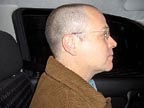
art.ficial emotion 3.0
In its third edition, art.ficial emotion 3.0, the art and technology international biennial that will take place this Summer in Sao Paulo, associates the words "interface" and "cybernetics" to synthesize the idea of interactivity.
As the organisers write: "But, what does "interface" mean? And "cybernetics?" Basically, the former represents any surface which separates two systems, while the latter is a discipline that studies how the referred systems communicate and interact with each other.
If interactivity can be freely defined as a reciprocal relationship between two systems through an interface, just like it happens in the interaction between humans and machines or between machines and other machines, then the works selected for the exhibition perfectly fit within the theory of cybernetics."
(...)
The works selected "embody concepts which are important to cybernetics, such as feedback, communication, causality, information, observation, predictability and equilibrium.
The line-up of the event is simply amazing:
France Cadet's Dog[LAB]01, Eden by Jon McCormack, Life Writer by Christa Sommerer and Laurent Mignonneau, Messa di Voce by Golan Levin and Zachary Lieberman, Les Pissenlits by Edmond Couchot and Michel Bret, Marius Watz' Neon Organic 2, Text Rain by Camille Utterback and Romy Achituv, La Funambule Virtuelle by Marie-Hélène Tramus and Michel Bret, David Rokeby's Cheap Imitation, Daniel Rozin's Software Mirrors, Evolving Sonic Environments by Usman Haque and Robert Davis, Talysis 2 by Paul Prudence, The Thoughtbody Environment Interface by Bill Seaman. [continue reading at we-make-money-not-art]
Posted by jo at 01:49 PM | Comments (0)
June 28, 2006
Worldbench

Uniting School Children Around the World
Worldbench, by Greyworld, is an ambitious art installation that uses park benches to unite locations around the world from Berlin to Newcastle, London to Cape Town.
Each installation is situated in a school and consists of a bench placed next to a wall onto which is projected the mirror image of the bench. However, whilst one side of the bench may be in the grey playground of a primary school in Newcastle the other is in the sun-baked play - ground of a school in Cape Town. The people sitting on the bench can have an idle conversation, discussing their lunch or perhaps indulging in a little light flirtation, which they would have were they sitting on the same bench and not separated by thousands of miles.
Several benches have been installed in five schools across the UK, one in a dynamic inter-racial primary school in Cape Town and another in a secondary school in Berlin.
Posted by jo at 07:09 PM | Comments (0)
TRG [Transreality Generators]
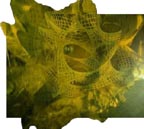
The 'Irreal' in New Media Art
TRG [Transreality Generators]--by FoAM--is a project that builds upon the two previous immersive installations / responsive environments: TGarden and txOom. All three projects are concerned with the 'irreal' in new media art. By 'irreal' we mean artworks that provoke a tension or imbalance between tangible reality and the imaginary worlds. With responsive environments, the line between the real and the imaginary can be very thin, allowing for the experience to become 'irreal' - where the participants fade in and out of physical reality, uncertain of their position in this 'reality continuum'. TGarden was designed to allow human gestures to use video and audio as calligraphic media, to 'write and draw' the immersive environment on the fly. txOom extended the concept and became an 'irreal ecology' where media would grow based on their interaction with the participants. TRG changes scale once more, to infinitely large and infinitely small 'irreal universes', whose existence is highly unstable and unpredictable, where minuscule local interactions can conjure up the lives massive worlds.
The conceptual framework within which the artists develop their concepts and designs is 'simulation of physics and physicality of simulation'. In order to be able to 'mix' the physical and the virtual reality in interesting ways, the artists explore the basic principles that constitute our universe (gravity, electromagnetism, nuclear forces) and create media worlds as new universes, where physical laws become amplified, distorted, enlarged etc. To the audience immersed in the MR environment, these worlds should 'feel' as familiar and intuitive, but upon closer inspection their strange and magical properties can become apparent. The TRG team creates rich media worlds consisting of materials, objects, interfaces and architectures that allow a seamless transition between the physical reality and the computational worlds. By correlating some of the more interesting properties in the physical systems (such as fundamental physical forces, string theory and membrane physics, tensegrity principles, etc.), and abstracting them, there is the potential to create new (coherent) laws within the media-worlds.
The project focuses on Mixed Reality (environments containing significant virtual and physical interaction possibilities, strongly intertwined) and exploring its implications in the cultural sphere. Mixed Reality (MR) enables the public to be immersed in multisensory, responsive media environments capable of reacting and evolving, influenced by human activity and interaction. The participants leave the role of the observers and become creators of a temporary autonomous reality. In TRG, an international team of artists and technologists explore the frontiers of this unique form of creative expression through the integration of self-contained systems of media, materials and structures, perceived as a distinct field of reality, embedded in the physical objects and architecture. This project examines the potential to extend their artistic practice into the field of situational experience design, in which the art-works become all-encompassing art-worlds. [Related]
Posted by jo at 06:28 PM | Comments (0)
Sheet

Spamming: from aesthetics to politics
Re: the VALtgUM
just for guys Bret
Any med for your girl to be happy!
These email subjects are everything but unfamiliar. Everyday our email boxes are packed with offers of mood elevators or sex drive enhancers, insane lottery prizes, great business offers and opportunities, just to name a few. The word coming to our mind is spamming, defined by wikipedia as the sending of unsolicited bulk email - that is, email that was not asked for (unsolicited) and received by multiple recipients (bulk). It has been restricted to unsolicited commercial e-mail, not considering non-commercial solicitations such as political or religious pitches, even if unsolicited, as spam. But the fact is spam refers to form rather than content. Commercial or not, it is spam and it's hell!
What drives people to spam? Easy money is the first answer that comes to mind, but besides that, what other motivations lie behind non-commercial spamming? Art, of course. Spam art, one of the endless subdivisions of the ever elusive discipline once coined as net art, is probably the less identifiable as such. Disguised as warnings, cries for help, subversive money promises and the like, these projects flood the world’s inboxes, exploring bulk emailing as a primary source of creativity, in what can be thought of as a spamming aesthetics.
Recently, Sheet, a project by Portuguese artist Susana Mendes Silva has been circulating rather insistently through the new media art world. Being such an interested observer, Silva has been developing for some time now a body of work that revolves around the Internet user and how can he or she be an aware, perhaps critical, user of the medium. Either through emailing, chatting, or internet phoning, she asks questions that force us to think about what does “being online” actually imply.
In Sheet, an email attachment sent by a fictional character (Ada Evollace from Hidden Agenda contemporary art editions), everything is ambiguous. If the project draws strength from the spam art paradigm, it is so only in a utilitarian way. Sheet preys on spam in order to achieve its own goals, a secret agenda (the name of the editions company is everything but a coincidence) dating back to 2001 and to the Publico (Centerfold) project (a two-page newspaper insert that mimics a gigantic information plaque one can regularly find next to a work of art, containing information about it, but in this case the plaque contained information about itself), and easily connected to the questioning of art not only as an object, but as a product, a commodified art, that is nothing more than a deluxe merchandise accessible only to a few enlightened connoisseurs. Sheet thus is spam in which it was sent through an unsolicited bulk email. It uses that spam aesthetics mentioned above to arrive to a spam politics, through which it aims to undermine, once again, the institutionalized art world and its logics. But once again ambiguity reins.
The project, a pdf file acting as an authenticity certificate of itself, assumes the role of an original work of art, but where is that original? Where lies the difference between the first document the artist created and all the ones she sent to the endless email accounts? None, and it is not possible to think of them as multiples either. They are the same, they are ubiquous. Yet Silva claims that each file is a unique (authentic) and signed (the file has a scanned signature of the artist) work of an unlimited edition. The nature of the work also adds to the ambiguity: it is a computer file, and more specifically, a pdf document, but is it meant to be printed? Or to exist solely as an open window on your computer screen? When you print it, what happens to it? Does it become a copy of the file you have on your machine or is it the original? But what was the original in the first place? Confusion arises and Silva actually wants it to happen. It is what drives this project, the thin line where it stands.
From aesthetics to politics, spamming is used to shed light into the ideologies running around unnoticed. “In case of public exhibition of the work the owner should contact the artist”. This is the last information the certificate bears. Even more ambiguity, irony even. How can she be taken seriously when she wants to be informed of the fate of a spam mail? She is criticizing the art world, through spamming an authenticity certificate, but at the same time she is claiming intellectual property over something that she sent (carelessly) to the world, her art work, acknowledging its right to be featured in a public art show. The questions once again arise. What is the difference between the “public” in spamming and the “public” in an art show? What property can she claim when she willingly gave away all control she had over the project? Is it still hers? If people resent it to others did they modified it and destroyed its essence? What if someone managed to alter the file? Is this modification the same kind as the previous one? What right does the artist have to ask to be informed about Sheet’s whereabouts? And is a spammed file subject to being shown in an art exhibition or does it loose its specific features, what made it “art”, when not being spammed?
All these questions are what drives the project. Silva is completely aware of that. She wants us to dwell on the intangible nature of Sheet. To think about its inconsistencies and realise they are the inconsistencies of information (and art) at the dawn of a new century. The paradigm is slowly shifting and not only is she aware of that, she wants us to be aware of it as well.
Posted by luis at 10:54 AM | Comments (0)
THE FUTURESONIC 2006 AND PLAN CONFERENCE

SOCIAL TECHNOLOGIES SUMMIT
MANCHESTER UK, 20-23 JULY 2006: The Social Technologies Summit is presented in association with PLAN - The Pervasive and Locative Arts Network, and features a linked exhibition Off The Map. Opening event Thursday 20th July, 4.30pm; Conference Friday 21st & Saturday 22nd July, 10am-5pm.
SUMMIT PARTICIPANTS INCLUDE: Masaki Fujihata, last.fm, Regine Debatty, Steve Coast, Share NYC, Toshio Iwai (Electroplankton on the Nintendo DS), Matt Webb, Richard Peckham (Galileo/Astrium), Inke Arns, Stephen Kovats, Tom Carden, Atau Tanaka, Jose Luis de Vicente, Stanislav Roudavski, Steve Benford, Rob Van Kranenburg, James Wallbank, Ben Russell, Drew Hemment.
Plus talks and presentations by festival artists including Zachary Lieberman, Simon Pope, Michelle Teran, Jen Southern, Pete Gomes, Open Music Archive, Owl Project, Pete Hindle, Sven Koenig, Victor Gama, mimoSa, Bandung Center for New Media Arts, and many more.
SUMMIT STRANDS
An Audience With... Toshio Iwai
Toshio Iwai, one of Japan's leading artists and star game developer at Nintendo, explores the influence of a lifetime immersed in Japan's technology culture, and looks at how it is possible for individual artists to create the kind of projects that previously required a major studio.
Social Arts
Regine Debatty (We Make Money Not Art) and José Luis de Vicente (Art Futura) will look at the arts of social technologies, and also at embryonic philosophies and practices that offer an approach that differs from the European media art orthodoxy.
Collaborative, Creative and Commercial Digital Mapping
A cross section of digital mapping from Masaki Fujihata, who pioneered the use of GPS in stunning, multilayered artworks as far back as 1992, to Richard Peckham, Head of Business Development (Navigation) at Astrium, the leading industrial participant in the Galileo programme (Europe's alternative GPS system), to Steve Coast, whose OpenStreetMap project is challenging entrenched assumptions about how maps are made and who can own them through user-generated, open source digital maps.
Social Technologies Tool Sharing
A quick live sampling survey of what tools the alpha, beta and omega geeks are using, how they use them, and how they make all the pieces fit together. Social technologies wouldn't be much use without users. They are open, connected and intrinsically social. Shared, collaborative technologies once the preserve of hackers in darkened rooms are now a common part of everyday life: MySpace, Wikipedia, Flickr, the internet itself.
Iterative Architecture (Built On An Internet Of Things)
SMS and low grade media have swept all before them over recent years, with games consoles a lonely ghetto for high end visualisation, but there are now some signs of integration with a resurgence of interest in shared 3D virtual worlds such as Second life. Coming from this background Tom Carden and Stanislav Roudavski along with Matt Webb look at how models of behaviour derived from games, anthropology, sensors and mobile devices can feed back into the experience and iterative design of buildings, real and virtual.
Arphids & the Internet Of Things
RFID is an interesting technology with all kinds of potential uses but it is also a major social issue creating reactions as adverse as those generated by GM food. Germany has been used as a testing ground by the global 'arphid' industry, foreshadowing, it is said, what is in store for the rest of Europe and beyond. A session co-presented by HMKV (Dortmund) will explore industry perspectives as well as strange alliances between fundamentalist Christians and left leaning artist-activists.
Build Your Own City
James Wallbank from Access Space, UK will be joined by representatives from Bandung Center for New Media Arts, Indonesia, and mimoSa, Brazil to explore how urban cultures around the world are being reshaped by social technologies.
Social Music
Social change, it is said, can be seen first in music because it is the most fluid and rapidly changing medium. Atau Tanaka (Sony CSL) introduces new musical forms that have evolved in the mobile age. Join the social music revolution with Last.fm. Share NYC come over from New York to present open jam sessions, improvising on each others' signal. And leading figures from the music world reflect on how the industry is being reshaped.
Four free artist-led workshops introduce hands-on skills in physical computing, digital video microscopy, game modification, generative sound and live video performance. Developed for Futuresonic by Creative Labs at the University of Huddersfield.
Game modification, 17th-19th July
Physical computing, 18th-19th July
Blender and sound, 19th-21st July
Build your own 8bit synth, 20th-21st July
The Museum of Science and Industry, Manchester Workshops free but early booking required. Workshop bookings: creativelabs[at]futuresonic.com / 01484 472617
VENUE
1830 WarehouseThe Museum of Science & Industry in Manchester Liverpool Road, Castlefield, Manchester M3 4FP 0161 832 2244 http://www.msim.org.uk
The Futuresonic 2006 Conference will be staged in the room containing a functioning version of Babbage's Baby computer, within the world's first railway warehouse.
Delegate Pass: 45 GBP
Includes access to all conferences and workshops plus two major exhibitions featuring 35 artworks including world premiers and UK firsts. Also includes Weekender Wristband (normally 25 GBP) which gives free access to over 20 events, entry to the Futuresonic Opening Party and food & drink discounts.
Student Delegate Pass: 10 GBP
Includes access to all conferences and workshops plus two major exhibitions featuring 35 artworks including world premiers and UK firsts. Also includes Loyalty Wristband (normally 3 GBP) which gives discounts on over 20 events.
20 day passes will be available from 10am on each day of the conference on a Pay-What-You-Can basis.
ACCOMMODATION
If you're looking for a place to stay, some of us will be staying at the Britannia Hotel. Any hotels located within a half-mile of this location will put you right at the heart of the festival's night-time action.
The Britannia Hotel, Portland Street, Manchester M1 3LA. 0161 228 2288 / 0845 644 8444
http://10.futuresonic.com/accommodation.html
Supported by EPSRC, University of Nottingham, Liverpool John Moores University, University of Salford, and Manchester Digital Development Agency.
Posted by jo at 10:34 AM | Comments (0)
Aspect - the Chronicle of New Media Volume VII:
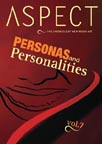
Personas and Personalities
Now Available from Microcinema DVD: Aspect - the Chronicle of New Media Volume VII: Personas and Personalities
This volume of ASPECT features artists working with issues of identity and personality. For some, a constructed identity is an opportunity to explore personal or cultural issues of gender, accountability and culpability. Other artists make their own personality an integral part of their work and process. All the works in this issue examine the role of personal psychology in how we interact with others and our surroundings on an everyday basis. We are thrilled by the quality and diversity of work in this issue, and with the diverse ways in which the artists and commentators interpreted our open call. Enjoy.
Included in this issue: CARIANACARIANNE: Bequeaths, Oaths of Signature with audio commentary by Julie Rodrigues Widholm :: ANTHONY GOICOLEA: Tea Party with audio commentary by Terri Smith :: SACHIKO HAYASHI: Boop-opp-A-Doop with audio commentary by Nicholas Economos :: LYNN HERSHMAN: Becoming Roberta, DiNA with audio commentary by Claudia Hart :: CHRISTIAN JANKOWSKI: The Day We Met with audio commentary by Bill Arning :: ERIK LEVINE: More Man with audio commentary by Elizabeth Smith ::
KRISTIN LUCAS: Involuntary Reception with audio commentary by Marcia Tanner :: JILL MAGID: Evidence Locker with audio commentary by Jelle Bouwhuis :: THE YES MEN: Dow with audio commentary by Marisa Olson :: ADRIANNE WORTZEL: The Veils of Transference with audio commentary by Christiane Paul.
Posted by jo at 10:17 AM | Comments (0)
June 27, 2006
Digital Fringe
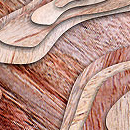
Open Call
Digital Fringe is seeking submissions of digital visual material to be a part of the Melbourne Fringe Festival: September 27 to October 15.
Digital Fringe connects to Melbourne via numerous screens throughout the city. These range from the grand screen at Federation Square to screens hidden in venues and retail outlets, from screens in public spaces, taxis and mobile 3G handsets to bedrooms at home and projections on buildings. Digital Fringe artworks will be streamed live to all participating screens and made available for live streaming over the Internet from the Digital Fringe website.
We are calling for: a.. Proposals for interactive art pieces that will play at Federation Square. The Federation Square interact project is an opportunity to combine phone images, video and texting into an interactive public art piece. Works may involve people sms and mmsing content onto the screens to be incorporated into, or to shape or influence the artwork in some way. We are interested in works that provide innovative ways of getting mobile phones and public screens working together.
b.. Digital art works to display on all screens. These can be stills, animations, video art, short film, abstract pieces, whatever! They will be played without sound. This material will make up part of the general stream which will play on all screens throughout the festival.
c.. Guest programmers to curate and operate the MPU (mobile projection unit).
d.. There are also a number of curatorial, technical and administrative roles where we need people to generally help with the running of the festival.
Eligibility: Anyone is eligible to enter and entry is free. You can submit as many works for screening as you wish. Works can include digital formats including video, animations and still image sequences either graphic or photographic - to be broadcast to the Digital Fringe screens and around the world on the Internet.
Simeon Moran
e: simeon[at]horsebazaar.com.au
m: 0402 514 017
Horse Bazaar
397 Lt Lonsdale St
Melbourne VIC 3000
p: +61 3 9670 2329
f: +61 3 9670 7863
w: www.horsebazaar.com.au
Posted by jo at 07:13 PM | Comments (0)
ACM SIGGRAPH Video Game Symposium
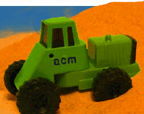
Sandbox
ACM SIGGRAPH is hosting SANDBOX, a two-day video game symposium on 29 July and 30 July in 2006, co-located with SIGGRAPH 06 in Boston, MA, USA.
The symposium will consist of keynotes by Ian Shaw of Electronic Arts and Greg Costikyan of Man!festo Games, panels and peer reviewed papers focused on industry and scholarly perspectives on how video games are designed and developed; analysis of the experience and pleasures of game play; and critical articles on the value and significance of video games as cultural artifacts.
In addition, a "Hot Games" session will preview unreleased titles from major game companies and independent developers, and recently released and classic titles will be available to try. Save $100 on the symposium cost by registering on-line prior to the June 23rd early registration deadline and providing your SIGGRAPH member number.
Posted by jo at 07:07 PM | Comments (0)
The C5 Quest for Success

Call for Participants
Enter to play the C5 Quest for Success during the ZeroOne San Jose / ISEA 2006 Symposium August 9-12, 2006. The C5 Quest for Success is an invited project for ZeroOne San Jose: A Global Festival of Art on the Edge; San Jose, California, August 7-13, 2006.
Quest for Success is curatorial selection as urban game, testing competitors' analysis, management, and cooperative decision making skills - traits needed for success in Silicon Valley. The grand prize is a six to twelve week residency at the Montalvo Arts Center co-sponsored with C5 and a Silicon Valley corporate partner - a great opportunity for the right player with the right project pitch. Contestants navigate the streets of San Jose exploring GPS controlled narratives in an attempt to locate the C5 Corporate Limo. Once there, you just might have the opportunity to pitch your proposal to a panel of distinguished experts. A single winner from each evening's competition then advances to the final round on Saturday, August 12th. Three finalists representing TALK, DEMO, PERFORM 'present' their pitch live on-stage to an audience of thousands during the ZeroOne San Jose culminating celebration.
Does the smell of gasoline and oil perk you up like caffeine? Do lat and long coordinates make your heart sing? Then apply for a chance to win the Montalvo Arts Center C5 artist residency. Six to twelve weeks in picturesque Saratoga, California, working on the project of your dreams with the assistance of one of Silicon Valley's corporate powerhouses. Does mapping make you giddy? Does your imagination swell listening to stories about entrepreneurial masterminds and nefarious misdeeds? The C5 Quest for Success is your opportunity to be the passionate competitor you know you are.
C5 Corporation specializes in cultural production informed by the blurred boundaries of research, art and business practice.
Posted by jo at 06:58 PM | Comments (0)
Installations at Eyebeam
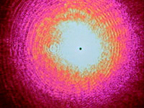
Modern Orthodox + EarthSpeaker
June 29 through July 15 Eyebeam is pleased to present three new installations developed in our studios exploring innovative uses of sound and light, both visible and undetectable, to fix and define spatial environments.
Elliott Malkin's Modern Orthodox is a working demonstration of a next-generation eruv installed on 21st Street in front of Eyebeam in New York City. An eruv (pronounced ey-roov [related]) is a symbolic boundary erected around religious Jewish communities throughout the world. While an eruv is typically constructed with poles and wires, Modern Orthodox employs a combination of low-power lasers, wifi surveillance cameras and graffiti, as a way of designating sacred volumes of space in urban areas.
The eruv is an ancient architectural construct that stems from the observation of the Sabbath, the sacred day of rest that includes a prohibition against certain kinds of work, including the carrying of objects outside of one's home, or private domain.
The presence of an eruv allows some carrying on the Sabbath by symbolically converting the shared public space within its boundaries into the shared private space of a community. In this way, observant Jews can carry objects such as keys or prayer books while acting in accordance with sacred Talmudic principles.
Because the physical integrity of an eruv is essential to its symbolic function, a breach in any portion of it renders it useless, which is why the entire circumference of an eruv, usually miles in length, is customarily inspected prior to every Sabbath. Malkin's laser eruv, however, which relies on a continuous stream of photons rather than cords and wires, is not as susceptible to permanent breakage. A branch of a tree, for example, may impede the flow of photons but will not permanently damage the eruv apparatus. In this way, the laser eruv is self-healing. Malkin also uses surveillance cameras to monitor the laser eruv connections from a remote location, allowing eruv managers to identify obstructions more efficiently. The content of these video transmissions are displayed at Eyebeam as part of the installation of this work.
Elliott Malkin is a new media artist whose work explores the use of everyday objects invested with the power to "sanctify" space. His most recent work, Modern Orthodox, focuses on the eruv, a symbolic boundary used as part of the observation of the Jewish Sabbath. Elliott's other work includes eRuv, a virtual reconstruction of an eruv that once existed on the Lower East Side of Manhattan – and Crucifix NG, a next-generation crucifix that broadcasts a radio frequency version of The Lord's Prayer. Elliott is also investigating the way religion and technology combine to inform the construction of memorial sites. Elliott is originally from Chicago and lives in New York City. He also works as an Information Architect.
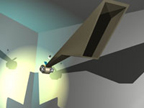
Jeff Feddersen's EarthSpeaker is series of large-scale autonomous, solar-powered sculptures. Drawing their inspiration from dusk-active creatures like crickets, bullfrogs and fireflies, they are designed to absorb and store solar energy during the day and retransmit the energy as acoustic sound for a brief period at dusk. As the sun sets, the system will create a short, distributed chorus of sound until the energy stored for the day is consumed. EarthSpeaker was commissioned as a permanent installation at free103point9's Wave Farm in Acra, NY where it will be transported to after exhibiting at Eyebeam. The challenge of creating a long-term installation, in a harsh environment, using available ambient energy pushed Fedderson's exploration of energy storage, alternative speaker functions and artistic design.
Jeff Feddersen is an artist, musician, and engineer interested in new musical instruments and sustainable energy. He has developed several new means of musical expression, including robotic sonic sculptures, real-time composition software, multi-modal digital input devices, and amplified acoustic instruments. He has exhibited and performed at the Chelsea Art Museum, the Apple Soho Store, and UC Irvine's Beall Media Arts Center, and the Lincoln Center. He has taught electronics, sustainable energy, and digital audio at NYU’s Interactive Telecommunications Program, where he was also a Resident Researcher, and has worked for the Technology Development group of Honeybee Robotics.
Posted by jo at 10:49 AM | Comments (0)
Writing From Live Art
![]()
Critical Writing Initiative
Do you want to write about live art and contemporary performance for journals, magazines and newspapers? Would you value the opportunity to develop your writing in a supportive environment?
If you are interested in writing about a range of innovative performance practices that are not restricted by artform boundaries, then Writing From Live Art could be what you are looking for.
Live Art UK, a national network of venues, promoters and agencies, is running a year-long scheme to develop and nurture writing talent. Writing From Live Art aims to develop writing, which can discuss complex live art and performance work in accessible terms, and on finding suitable publishing points.
Writing From Live Art is open to new writers or writers who are new to live art.
The scheme offers the opportunity to write about a broad range of live practices that address spaces, places and audiences, and that are more about process than product. The focus on accessible yet informed writing means that the scheme is not suitable for writers wishing to solely focus on academic writing or news journalism.
The facilitator for Writing From Live Art is artist and writer Joshua Sofaer.
Writing From Live Art will take the form of two weekend residential retreats, the first on 26th and 27th August 2006 and the second on 17th and 18th of February 2007. The retreats will take place at the Bretton Hall Campus of the University of Leeds, adjacent to the Yorkshire Sculpture Park. Participants will have to commit to both retreats and will also have some ongoing mentor support over the course of the year. The retreats will include set exercises, peer review, and an invited panel of editors to outline what they are looking for. Travel, accommodation and meals during the retreats are all covered by the scheme. A small ‘go and see’ travel and expenses budget will also be available to participants during the course of the year.
There is a limit of five places and expressions of interest are by application only. No formal qualifications are necessary but a commitment and enthusiasm for live art and contemporary performance are vital.
For more information and an application pack, visit http://www.liveartuk.org/projects/writers.htm
Joshua Sofaer is an artist and writer, and a Research Fellow at ResCen, the Centre for Research into Creation in the Performing Arts at Middlesex University in London.
Posted by jo at 10:34 AM | Comments (0)
4 WORKSHOPS @ FUTURESONIC
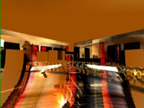
Now Accepting Applications
DRU CreativeLab workshops at Futuresonic, Manchester, UK :: 17 - 21 July 2006, Monday - Friday, 11:00 - 17:00 pm :: Registration fee: FREE!
WORKSHOP #1 "Game modification - games as audiovisual tools" :: BY: Tom Betts & Alison Mealey :: WHEN: 17 - 18 - 19 July :: Through this workshop you'll learn about game modification and how to use game generated data as input for audio and/or visuals. We'll look at level design, game engines and game data, and how to use specific game generated data (i.e. coordinates) in a Digital Signal Processing application.
WORKSHOP #2 "Introduction to physical computing" :: WHEN: 18 - 19 July :: BY: Tuomo Tammenpää & Daniel Blackburn :: Interested in making a custom hardware interface for your software instrument or embedding electronics to your art project but don't know where to start? Two intensive days will give you an introduction to physical computing. We will push buttons, lit LED's, make sounds, detect movement and interface with computer.
WORKSHOP #3 "Controlling sound with the Blender game engine" :: WHEN: 19 - 20 - 21 July :: BY: Enrike Hurtado & Andy Gracie :: This workshop is all about the creation of simple game environments, and using them to generate sound. During the workshop, a whole system for game play and audio will be developed and, most important, played with! The game you'll develop will be playable individually and over the network.
WORKSHOP #4 "Go Forth! - real-time graphics and 8bit sound" :: WHEN: 20 - 21 July :: BY: Tom Schouten, Aymeric Mansoux & Marloes de Valk (GOTO10) :: Go Forth! is a 2 day workshop in which you will build your own mini 8bit synthesizer using a PIC chip. Because fresh tunes simply taste better with some eye candy, we'll also teach you how to make real-time graphics. Go Forth! is based on 100% FLOSS (Free Libre Open Source Software).
MORE INFO: http://goto10.org/-/futuresonic
FEE: free!
BOOKING: Please send an email to creativelabs[at]futuresonic.com stating your name, address, telephone number and the workshop of your choice. Questions by telephone can be directed to +44 (0)1484472617
VENUE: the Museum of Science and Industry, Liverpool Road, Manchester
HOW TO GET THERE:
Bus: bus No 33 from Piccadilly Gardens stops outside the Museum
Tram: nearest Metrolink (tram) station - G-Mex
Train: nearest railway station - Deansgate
///The museum is 98% wheelchair accessible. If you have specific access requirements, please contact us in advance.
///The project is supported by Yorkshire Forward and the Digital Research Unit, University of Huddersfield (http://www.coedd.co.uk)
Posted by jo at 10:25 AM | Comments (0)
BEIJING ACCELERATOR 2006
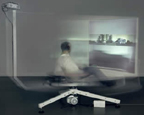
Physical Effects of a Tempo-Driven Society
Beijing Accelerator--by MARNIX DE NIJS--was created after being inspired by a recent visit to Beijing, and the realization of how quickly the dynamics of a city could transform into such apparent modernism. Although similar to an earlier prototype, Panoramic Accelerator, in that it also explores the effects of a tempo-driven society on the individual, this new version has an enhanced cinematographic experience as well as a superior interface.
The basic working principle is naturally akin to the original model; the participant takes position in a racing-chair on a motorized structure equipped with a joystick. This time however, a 160x120 cm screen is positioned in front of the user and while they control both the direction and speed of the chair, rotating panoramic images are projected on the screen before them. The aim is to synchronize the moving image with the rotation of the chair. Once this is achieved, the participant is able to view the images properly and the disorientation associated with the uncoordinated spinning is blocked.
Specific to the Beijing Accelerator, the target square in the top panoramic image needs to be matched with the same position shown on the magnified image below. As soon as this is achieved the images “snap into place” and consequently rotate in sync with the participants movement. After a short period of time however, a new rotating-panorama appears with a higher preset speed. This is determined as the next level and is more difficult to obtain the aforementioned balance in order to cohesively recognize the picture. In total, about 6 levels need to be accomplished for completion of the experience. Movie [via WMMNA]
Posted by jo at 10:12 AM | Comments (0)
June 26, 2006
UPGRADE! BOSTON + EXCHANGE 2006
![]()
Two June Events
UPGRADE! BOSTON: NANCY NISBET AND AMBER FRID-JIMENEZ: WHEN: June 29, 7:00-9:00 p.m. WHERE: Art Interactive, 130 Bishop Allen Drive, at the corner of Prospect Street, Cambridge. [Red Line to Central Square]
Nancy Nisbet is a Vancouver-based artist. From a disturbing paintball gun performance enacting the chaotic fluctuation in the cost of crude oil during the lead up to the US-led War in Iraq/War on Terror to the surgical implantation of 'identity' microchips into her hands, much of her work considers the political, the technological and the personal. Of specific consideration in her mixed-media work are issues of power, economics, and surveillance and their cultural influences on entertainment/leisure, identity and community. Exchange 2006 is a large scale project currently underway. Nisbet received her MFA in Photography from the California Institute of the Arts. Nancy Nisbet is Assistant Professor of Visual Art in the Department of Art History, Visual Arts & Theory at the University of British Columbia.
Amber Frid-Jimenez is an artist and researcher working towards a masters in Media Arts and Sciences with Professor John Maeda in Physical Language Workshop at the MIT Media Laboratory. Prior to beginning her degree, she spent a year as a research designer in the Cognitive Machines Group at MIT, where she designed software systems visualizing large bodies of literature. Frid-Jimenez was a visiting artist at the Banff New Media Institute in 2005 and artist-in-residence at the Virginia Center for the Creative Arts in 2003. Her work has been exhibited in galleries in New York, Washington D.C., and Boston. She has received grants from MIT Council for the Arts for her collaborative work with Joe Dahmen, Ben Dalton, and Noah Fields. She has won awards from the Art Director's Club, the American Association of University Presses and the Smithsonian for her book and exhibit designs.
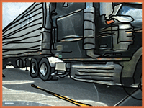
Upgrade! Boston and Turbulence.org, in partnership with Art Interactive, proudly present a performance of EXCHANGE 2006 by Nancy Nisbet. Trade your goods for Nancy’s! Two Events /1/ WHEN: June 30, 1-4 p.m. WHERE: mobile cart, Massachusetts Avenue, Central Square, Cambridge/2/ WHEN: July 1, 1-4 p.m. WHERE: in the parking lot opposite Art Interactive, corner of Bishop Allen Drive and Prospect Street.
EXCHANGE 2006 replaces the studio with roads, truck stops, border crossings and cities. For 6 to 9 months Nisbet’s Radio Frequency Identification (RFID) tagged and inventoried personal belongings are being hauled in a commercial shipping container to be freely traded throughout Canada, the United States and Mexico. The performance includes the day-to-day travel and activities associated with driving a commercial transport truck and the contact with people and communities along the way.
"At each scheduled stop on the route, the team parks the truck, lowers the ramps, unloads at least half of the crates and invites viewers to peruse the goods. If a person happens to find something that tickles their fancy, they take it to the "mini house," temporary tech centre that operates on wireless technology, where the customer checks out the item while checking in something of theirs to replace their "purchase." Each item is tracked using RFID technology and logged into a database. In addition to the object exchange, the customer also relays the story behind their giveaway object to the crew, which is saved as an audio file, and in exchange Nisbet tells them the story behind their newly acquired item, sort of like an anecdotal gift wrap." (National Post, canada.com)
The trip and exchanges are being extensively documented and published at http://exchangeproject.ca.
Posted by jo at 06:43 PM | Comments (0)
June 25, 2006
The Body and the Screen:
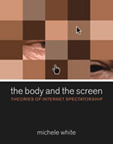
Theories of Internet Spectatorship
The Body and the Screen: Theories of Internet Spectatorship by Michele White -- Internet and computer users are often represented onscreen as active and empowered--as in AOL's striding yellow figure and the interface hand that appears to manipulate software and hypertext links. In The Body and the Screen Michele White suggests that users can more properly be understood as spectators rendered and regulated by technologies and representations, for whom looking and the mediation of the screen are significant aspects of engagement. Drawing on apparatus and feminist psychoanalytic film theories, art history, gender studies, queer theory, critical race and postcolonial studies, and other theories of cultural production, White conceptualizes Internet and computer spectatorship and provides theoretical models that can be employed in other analyses. She offers case studies and close visual and textual analysis of the construction of spectatorship in different settings.
White shows that despite the onscreen promise of empowerment and coherence (through depictions of materiality that structure the experience), fragmentation and confusion are constant aspects of Internet spectatorship. She analyzes spectatorship in multi-user object-oriented settings (MOOs) by examining the textual process of looking and gazing, contrasts the experiences of the women's webcam spectator and operator, describes intentional technological failures in net art, and considers ways in which traditional conceptions of artistry, authorship, and production techniques persist in Internet and computer settings (as seen in the creation of virtual environment avatars and in digital imaging art). Finally, she analyzes the physical and psychic pain described by male programmers in Internet forums as another counternarrative to the common tale of the empowered user. Spectatorship, White argues, not only affects the way specific interfaces are understood but also helps shape larger conceptions of self and society.
Michele White is Assistant Professor in the Department of Communication at Tulane University.
Table of Contents
1. Making Internet and Computer Spectators
Introduction
Rendering Liveness, Materiality, and Space
Notions of the Empowered User
Addressing the Spectator
Stabilizing Identity
Erasing the Interface
Conclusion: Active Users by Design
2. Visual Pleasure through Textual Passages: Gazing in Multi-user Object-oriented Settings (MOOs)
Introduction
MOOs
The Look and the Gaze
Character Creation and Attributes in MOOs
The Look and the Gaze in MOOs
Gendered Gazing in MOOs
Graphical MOOs
Conclusion: Between Multiple and Coherent Identity
3. Too Close to See, Too Intimate a Screen: Men, Women, and Webcams
Introduction
Feminism and Spectatorship
Critical and Journalistic Considerations of Webcams
Webcams
Women and Webcams
Regulating the Spectator
Women Webcam Operators and Authority
Visibility and Webcams
Making Texts Real
Some Problems with Webcam Viewing
Just a Guy
Conclusion: The Politics of Being Seen
4. The Aesthetic of Failure: Confusing Spectators with Net Art Gone Wrong
Introduction
Aesthetics and Net Art
Net Art
An Aesthetic of Failure
Jodi
Peter Luining
Michaël Samyn
Conclusion: The Limits of Failure and Repetition
5. Can You Read Me? Setting-specific Meaning in Virtual Places (VP)
Introduction
Virtual Places
Avatars
Painters and Avatar Galleries
Owning Texts
Criteria for Originality
Theories of Internet Authorship
Gender, Race, Sexuality, and the Avatar
Making Differences in Virtual Places
Conclusion: Authorship in Other Internet Settings
6. This Is Not Photography, This Is Not a Cohesive View: Computer-facilitated Imaging and Fragmented Spectatorship
Introduction
Making the Digital Imaging Spectator
Photography
Digital or Post-photography
The Scanner as Camera
Carol Selter's Animalia and Punctum
Susan Silton's Self Portraits and Images of the Partial Self
Ken Gonzales-Day's Skin Series and the Cut
The New Media Grid
Conclusion: The Morphed Spectator
Afterword
The Flat and the Fold: A Consideration of Embodied Spectatorship
Introduction
Carol Selter, Susan Silton, Ken Gonzales-Day, and the Fold
The Body Folded and Evacuated
Hierarchy and Control
The Spectator in Pain
The Fat and the Fold
Men and the Weight Loss "Challenge"
Erotic Folding
Conclusion: A Technology of Waste
Acknowledgments
Notes
Selected Bibliography
Index
Posted by jo at 04:37 PM | Comments (0)
BBC Radio 1
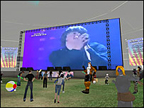
Talent-Spotting in Virtual Worlds
"...At Radio 1 we want to bring a new level of social interaction to our virtual broadcasts. We are hoping that the bands featured on-air will have their own custom-built avatars, playing in the virtual world. So if we have the Red Hot Chilli Peppers playing a gig, visitors to a Radio 1 virtual space will see avatars of Anthony Kiedis and Flea, mimicking the action in the real world.
We also believe it is crucial that the virtual audience can interact with the event. It is about replicating the "liveness" of an event, not just broadcasting it. Additionally, Radio 1 wants to find ways of allowing the audience in these worlds to actually affect the real event. I see no reason why they cannot be asking their musical heroes questions, alongside virtual Radio 1 DJs, either via Instant Messenger or VoIP. This deeper social interaction, that mirrors real world events, would do much to enhance the ripples that resonate around digital communities." From Talent-spotting in virtual worlds by Daniel Heaf, BBC.com.
Posted by jo at 03:14 PM | Comments (0)
June 24, 2006
Nathaniel Stern: Creative Commons Artist in Residence
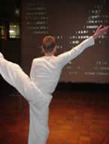
Shares [odys]elicit Under CC/GPL
Friday 23 June 2006, live from the iCommons iSummit:
[odys] elicit - a full-body, interactive art installation circa 2001 - is now available under a Creative Commons By Attribution Non-Commercial Share-Alike license, and the source code is available under GPL. It works with almost any standard webcam (requiring a few drivers on PC)!
[odys]elicit is a large scale, interactive installation where every movement of the viewer, small or sweeping, births stuttering text onscreen. The viewer’s motion elicits, character by character, passages from odys’ text. The piece responds to small movements, writing the text onscreen slowly for the viewer to read, or to rapid passersby, whose full bodies birth hundreds of flying characters, impossible to decode.
In odys’ work, viewers are forced to look at the spaces between language and meaning, the luxuries of stuttering and silence as communication, and the effects of accelerated and decelerated time. [odys]elicit physically places viewers at the center of co-invented noise, forced to perform - willingly or not. odys’ text has been reduced down to where it no longer has meaning and is re-birthed, with possibly infinite meanings, or none at all.
Click here to see videos of the piece in action.
Downloading:
Please first check out the read_me file - the PC application requires some extra (free) installs, and you can very easily change video settings or sources, input new text, toggle between birthing letters or full words, adjust the motion tracking tolerance levels given different lighting, or change the direction the text will go on the fly! Send me error messages if you encounter any bugs, or have much success! I am yet to fully test the OS 9 or PC versions. Oh, and about any parties or exhibitions that this thing is a hit at, too ;)
read_me.rtf
OS X Application
OS 9 Application
PC Application (still testing)
Source Code (in Director/Lingo + TTC-Pro; demo versions of these will work)
@ Rio iSummit [posted by nathaniel on nathanielstern.com]
Posted by jo at 10:38 AM | Comments (0)
June 23, 2006
GPS EXPO 2006

It is the salt flats :: It is America :: It is free
GPS EXPO 2006: Greetings geocachers, anthropologists, mappers, landscape photographers, GIS users, artists, backpackers, and others with a nominal interest in the Global Positioning System. The event will happen in UTAH and it might be interesting to you. It is real, really informal, free, non-sponsored, and on the salt flats of the GREAT SALT LAKE. Just people and the creative things they are doing with GPS putting together their interests at an amazing place at the same time. The location is on public land, is rugged although perfectly flat and normally drivable, and it requires no particular permission to assemble there. If you take proper safety precautions (H20, sunglasses) you might find it an interesting day of navigation and others navigating with GPS. Cheap to moderate hotel rooms are available in the nearby casinos in West Wendover, NEVADA.
Please join the group and document your project or experience at GPS Expo 2006.
Posted by jo at 06:36 PM | Comments (0)
Picamotics
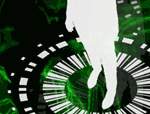
Individually Reactive Space
PICAMOTICS is conceived as an individual public navigation system in which an individual's presence and movement in a space is interpreted and responded to by the system. The resulting “individually reactive space” knows its visitors. Tracking their positions it can follow movements and draw conclusions from individual behaviours.
Picomotics is also referred to as a "collaborative platform for interactive surroundings". In addition to navigation, proposed applications include educational scenarios where individuals are assigned attributes which, when they interact with others, demonstrate abstract concepts in a playful and social manner.

For example, "visitors represent basic mathematic operations such as division, multiplication etc. by walking through a field of numbers. If, for example, the visitor representing an addition of 8 meets the visitor representing a division by 2, the result of their meeting will be 4. Abstract laws of mathematics become tangible."
The system uses infrared camera tracking from above. The floor becomes a trackpad and display. Audio "sound showers" can also be supported. ipunkt (second image) is a similar responsive navigation system with a bit more depth on the development process.
Posted by michelle at 04:20 PM | Comments (0)
Smoke Signals

Writing Space and Memory Clouds
June 24, 2006 at 9:28 p.m. (GMT): Smoke Signals--by Minimaforms--is based on one of the oldest forms of communication in recorded history dating back over 5,000 years. The project works as a hybrid system that explores the dynamic and spatial capacities of smoke and light in relation to contemporary mobile SMS technologies of messaging today. Smoke Signals examines a dynamic real-time interaction that writes space. Smoke and light setup the condition for developing a typographic ambient / responsive environment.
Participants are invited to communicate with the project by sending SMS messages to one of two smoke signals located at the event. Remote participants can send messages through our Real-Time Virtual Interface located at memorycloud.com
Minimaforms was founded in 2002 by brothers Stephen and Theodore Spyropoulos as an experimental design practice that explores design that provokes and facilitates new means of communication. Also see www.fasterthansound.com.
Posted by jo at 03:17 PM | Comments (0)
June 22, 2006
Networked Place Book

Call for Comments
"As a culmination to the Networked Publics program, we are publishing a collaboratively written group book with the MIT Press. As part of this process, we are soliciting reader comments for inclusion in the book. Below is a draft of the essay on Networked Place (note that there is a word document attached too... it is likely easier to read). We intend to take the comments that we received and append them to the essay in a virtual symposium that will follow each chapter. In doing so, we hope to create a more dialogic forum within the book. Please leave your email addresses so that we can get in touch with you about your contribution.
Introduction: Contemporary life is dominated by the pervasiveness of the network. With the spread of the mobile phone worldwide (arguably history’s most successful gadget) and the growth of always-on broadband in the developed world, technological networks are becoming easier to access and more ubiquitous. The “always-on,” “always-accessible,” network—or at least the promise of that condition—has produced a broad set of changes to our concept of place, linking space to network to create networked place.
"The following essay addresses both the networking of space and the spatiality of the network. We identify a series of conditions symptomatic of the culture of network “space”: the everyday superimposition of simultaneous real and virtual spaces, the development of a mobile sense of place or “telecocoon,” the emergence of real virtual worlds, the rise of the network as a socio-spatial model, and the use of mapping technology as a means of understanding the world. At the same time, we recognize that these changes are not simply produced by technology. On the contrary, the development and practices of technology (and the conceptual shifts that these new technological practices produce) are thoroughly imbricated in culture, society, and politics.
Taken together, these changes are already radical, but they may not be radical enough. These could well be the first steps in restructuring our concept of spatiality. The changes we listed above—and describe below—may be mere evidence of the early days of sociocultural shifts of which we can only be partially aware, just as the first theorists of modernism and postmodernism could only partially understand the emerging condition of their day." Continue reading Networked Place by Kazys Varnelis and Anne Friedberg, Networked Publics.
Posted by jo at 05:41 PM | Comments (0)
Implant Matrix
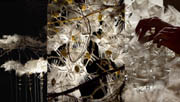
An Empathic Matrix
Implant Matrix is an interactive geotextile that could be used for reinforcing landscapes and buildings of the future. The matrix is capable of mechanical empathy. A network of mechanisms react to human occupants as erotic prey. The structure responds to human presence with subtle grasping and sucking motions, ingesting organic materials and incorporating them into a new hybrid entity.
Implant Matrix is composed of interlinking filtering 'pores' within a lightweight structural system. Primitive interactive systems employ capacitance sensors, shape-memory alloy wire actuators and distributed microprocessors. The matrix is fabricated by laser cutting direct from digital models.
By Philip Beesley and Will Elsworthy with Robert Gorbet and Steven Wood. Assistant Designers: Eric Bury, Liana Bresler, Miriam Ho, Desmond Shum. At Interaccess Gallery June 1-29, 2006.
Posted by jo at 04:30 PM | Comments (0)
Pace of Place

Real-Time Composition
Pace of Place is a "portable, nomadic portal" that creates an "emergent performance of actions and data" of re-sampled activity in urban public wireless hot spots.
A net-enabled, webcam equipped laptop tracks motion at the site and extracts one vertical line of pixels from the image of moving bodies/motion. Custom software both accumulates and explodes the pixel lines, generating an image frame every minute and a 1 minute video loop of sampled time and activity every 30 image frames. The loops from different spaces/places capture and abstract the activity/pace relationship of the spaces.
Marlon Barrios Solano continues the project in residence at The Aesthetic Technologies Lab at Ohio State University and blogs on the residency here where he documents his practice and shares his process.
Posted by michelle at 04:21 PM | Comments (0)
Expo Manchester
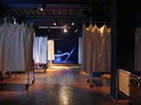
Free Sonic Exploration
Sonic Arts Network and University of Manchester bring the Expo festival to Manchester for a weekend packed with over twenty free events including concerts, installations, performances, exhibitions, happenings, workshops, gigs, conferences and DJ sets. Expo is the hub and playground of the UK’s experimental music and sound art scene, featuring very special guests from around the world. This year’s Expo festival is a sonic exploration of the inner, outer and public spaces of Manchester.
Festival Highlights: Expo kicks off at Cornerhouse on Friday 23rd June (18:00 – 20:00) with the launch event for three solo sound exhibitions, produced in partnership with Cornerhouse that run until 30th July. Staalplaat Soundsystem's extreme and immersive sound installation The Ultrasound of Therapy gives visitors the chance to experience a unique personal sensory experience. Strapped to a hospital bed, ‘patients’ are subjected to personalised sound therapies.
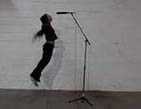
Helmut Lemke invites you to create your own sound pieces in his new work KLANGELN VIII, which transforms fishing rods into intriguing instruments. Bob Levene will explore playful and humourous concepts in a jointly commissioned audiovisual installation - The Space Between: Experiments for Speakers.
On Saturday 24th June (20:00 – 20:45) at The University of Manchester Music Halls, a day of concerts culminates in an ultra-rare appearance of Fluxus maverick Joseph Byrd. The founder of legendary band The United States of America, where he presents White Elephant; his first graphic score for almost 40 years, performed by all-girl Norwegian electro-improv group SPUNK and sound art activists Dreams of Tall Buildings.
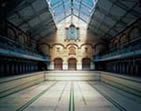
No Petting, No Running, No Bombing on Sunday 25th June (12:00 – 17:30), when Sonic Arts Network takes over Manchester’s vast and historic Victoria Baths, winner of the first series of BBC’s Restoration, with a specially curated programme of sound installation, sonic intervention and performance. Headliners The Owl Project will blend the historic craft of wood turning with hectic glitch electronica. Drop-in and get involved in events taking place throughout the day. Artists will perform in the derelict and empty swimming pools, Turkish baths will be replaced with experimental noise and a man will drown his computer.
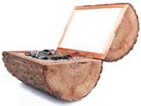
On both Saturday and Sunday night, Expo moves to the Roadhouse (21:30 – Late) for mashed up club nights of hardcore sonic treats ranging from the beautiful to the bizarre. Featuring a showcase from broken electronica label Tripel presenting Ascoltare and Um, plus a rare performance from the reclusive sampler group Quartet Electronische - emerging from the tweed soaked academic sabbatical of their own imaginations to disrespectfully rip up the sounds of Manchester.
All Expo events are free and everyone is welcome to be part of this unique sonic exploration of Manchester’s public spaces.
Posted by jo at 04:09 PM | Comments (0)
Upgrade! New York
![]()
Participatory Performance and Interactivity
Jesse Pearlman Karlsberg + Micah Silver + Judy Dunaway :: June 29, 2006 @ 7:30 PM, Eyebeam, 540-548 west 21st street (bet 10 & 11 Ave).
This month's Upgrade! New York examines participatory performance and interactivity in the context of contemporary sound art and new music. The evening brings together three artists working with sound and music: Jesse Pearlman Karlsberg, Micah Silver, and Judy Dunaway. Each of these artists draws their audience into the creation of their work.
Jesse will discuss Azariah: Whom Jehovah Helps, a new project weaving book arts, poetry, shape note singing, and storytelling into a participatory live event. Azariah turns its audience into an impromptu chorus and draws on Jesse's experience working with shape note singing, audience participation, and New York's religious history.
Micah will talk about his recent installations The Phoenix, *Asterisk, and Carousels. Each piece draws from the local audience's aural and physical experience of site as primary source material.
Judy will talk about her work with balloons and how she draws her audience into music-making, and will be presenting her Balloon Symphony #2. Judy Dunaway's BALLOON SYMPHONIES are audience-participation works. The Balloon Symphonies should not be performed by children under 8 years of age without adult supervision.
BIOS
Jesse Pearlman Karlsberg is a sound artist and shape note singer whose work explores politics, religious practice, singing, and personal narrative. Jesse's work is interdisciplinary. While grounded in sound, his projects have mixed book arts, installation, poetry, singing, composition, audio tour, and theater. His current work investigates the history and practice of American shape note singing and the social and religious movements of nineteenth-century upstate New York. Jesse has presented work at the Tang Museum, Boston Cyberarts Festival, Jessica Murray Projects, CCCB (Barcelona), CAC (North Adams), Google Inc., Old Songs Building, Psy-Geo Provflux Festival, Wesleyan University, and Rensselaer Polytechnic Institute. He is a member of Festival Harmony, and of Tintinnabulate, an ensemble founded by Pauline Oliveros. His shape note music has been sung at singings throughout the Northeast, and his experimental music has been performed by Pauline Oliveros, Anne Rhodes, Angela Opell, Caterina De Re, and Tim Eastman, among others.
Micah Silver was born 1980 in Sylva, North Carolina, but grew up in rural Massachusetts. He studied music composition and art at Wesleyan University where his primary teachers were Alvin Lucier, Anthony Braxton, and Ron Kuivila. He has also studied privately with composers Lewis Spratlan and
Earle Brown. Recent projects include *asterisk for 12 broken grand pianos, loudspeakers, and transduced glass, commissioned by The Hudson Valley Center for Contemporary Art; Carousels, a commission by the James Joyce Centre, Dublin for the centennial of Bloomsday, and The Phoenix a six-month-long outdoor installation commissioned by the City of New Haven. Further information on Silver's work can be found online at nophones.org.
Judy Dunaway is an internationally known sound artist whose works for balloons have been presented throughout North American and Europe including the Roy and Edna Disney Center, Lincoln Center Out-of-Doors, Seltsame Musik Festival, Podewil, ZKM, New Museum of Contemporary Art, Everson Art Museum, Bang On A Can Festival, Seance Ecoute, Diapason, Roulette, Galerie Rachael Haferkamp, Moltkerai Werkstatt, Guelph Jazz Festival, Gracie Mansion Gallery, P.S. 122, Alternative Museum, and the Swiss Institute. Awards / grants / residencies include the Aaron Copland Fund, American Composers Forum, Meet the Composer, ZKM, Harvestworks, and the NEA. Her new CD "Judy Dunaway: Mother of Balloon Music" was just released on Innova Recordings. Her discography also includes recordings on CRI and Outer Realm. Ms. Dunaway holds a M.A. in Music from Wesleyan University and a Ph.D. (candidacy) in Music Composition from State University of New York (Stony Brook).
Upgrade! is an international network of gatherings concerning art + tech + community.
About our partner: Eyebeam supports the creation, presentation and analysis of new forms of innovative cultural production. Founded in 1997, Eyebeam is dedicated to exposing broad and diverse audiences to new technologies and media arts, while simultaneously establishing and demonstrating new media as a significant genre.
Posted by jo at 02:13 PM | Comments (0)
State of the Union
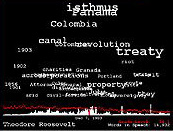
Mapping the Union addresses
State of the Union (SOTU) provides access to the corpus of all the State of the Union addresses from 1790 to 2006. SOTU allows you to explore how specific words gain and lose prominence over time, and to link to information on the historical context for their use. SOTU focuses on the relationship between individual addresses as compared to the entire collection of addresses, highlighting what is different about the selected document. You are invited to try and understand from this information the connection between politics and language–between the state we are in, and the language which names it and calls it into being.
The Words: SOTU maps the significant content of each State of the Union address so that users can appreciate its key terms and their relative importance. The horizontal axis is simply alphabetical. The vertical axis displays the word’s significance, determined by comparing how frequently the word occurs in the document to how frequently it appears throughout the entire body of SOTU addresses (see appendix for details).
Common words (“and,” “the,” etc.) and words that occur frequently in the entire corpus (“states”) are largely filtered out; what remains are words that are especially characteristic of a given address. The size of the word indicates how many times it was used in the document. Click the word to view the full text of the address with the word highlighted.
The Data: The data underneath the map of significant words shows trends in the language of the State of the Union addresses. On the graph, white bars indicate the word length of each address. The red dots indicate readability as measured by the address’s Flesch-Kincaid score, which is meant to suggest the grade level in an American school for which the text is comprehensible. The actual scores are displayed in the bottom right corner of the interface (for more information on Flesch-Kincaid, see the appendix).
State of the Union is a project by Brad Borevitz at onetwothree.net
Posted by luis at 12:33 PM | Comments (0)
BrainMirror

Behold the Brain
BrainMirror, a Swedish-Hungarian co production by Adam Somlai-Fischer(hu) Bengt Sjölén(se) and Danil Lundbäck(se), is an interactive experience where the image of the visitors' brain appears mixed with his/her mirror image, using natural head movement as an interface to explore volumetric visuals of the human brain. The interface allows exploration of complex MRI data. Volumetric renderings are explored by moving closer to the image.
The project was realized using open source and consumer electronics. It will be shown at Electromagnetic Bodies at the Ludwig Museum of Contemporary Art in Budapest.
Posted by michelle at 02:09 AM | Comments (0)
June 21, 2006
Sonic Interface by Akitsugu Maebayashi
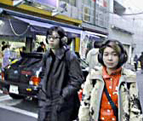
Past Remixed with Present
"Our experience of reality is strongly dependent on the synchronicity of our senses. We must, for instance, hear or touch what we see while we see it, in order to be able to determine reality and in order to decide what to do or how to react. The decoupling in time of sight and sound - like when we first see the lightning and then hear the thunder - can create a disturbing irritation when it affects our immediate surroundings: imagine that you would only hear the cars passing you on the street after they have already past, or that you hear conversations which were held minutes ago in a different location from where you are.
Sonic Interface experiments with human perception by amplifying and manipulating the synchronicity of auditory environment. Equipped with a portable hearing device made of a computer and headphones, the user is invited to walk around the city's public spaces such as squares, shopping malls, and underground stations. The random urban sounds that he hears are first transmitted to the headphones without modification, but then the computer programme begins to create an artificial sonic environment from the sounds that it picks up.
Three different types of software feed the headphones with digitally manipulated sounds. In one instance, the ambient sounds are delayed to different degrees, decoupling the visual and the auditory perception of the surrounding space. Then the sounds are cut up and recomposed into a mosaic with a new chronological order. Finally, the sounds are made to repeat themselves and overlap with each other. In each case, the sonic ambience and the space in which the sounds were formed in the past are being remixed in the present." From Machine Times
Akitsugu Maebayashi (1965) is a Japanese born artist who locates a new sense of reality and consciousness in the act of communication by expanding ones perceptions. His works constantly trigger the communication between the user and the other. His interest in music and musical instruments also provided him with a method for representing time and space. Maebayashi’s work has been exhibited and performed worldwide off-line (Tokyo Design Center, ICC) as well as on-line (Live on-line concert series with Chino Shuichi and others). [via WMMNA]
Posted by jo at 06:39 PM | Comments (0)
BREAKING THE GAME :: THE PANEL
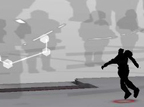
Live in 45 Minutes
BREAKING THE GAME :: THE PANEL :: Wednesday, June 21st, 2006 from 5:00pm to 8:00pm at the Society for Art & Technology in Montreal - Free. The event will be streamed live to the SAT as well as to an online audience.
Workspace Unlimited in collaboration with the Society for Art and Technology will host a public panel looking back at phase one of Breaking the Game, a series of interdisciplinary workshops and online symposium that brought together competing theorists and practitioners to build, debate and reflect on virtual worlds, computer gaming, immersive technologies, and new possibilities for artistic practice and experience. The symposium was conducted exclusively through a variety of telematic technologies: iChat, Skype, virtual walkthroughs, an online forum, and email.
Taking place both online and offline, the workshops opened up the art of game modification to the contingencies of everyday life, where virtual technologies increasingly mediate physical spaces and human movements in very complex and dynamic ways.
Breaking the Game initiators Thomas Soetens, Kora Van den Bulcke and curator Wayne Ashley together with symposium participants Sheldon Brown, Luc Courchesne, and Elizabeth Goodman discuss how, why, and under what conditions their artistic work and research have focused on gaming - as a category of cultural behavior; as allegory; as a series of specific audio/visual and interactive technologies; as an emerging form of machine/human poetics and action. They will consider how their interests in gaming overlap with the increasing computerization of the city and ongoing transformation of the built environment in concert with the proliferation of communication and surveillance technologies. During the event, Brown and Goodman will participate remotely through iChat.
The evening will be divided into two sessions. In the first session we will talk more generally about the format, goals, objectives, and challenges of producing Breaking the Game. In the second phase of the evening we will engage the three symposium participants.
ABOUT THE PARTICIPANTS
Thomas Soetens
Workspace Unlimited - artist - Initiator Breaking the Game
Thomas Soetens, born in Belgium is a new media artist. In 2002 he co-founded the international artist collective Workspace Unlimited. Thomas Soetens explores the creative potential of multiplayer game technology in relation to digital art and architecture. In his artistic practice he focuses mainly on immersive environments, experience design, hybrid space, information architecture and networks. He is the leading art director of Virtual World of Art (VWA), a series of networked virtual environments connected to different new media centers in Europe and North America. Along the permanent visibility of VWA, Thomas Soetens participates in research projects and is frequently invited to lectures and exhibitions in Europe and Canada. In 2004 he was commissioned by the V2_, Institute for the Unstable Media, in Rotterdam, to produce the central work for the Dutch Electronic Art Festival (DEAF04).
Kora Van den Bulcke
Workspace Unlimited - architect - Initiator Breaking the Game
Kora Van den Bulcke was born in Belgium and studied architecture at the University of Montreal in Canada. She received the Gold Medal of the Royal Architecture Institute of Canada for The Invention factory. Prototypes of her concepts and ideas have been exhibited and published at the Architecture Foundation in London, The Lighthouse in Glasgow, the Zeppelin Museum in Germany and the V2_Institute in Rotterdam. In 2002 she co-founded Workspace Unlimited and is now exploring the possibilities of virtual architecture using computer game technology and other forms of new media focusing mainly on immersive responsive environments, experience design, hybrid space, information architecture and networks. She is currently working on the Implant project and is involved in a Belgian research project The Virtual Art Centre of the Future investigating the possibilities of hybrid architecture for cultural institutions.
Wayne Ashley
Independant Curator/Producer
Workspace Unlimited - Co-organizer/Moderator Breaking the Game
Wayne Ashley is an independent curator, producer, and consultant working at the intersection of media, technology, and performance. Presently, he is consulting for Rich Mix, a new cultural center opening in London in 2006. Previously he was the Programs Director and Curator at Lower Manhattan Cultural Council where he organized public programming and exhibitions around art and technology. From 1999 to 2001 Ashley was the first Manager of New Media at BAM (Brooklyn Academy of Music), one of America's foremost presenters of contemporary music, opera, theater, dance and film from around the world. He was hired to establish BAM's New Media Department; and design, direct, and implement Arts in Multimedia (AIM), a research, art and technology project with Lucent Technologies and Bell Labs. He produced works for BAM's Next Wave Festival which included Mark Hansen and Ben Rubin's Listening Post, Paul Kaiser's Trace, and John Jesurun's Virtual Actor.
Sheldon Brown
Center of Research in Computing and the Arts, University of California
Sheldon Brown is Director of the Center for Research in Computing and the Arts (CRCA) at the University of California at San Diego (UCSD) where he is a Professor of Visual Arts and the head of New Media Arts for the California Institute of Telecommunications and Information Technologies (Cal-(IT)2). His work examines the relationships between mediated and physical experiences. This work often exists across a range of public realms.As an artist, he is concerned about overlapping and reconfiguring private and public spaces; how new forms of mediation are proliferating co-existing public realms whose geographies and social organizations become ever more diverse. Art that explores schismatic junctions of these zones - the edges of their coherency - allow glimpses into their formative structures and provide a view that suggests transformative modes of being, extending constrained boundaries. Currently, he is developing a series of sculptures, Istoria, which explore the intersection of the virtual and physical worlds, created with a variety of computer controlled processes, and several interactive environments that utilize a cross-fertilization of virtual reality and game technologies.
Luc Courchesne
Society for Arts and Technology (SAT) and University of Montreal
Born 1952 in Quebec. Luc Courchesne studied at the Nova Scotia College of Art and Design, Halifax (Bachelor of Design, 1974) and at the Massachusetts Institute of Technology, Cambridge MA (Master of Science in Visual Studies, 1984). His design work covers a wide range of projects in graphic, product and exhibition design. His art installation work includes Encyclopedia Chiaroscuro (1987), Portrait One (1990), Family Portrait (1993), Hall of Shadows (1996), Landscape One (1997), Passages (1998), Rendez-vous (1999), The Visitor: Living by Numbers (2001), Untitled (2002) and Where are you? (2005). He exhibited extensively worldwide in venues such as the Art Gallery of New South Wales, Sydney; the Museum of Modern Art, New York; La Villette, Paris, the ZKM, Karlsruhe. He was awarded the Grand Prix of the ICC Biennale 1997 in Tokyo and an Award of Distinction at Prix Ars Electronica 1999 in Linz, Austria. Courchesne is currently director of the School of Industrial Design, University of Montreal and boardmember of the Society for Arts and Technology (SAT).
Elizabeth Goodman
Confectious
Elizabeth Goodman's design, writing, and research focuses on critical thinking and creative exploration at the intersections of new digital technologies, social life and urban spaces. Her work has been shown at Paris' la Cite des sciences et de l'industrie, as well as at conferences and forums such as CHI, DIS and Ubicomp. She was a visiting lecturer at the San Francisco Art Institute in 2004, and now lives and works in Portland, OR.
Workspace Unlimited website: www.workspace-unlimited.org
Thomas Soetens, Workspace Unlimited
Kora Van den Bulcke, Workspace Unlimited
Wayne Ashley, Independent Curator, New York
Posted by jo at 04:15 PM | Comments (0)
1001 nights cast
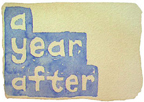
Northern Solstice Marks One Year Duration
1001 nights cast is one year old today, the northern summer solstice. To mark the occasion Barbara Campbell, the artist, invited Anne Brennan to co-write the story, as she and Campbell did the very first story.
Each morning Barbara reads newspaper reports covering events in the Middle East. She selects a prompt word or phrase that leaps from the page with generative potential. She renders the prompt in watercolour and posts it to the site.
Last year's prompt "the challenge of healing"; the prompt source was The Associated Press, 'Opposition wins vote in Lebanon', International Herald Tribune online, 21/06/05. Today's prompt was "a year after"; the prompt source: Ewen MacAskill and Simon Tisdall, 'A year on, Ahmadinejad's popularity is soaring', Guardian Unlimited, 21/06/06.
At the beginning of each webcast Barbara reveals the performance number stamped onto an individually-crafted tongue stud.
Posted by jo at 03:31 PM | Comments (0)
Sound Visions exhibition
Sound is image is sound is image
Contemporary experience's conversion to digital is undeniable, the nomadic aspect of (new) technologies has become complete ubiquity and today everything can be thought of as zeros and ones, as information in its most abstract and immaterial version. Having that in mind what happens to the apparently ontological difference between sound and image, audition and vision?
Sound Visions intends to show this crumbling down of the differences between these two distinct modes of acess to reality. André Gonçalves and André Sier work from that place where it is impossible to define where one strats and the other ends. They use each one of those modes to stimulate the other, causing a generalized undefinition, from which it is no longer possible to tell what is cause and what is effect, if it the sound generating the images or if it is the images that are causing the sounds. The spiral is endless, sound is generating images that generates sound that again generates new images. the system replicates itself, always in interaction with the audience, pulled into the vortex of events taking place.
Sound Visions is a project developed specifically by the Upgrade! Lisbon for the Village Festival.
Sound Visions
Andre Goncalves/Andre Sier
Sala do Risco
June 16 - July 15
Tuesdays to Sundays, 10h00-19h00
For more info please go to
http://www.lisboa20.pt/upgrade
http://www.undotw.org/ctrl/fotos/xtras/lr/LR.htm
http://www.s373.net/babel/struct_5_060616_3.mov
Posted by luis at 10:59 AM | Comments (0)
Visual Complexity
![]()
Upgrade! Lisbon meeting featuring Manuel Lima
Teatro S. Luiz welcomes next Thursday, June 22nd@20:00, The Upgrade! Lisbon monthly gathering featuring Manuel Lima, who will present his project Visual Complexity. The entrance is free and drinks will be served.
VisualComplexity.com intends to be a unified resource space for anyone interested in the visualization of complex networks. The project's main goal is to leverage a critical understanding of different visualization methods, across a series of disciplines, as diverse as Biology, Social Networks or the World Wide Web. I truly hope this space can inspire, motivate and enlighten any person doing research on this field.
Not all projects shown here are genuine complex networks, in the sense that they aren’t necessarily at the edge of chaos, or show an irregular and systematic degree of connectivity. However, the projects that apparently skip this class were chosen for two important reasons. They either provide advancement in terms of visual depiction techniques/methods or show conceptual uniqueness and originality in the choice of a subject. Nevertheless, all projects have one trait in common: the whole is always more than the sum of its parts.
Complexity is a challenge by itself. Complex Networks are everywhere. It is a structural and organizational principle that reaches almost every field we can think of, from genes to power systems, from food webs to market shares. Paraphrasing Albert Barabasi, one of the leading researchers in this area, “the mistery of life begins with the intricate web of interactions, integrating the millions of molecules within each organism”. Humans, since their birth, experience the effect of networks every day, from large complex systems like transportation routes and communication networks, to less conscious interactions, common in social networks.
Scale-Free networks, one of the most common topology in either natural or human systems, is curiously enough, a very recent breakthrough. Since its discovery, in 1999, dozens of researchers worldwide have been disentangling the networks around us at an amazing rate. This awareness is helping us understand not only the world around us but also the most intricate web of interactions that shape the human body. The global effort of constructing a general theory of complexity is tremendous and may lead us, not only to a structural understanding of networks, but to major improvements in stability, robustness and security of most complex systems around the globe. Like Barabasi refers in Linked, “Once we stumble across the right vision of complexity, it will take little to bring it to fruition. When that will happen is one of the mysteries that keeps many of us going”.
Manuel Lima was born in the Azores, Portugal, in May 1978. In 2002 he completed a 6 year degree in Industrial Design at the Faculty of Architecture - UTL Lisbon and finished a 7 month internship at the design firm Kontrapunkt, in Copenhagen, Denmark. Currently living in New York, Manuel is a recent MFA graduate from the Design+Technology program at Parsons School of Design. For this purpose he received scholarships from Calouste Gulbenkian Foundation, the Luso-American Foundation and a Dean's scholarship from Parsons School of Design.
During the course of the MFA program Manuel was part of a Collaboration Studio with Siemens Corporate Research Center, worked for the American Museum of Moving Image and Parsons Institute for Information Mapping in research projects for the National Geo-Spatial Intelligence Agency. Manuel is currently working as an interaction designer at R/GA Interactive and teaches Information Design at Parsons Design+Management department.
Posted by luis at 10:11 AM | Comments (0)
Sketcher

Grafitting the web
Sketcher is a firefox extension that allows you to draw graphic comments over web pages. You can link 'sketches' to other 'sketches', webpages or files, organize sketches by topic and add in-line comments. A tool for web-research. Or for grafitting the web.
For a Quick Start visit the Getting Started Chapter on the Help menu
'Sketcher' was a Gonçalo Tavares idea, awarded by Atmosferas 'criação digital' competition.
Credits
Made by: Atmosferas, Digital Arts Center
A project by Gonçalo Tavares
Producer: Sofia Oliveira (Atmosferas)
Developers: Pedro Afonso, Hugo Barbosa
Posted by luis at 10:02 AM | Comments (0)
June 20, 2006
Floating Points:

Locative Media, Perspective, Flight
The primary concern in locative media has been, understandably, location. This has been a great new leap in terms of art, technology, science and narrative. Locative Media Art consists of artworks utilizing locative technology to trigger artworks in a specific physical space.
Locative media art goes back to early experiments such as Telepresent by Steven Wilson in 1997 that was an object equipped with GPS left to be communally interacted with and moved while continually sending images via the Internet.
Another key development was the GPS drawings of Jeremy Wood in 2000 in which he discovered that by tracing his movements as he drove or walked with GPS that he could form shapes formed by the sequence of plotted movements. Other projects worked with Geo-Annotation which placed a comment or reflection on a physical location (similar to what hikers for years would do at posted signs on certain trails). Then came the project 34 North 118 West that was the first locative narrative.
34 North 118 West was a mapping of a four block area of Los Angeles where the primary non-passenger rail yard and related infrastructure at the turn of the last century and the original grand passenger station of Los Angeles (La Grande station) once stood. The majority of the buildings are the same but have changed in usage in time, state of disrepair and who has come to live and work in them in waves of development and housing.
Other buildings were destroyed over the years and only the ghosts of historical information and personal accounts remain. The project created a "narrative archaeology" as the layers in time were to be agitated into being. In one place would be narrativized data from 1936 a few hundred feet from a spot before a building that triggered something from 1910.
Now groups such as the C5 collective are doing work such as the GPS mapping of the entire great wall of china and then placing the coordinates in another location. This type of work creates a layered commentary and plays with form and semiotics as well as referencing the Situationists who developed absurd commentaries like a walk through the streets of Paris following a map of another city..." Continue reading Floating Points: Locative Media, Perspective, Flight and the International Space Station by Jeremy Hight with Alexander van Dijk, Hz Journal, #8, June 2006.
Posted by jo at 09:46 AM | Comments (0)
June 16, 2006
Mapping System/Bird's Eye View

Overlapping of city space and web space
[posted by Yukihiko YOSHIDA] Collaboration of Performance Artist and Mapping System / Media Art Team Un-simultaneous / Tokyo: Hidenori Watanabe (photon.co); Yukihiko Yoshida (dance critic, digital community); Taro Nishimoto (artist, director); and Kazuho Kimura (editor, "Save the Shimokitazawa").
We are taking a lot of pictures of "Image of the city" and archiving them in the web-space now. Moreover, we can plot them on the map of Google Earth/Maps automatically or manually, by using "Mapping System".
Now, we can experience both of bird's eye view/overall aspect and looking up/personal aspect with a familiar tool. A new interpretation to the city will come to the consideration field when individual's aspect are overlapped in the bird's-eye view. But, it is necessary to set the theme "Of what do you take a picture?" to derive a persuasive result of workshop.
The collaboration with the performance artists is planned in this workshop. It is a collaboration of Artists who do the expression activity by a personal body and "Mapping system", the tool of bird's-eye view.
Let's think about "Overlapping of city space and web space", "New interpretation method of city space", through walking in the town, taking a picture, and mapping.
Please prepare the camera phone with the GPS function or Digital camera and GPS device if possible when you participate.
"Mapping system" is developed by Photon, Inc. Please refer to "Sakura Mapping Project" project. (Green Photon + Executive committee of Earth Day Tokyo). http://mapping.jp
Posted by jo at 08:59 AM | Comments (0)
transmediale 2007
![]()
Call for Competition, Festival, Club
transmediale.07: festival for art and digital culture berlin :: 31 January - 4 February 2007 :: club transmediale.07: international festival for electronic music and related visual arts :: 26 January - 3 February 2007. Call for Entries: :: Deadline: 8 September 2006 :: Award Ceremony: 3 February 2007.
transmediale.07 Award Competition: transmediale - festival for art and digital culture berlin, invites submissions for its Award Competition 2007. The competition highlights outstanding contemporary artistic positions in digital media art. The international jury will award one main prize of EUR 4.000, and two second prizes of EUR 2.000 each.
The transmediale award is a major international award for art reflecting on the aesthetical and cultural impact of new technologies. Previous award winners have included renowned artists like Shilpa Gupta (in), Zhou Hongxiang (cn), Istvan Kantor (ca), Thomas Koener (de), Agnes Meyer-Brandis (de), Netochka Nezvanova (us), Adrian Ward (uk), schoenerwissen (de), Herwig Weiser (at), 242.pilots (no/pl/us), and others.
As a festival for art and digital culture, transmediale presents advanced artistic positions reflecting on the socio-cultural impact of new technologies. It seeks out artistic practices that not only respond to scientific or technical developments, but that try to shape the way in which we think about and experience these technologies. transmediale understands media technologies as cultural techniques which need to be embraced in order to comprehend, critique, and shape our contemporary society.
Digital media are increasingly used by artists of all disciplines to express their ideas and to explore new aesthetic territories and the relation between art and technology. What is important for transmediale, though, is that the artistic practices do not only make use of technologies, but that they imply a reflection about the aesthetic, cultural and social dimensions of such technological developments. transmediale and its competition promote an understanding of media art as a sounding board and catalyst for a critical and creative expansion of the potential of human agency through new technologies.
We invite the submission of works and projects that respond to this challenge. We are interested in works that expand our understanding of digital image and sound aesthetics, of narrative, of interactivity and, in particular, the cultural significance of software and computer programming as cultural techniques. However, we are also curious to see the submission of works outside of these areas, works that expand our notions of artistic practice, and works which can makea strong argument for the crucial role that new technologies play in our perception and projection of a contemporary global culture.
Together with the jury, we explicitly welcome submissions from artists who live and work outside of Western Europe and North America.
transmediale is hosted by Berliner Kulturveranstaltungs-GmbH in cooperation with Akademie der Kuenste. Funded by the German Federal Cultural Foundation.
club transmediale (CTM) - festival for adventurous music and related visual arts - takes place in conjunction with the transmediale. CTM is an independent platform for new forms of electronic and experimental music and for the various artistic activity drawing infl uences from and refering to sound- and club culture. It presents outstanding productions in digital, electronic and experimental music, audio-visual performance and installation.
CTM reflects on the role of contemporary music culture as a changing agent for present society and - due to the massive dissemination of music - as one of the key elements to shape the transformation processes that characterise todays mediasphere. With a focus on the exploration of performative concepts, informal networks and the interaction between different media formats - especially of image and sound - CTM emphasises the situative potential of live music and performance. Thus it encourages the crossover of institutional, academic and subcultural contexts.
club transmediale invites the submission of works and projects in the fields of digital, electronic and experimental music, audiovisual performance, sound art, installation, video-performance/VJing, music video and of design concepts aimed to shape social situations and communication processes related to music culture.
Posted by jo at 08:40 AM | Comments (0)
III INTERNATIONAL FESTIVAL OF ELECTRONIC ART 404
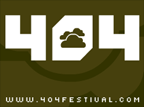
2006 CALL :: Deadline: August 15th 2006
Astas Romas is organising the III International Festival of Electronic Art 404, to be held at Plaza Cívica and Centro Cultural Parque de España, in Rosario, Argentina from November 30 -- December 3, 2006. The event is dedicated to Mark Lawton.
"Astas Romas" is making a world-wide call to artists and theorists to participate in this third "Festival 404" in order to estimulate and divulge new productions around electronic art. Authors may participate in the following areas: Net-art, Still image, Animation, Video, Music, Audio-visual set, Theory, Performance, Installation. The program includes screening of videos and animations, conferences, performances and concerts.
Participation in this festival is free. There are no age or nationality limits.
The Festival's deadline to present works is on August 15th 2006. The date will be taken from the post office cancelling stamp. To submit your work, please follow the instructions published on www.404festival.com
INSTRUCTIONS FOR SUBMISSION
To submit your work you may have to:
1) Read the Participation Terms published at www.404festival.com
2) Complete and print the Inscription Form.
3) Send and envelope including the things mentioned in the Form.
4) Send the envelope to the following address:
III INTERNATIONAL FESTIVAL OF ELECTRONIC ART 404 /ASTAS ROMAS
Universidad Nacional de Rosario / Centro de Estudios Canadienses
Maipú 1065, Of. 208
(2000) Rosario
Santa Fe
Argentina
Posted by jo at 08:21 AM | Comments (0)
Listening and Space
Disjunction: Visual | Aural
Bernard Tschumi, in writings between 1975 and 1991, articulated what he called a “disjunction” in the field of architecture between the form of buildings and the events that take place within them. This contradiction might be substituted by any from a set of related contradictions (theory/practice, ideal space/ real space, object/ subject), including one that in a certain sense suggests each of the others – between the visual and the aural.
Any essay that proposes to discuss sound usually begins by cataloguing the injustices done to listening, as a result of centuries of neglect by vision-inclined philosophers and art historians. Usually, this catalogue slips into a new set of oppositions, reversed so that listening becomes the mode of perception that brings us closer to the truth of existence. Reading this literature, I am reminded of the workers, in the film Brazil, who share a desk that penetrates the wall between their respective offices - they alternately nudge, hold, and yank the desk, such that the gain of one man is at the direct expense of the other. It sometimes seems as if perception is a kind of zero-sum game: territory claimed by the proponents of sound methodically excludes vision, as if hearing and sight exhausted the human sensorium. What follows are a series of oppositions between listening (on the left) and vision (on the right) that come out of these debates:
spherical--directional
immersive--perspectival
inward--outward
interiors--surfaces
contact--distance
subjectivity--objectivity
life--atrophy and death
affect--intellect
temporal--spatial
magic--neutral
(Jonathan Sterne, summarizing Walter Ong. in The Audible Past., 15)
The purpose of this essay is to move beyond such facile (and misleading) oppositions by applying three writings on vision or listening that explicitly or implicitly open one up onto the other: Don Ihde's Listening and Voice; “'The Element of Voluminousness': Depth and Place Re-examined” by Edward Casey; and Norman Bryson's “The Gaze in the Expanded Field.” My goal is not to reduce the particularities of seeing and hearing to an indistinguishable sameness, but rather, to use the spirit of the aforementioned writings to discuss several examples that bring the act of listening into focus. The necessary obverse of this inquiry is to also describe what happens to the act of seeing." From Listening and Space by Sean Dockray.
Sean Dockray is an artist who lives and works in Los Angeles. His work includes interactive installations, video, writing, architecture, radio broadcasts, data visualization, performative lectures, and computer programming. With a focus on social systems, time, and impermanence, Dockray’s practice often emphasizes an active, critical engagement with technology. He is a member of the research group the Institute for Advanced Architecture, one of the directors of Telic Arts Exchange, a media art gallery, and a partner of the newly formed design collaborative MARKET. Between a BSE in Civil Engineering and Architecture from Princeton University and an MFA from UCLA (Design|Media Arts), Dockray worked for Plumb Design in New York and consulted for a variety of cultural producers including Laura Kurgan Architecture, the Center for Land Use Interpretation, the Not a Cornfield public artwork, and the Milosevic trial video archive. Presently, he lectures at the Department of Design | Media Arts at the University of California in Los Angeles and writes for various publications on art, culture, and design.
Posted by jo at 08:15 AM | Comments (0)
June 15, 2006
Flickr Cracks Down on Screenshots
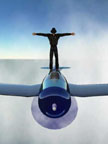
Online Worlds Collide
"Online worlds collide as Second Life fans and Flickr spar over how to handle screenshots on the popular photo-sharing site. At stake is a little-known Flickr policy of flagging accounts that contain mostly non-photographic images and preventing images from those accounts from appearing in public areas of the site, including search. As a result, many screenshots on Flickr are AWOL -- at least as far as the general public is concerned. That's angering and confusing some of the people who carefully stage scenes in the popular virtual world and religiously post the results online. "I Hate Flickr" is the title of one blog post on the topic." From Flickr Cracks Down on Screenshots by Kathleen Craig, Wired.
Posted by jo at 04:59 PM | Comments (0)
Mike Pearson and Mike Brooks
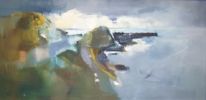
In Comes I + Zero Minus One
In Comes I: Performance, Memory and Landscape by Mike Pearson: In Comes I is about performance and land, biography and locality, memory and place. The book reflects on performances past and present, taking the form of a series of excursions in the agricultural landscape of eastern England, and drawing from archaeology, geomorphology, folklore, local and family history.
Mike Pearson, a leading theatre artist and solo-performer, returns to the landscape of his childhood-off the beaten track in Lincolnshire-and uses it as a mnemonic to reflect widely upon performance theory and practice. Rather than focusing on author, period and genre as is conventional in the study of drama, the book takes region as its optic, acknowledging the affective ties between people and place.
Offering new approaches to the study of performance, he integrates intensely personal narrative with analytical reflection, juxtaposing anecdote with theoretical insight, dramatic text with interdisciplinary perception. The performances, ranging from folk drama to contemporary site-specific work, are seen in their relationship to their cultural and physical environment. 272p, c. 40 b/w photos and map (University of Exeter Press 2006)
Zero minus One: The appropriation of existing and emerging technologies and their influence on performance practice’ by Mike Pearson, PARIP 2005--International Conference | 29 June - 03 July 2005.
"Workshop Abstract: The relationship between performance and technology can be traced back to the origins of human communication and interaction. Within the field of theatre, performance and live art, many practitioners have explored this relationship, using technology as a tool, to play with our perceptions and reflect on our lives (e.g., Fluxus, ‘body artists’ such as Acconci; experimental theatre companies such as the Wooster Group and the works of Wilson and Lepage). Alongside this, cyber-oriented artists such as Orlan and Sterlarc have extended this work by actively creating an ongoing performative dialogue between corporality and cybernetics.
In further developing the visceral body through the use of technical and digital tools, Orlan and Sterlarc re-examined the mutuality between the individual, the sociocultural and the biological. New emerging technologies continually challenge this triad. Pervasive platforms such as mobile telephony, locative media and massively multiple online game (MMOG) technologies, provide new performative forms and experiences. Consequently our notions of the spaces and places around, through and within which performance occurs are persistently pushed as virtual, parallel timelines become everyday practices. Alongside these openings, the role of the ‘audience’ continually shifts as they become actively involved, even co-participants within the performance.
As contemporary practitioners working in this field we persistently struggle to adequately articulate our practices and theoretical locate our work. In attempting to explore the different theoretical perspectives emerging within this field, this workshop brings together practitioners in the field of digital performance. Common across our practice is the appropriation and redesigning of existing and emerging technologies for performative purposes. From a theoretical perspective we draw on sociocultural psychological theory; cultural, film and new media theory; cyber theory, robotics and anthropology.
In order to adequately discuss this area, we have chosen the workshop format as a means through which to explore key research questions. Each participant will present their perspective, from which an open discussion with those attending will follow. Our discussions will be augmented with extracts for our work in this area. The open discussion format will explore in more detail convergences, divergences, connections and slippages within this field. The aim of the workshop is to distil a set of methodological principles, which we consider best articulates our practice and future trends within this area. The workshop will specifically address the following questions:
1. How are new emerging technologies (virtual, haptic, tangible, mobile technologies, robotics) incorporated into performance and how do they reorganise and reconstruct our notion of performance and performativity?
2. What kinds of terminology and methodologies are useful for discussing the design of new techno-performative tools and how does their design relate to existing approaches within other disciplines?
3. How does the appropriation and creation of new techno-performative tools extend the performers’ body and mediate or signify their intentions?
4. How do techno-performative tools change the spatial and temporal dimensionality of the performance – what kinds of experiences do they afford and constrain?
5. Within new digital performances what kinds of relationships and transactions emerge e.g. audience and or performer as spectator, witness, collaborators etc?"
Session abstract: Who are you looking at? by Mike Pearson and Mike Brookes
Since 2001 Pearson/Brookes has created a series of multi-site performance works, including Carrying Lyn (Cardiff, 2001), Polis (Cardiff, 2001), Metropolitan Motions (Frankfurt, 2002) and There's someone in the house (Exeter, 2004).
Within these works actions are staged at dispersed locations in the urban environment - often within the public domain - and recorded on low grade technology: tapes and discs are then returned immediately to a venue now rendered porous. Here the record of what happened ‘out there, ‘just now’ is assembled, ordered dramaturgically and replayed.
The works pose a number of questions. As each performance is generated in a number of places, often simultaneously, is co-presence any longer a useful definition of performance? Where is this performance actually happening? And is the feedback loop of action/response/ readjustment any longer an essential feature of performance? How many audiences are there here?
The document has repositioned itself within the performance rather than being a ‘post-event’ phenomenon. Is the audience already watching a document? And as the work remains resolutely analogue - transporting physical objects that then have to be rewound/lined up - time itself is troubled. When did this happen?
Mike Pearson and Mike Brookes present an overview of the series and the issues it raises - not least of distinctions between professional practice and scholarly practice in the field of ‘practice-as-research’.
They introduce developing DVD-ROM work, created by Mike Brookes, presenting strategies through which he is attempting to appropriately reconstitute the material of these events – within the form and limits of this alternative media - whilst embodying the original propositions of that material. The intention being to allow a direct encounter with the work - its structure, accumulation and consequences - rather than to reproduce any particular view of the physical and ambient constructs on which that encounter originally stood.
[via nicholas_senn, Critical Spatial Practice]
Posted by jo at 03:35 PM | Comments (0)
Autotopography:
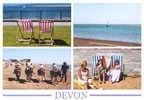
Graffiti, Landscapes & Selves
Dee E. Heddon's essay discusses the ways in which subjectivity and place converge in the practice of "Autotopography" or the writing of oneself in and on the landscape. Her discussion of graffiti, as it appears scattered throughout the landscape, marks the passage of subjects through the environment as it teases out elements of her own subjectivity. Heddon's process of narativizing space, time, and self tells a fascinating tale of appearing and disappearing identities hidden in the cracks and crevices of everyday life.
"...For some time now I have been interested in autobiographical performance -- some form of the theatrical, in which performers explicitly use personal material in their work. Within this general field of autobiography and performance, one area of research concerns performances that are dependent on being located in personalised space -- what could be called, then, site-specific autobiographical performance. A recent example of this would be the performance Bubbling Tom (2000), by the UK based performer Mike Pearson, which saw Pearson return to the village of his childhood, to reflect upon and re-enact certain memories, events and persons associated with his five year old self, in that place..." Autotopography: Graffiti, Landscapes & Selves by Deirdre E. Heddon.
Posted by jo at 03:24 PM | Comments (0)
Cinema-Scope Hamptons

Last Minute Call for Video and New Media
Cinema-Scope Hamptons: Deadline: Monday July 3, 2006 -- (FUTURE PERFECT) The future perfect is used to describe an event that has not yet happened but is expected or planned to happen.
"Think of it. We are blessed with technology that would be indescribable to our forefathers. We have the wherewithal, the know-it-all to feed everybody, clothe everybody, and give every human on Earth a chance. We know now what we could never have known before -- that we now have the option for all humanity to make it successfully on this planet in this lifetime. Whether it is to be Utopia or Oblivion will be a touch-and-go relay race right up to the final moment." BUCKMINSTER FULLER, Critical Path
This year in the Hamptons we will have an impressive video art complex featuring some really top notch international artists striving to be ahead of the curve. We will also be featuring the new and improved "Perpetual Art Machine" interactive video installation. (sign up its free)
We are looking for additional screen based videos (HD and SD) no longer than 10 minutes and computer based new media projects, websites, vblogs and anything else that you would consider to be art on a computer.
All projects must have been created after 2001.
Video Requirements: Quicktime (.mov) or NTSC video DVD
New Media Requirement: Internet URL or Stand alone MAC formatted applications (Special thanks to Tekserve NYC for sponsoring us with the Cinema-scope MAC New Media Gallery)
Deadline: All work must arrive by Monday July 3, 2006. Late entries will not be accepted
Please send your entry to:
Lee Wells / Cinema-scope
Scope Art Fair
521 West 26th Street
New York, NY 10001
Please have disk and materials properly marked with artist name and artwork information.
Please include a self addressed stamped envelope if you would like your entry returned.
Please contact Lee Wells for further details by email lee[at]leewells.org or by phone at 917 723 2524.
Posted by jo at 02:58 PM | Comments (0)
Haque Design + Research
![]()
News
1. Configurable T-shirt (an experiment to make a low tech 'open' system...)
The Configurable T-shirt, on sale in Japan, enables the wearer to configure the design on the front of the shirt. A matrix of hexagonal pixels is provided that can be coloured in with a black permanent pen in order to turn them "off". Designed for the T-1 World Cup competition, which came about because I couldn't decide on a country to support in the World cup.... available for one month only here; a web interface for prototyping and sharing t-shirt designs is available here.
2. Talks in Tokyo, June 17 and 21
If you are near Tokyo in the next week, drop by and say hello... I will be at NTT ICC's "Open Creation" symposium on June 17 and the Device Art Symposium, Crossfield UDX on June 21.
3. Exhibition in São Paulo, Brazil
Evolving Sonic Environment (a spatialised neural net project with Rob Davis) will be part of Emoção Art.ficial 3.0 - Interface Cibernética, São Paulo, Brazil, July 19 to September 24, 2006. We will also have a panel discussion on Gordon Pask's immense contribution to the design of authentically interactive systems.
4. Wifi camera obscura
An experiment with Aether Architecture and Bengt Sjölén to reveal the electromagnetic "view" of 2.4GHz (that analogises the way that a traditional camera obscura works with visible light in order to reveal the ways that wifi may "illuminate" a space) will appear at Waves, RIXC, Latvia, August 24-September 17, 2006. Details to come later.
5. Open Burble
A new project to be launched for the opening of the Singapore Biennale in September 2006. Details to come, but for the moment imagine Sky Ear only BIGGER!
Posted by jo at 02:45 PM | Comments (0)
Waag Society: 10 Years

Waag Bazaar
On the 21st of June it will be 10 years ago that Waag Society opened the doors of the Waag building that had been vacant for several years. A lot has happened since then. Waag Society evolved into an international acknowledged institution where technology is connected to social and cultural issues.
To celebrate our 10th anniversary there will be a Waag Bazaar on the 21st of June with music, performances, installations, debates, art, and a number of our projects. The program starts at 1.00 PM and ends with a debate at 6.00 PM.
The program in the restaurant contains the Storytelling table, a Lock-picker workshop by Toools, Robot Mobi, The Robot Vodka Bar, Neighborhood Cinema, The Animation Table, Simuze performances, the ScratchWorx console with VJ/DJ workshops and more.
On the first floor a real Waag museum will be open for that day with projects from the past and the present: storytelling activities, keyworx installation and connected experiments.
During the day several debates will take place in the Theatrum Anatomicum; topics range from the Nieuwmarkt neighborhood, Creative cities and the 'Ars Combinatoire'. All discussions will be in Dutch.
We invite you all..
where: Waag building, Nieuwmarkt 4, 1012CR Amsterdam
when: 21st of June, 1.00 PM - 7.00 PM
stream: http://connect.waag.org
Posted by jo at 02:37 PM | Comments (0)
Month Of Sundays Live A/V Internet Mixing - 25th June
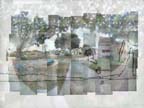
Two Sites, Two Cities
FurtherNoise.org Presents: Month Of Sundays Live A/V Internet Mixing. Featuring John Kannenberg & Glenn Bach. Open Mix led by Ruth Catlow & Marc Garrett (Furtherfield & HTTP). Post performance soundscapes by Alex Young (Furthernoise). Date & Time: 16.00 - 18.00 hrs BST; Where: E:vent - 96 Teesdale Street, London E2 6PU.
As part of the Month Of Sundays series of live A/V internet performances Furthernoise.org is hosting this unique event featuring a cross continent A/V performance by Chicago based John Kannenberg mixing in real time with Glenn Bach who will be performing from his home in Long Beach, California. The performance is based on their Two Cities project, which began in 2003 using sounds, photos, objects and data collected on Glenn and John's daily walking commutes to compare and contrast the environments of their respective hometowns.
It will take place in the online file mixing platform Visitors Studio
and projected, amplified into the gallery space from www.visitorsstudio.org
Come and join us at E:vent: Bring your laptops and media files and collaborate. Following the performance, Furtherfield artists Ruth Catlow & Marc Garrett will lead an open mix where audiences both online and in the gallery can join in by uploading and mixing their own audio & visual files in an open collaborative mix. Files can be mp3, swf, flv and jpg and must be a maximum of 2OOK.
There will also be free refreshments and post performance Soundcapes by Alex Young who's album 'Helicoids' is the new net release on Furthernoise.org.
As well as being shown at E:vent, the afternoons performances will be also broadcast, in real-time, online:- at The Watershed Media Centre, Bristol. The Point CDC Theatre, New York.
Curated by Roger Mills. Furthernoise & Visitors Studio are Furtherfield.org projects, supported by Arts Council England.
BIOGRAPHIES
Chicago-based sonic and visual artist John Kannenberg works with a variety of themes including primal natural forces, spirituality and mindful contemplation, melancholy and nostalgia, abstracted narrative tales, and the confluence of sonic and visual art. His major appearances include the Spark Festival 2006 (Minneapolis), so.cal.sonic 2005 (Long Beach), ISEA 2004 (Tallinn), and the Placard Festival 2003 (New York). John is the creator and curator of Stasisfield.com, an experimental music label and digital art space presenting works by a diverse collection of artists from around the globe.
Based in Long Beach, California, Glenn Bach is an active multidisiciplinary artist influenced by the act of mindful walking and environmental sound, Bach has performed at Field Effects (San Francisco), the Big Sur Experimental Music Festival, and the Schick Art Gallery (Saratoga Springs, NY) and has curated a house concert series, Quiet (2003), the week-long so.cal.sonic festival (2005) and is the founder of the research group Pedestrian Culture. His current project is a poem sequence, Atlas Peripatetic, inspired by an extensive mapping of sounds on his morning walk.
Ruth Catlow is an artist and works as co director of Furtherfield, formed and run in partnership with artist, Marc Garrett since 1997. Ruth works with networked media in public physical spaces and on the Internet. exploring net art with new communities (of artists and audiences) with less reliance on existing, traditional art world hierarchies, developing independent grass-roots expression and representation. She is exploring the potential of current network technology for promoting distributed creativity which raises a whole series of issues by giving rise to a more permeable boundary between established arbiters of culture, artists and audiences radically changing the life of the artwork in the world, and the ways in which people come across it.
Marc Garrett is an Internet artist, writer, street artist, activist, curator, educationalist and musician. In a constant state of being renascent. He share's no allegiance to any one form of art or expression. 'For me, art, or rather creativity, is an intuitive strategy that involves learning, questioning, progressive thought and putting playful explorations into action'. Emerging in the late 80's from the streets exploring creativity via agit-art tactics, Marc declares his own and humanity's seemingly perpetual dysfunction. Consciously using unofficial platforms such as the streets, pirate radio, net broadcasts, BBS systems, performance, intervention, events, pamphlets, warehouses and gallery spaces. In the early nineties he was co-sysop with Heath Bunting for Cybercafe BBS.
Posted by jo at 02:26 PM | Comments (0)
Urban Konsumterror
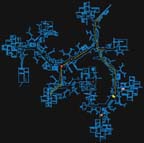
Signature architecture konsumterror
Konsumterror is a concept coined by Ulrike Meinhof in defense of the Red Army Faction’s use of terrorism. For Meinhof, the real terror is late capitalism’s constant demand that we always consume more. Pac-Man demonstrates the relentless logic of Konsumterror. Like the late-capitalist subject, Pac-Man feels no hunger but can’t stop consuming. Pac-Man opens and closes his mouth insipidly, eating everything in his path. Everything tastes the same for him; his mouth is his only organ. The point of Pac-Man is to consume enough that the game never ends.
Architectural Pac-Man: Urban Konsumterror is a critique of the condition of architecture in the contemporary city. The use of signature architecture to draw in tourist dollars is nothing more than a game of architectural Pac-Man. Signature architecture begins by consuming the museum: in order to build more and more, funds for exhibits or even routine maintenance are cannibalized.
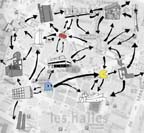
When buildings fall apart as a result, they can be torn down and new ones can be built. Cities also become consumed. When you say 'Bilbao,' you refer to a building by Frank Gehry. The city’s identity no longer matters. All imaginative and financial capacity for real urban interventions is consumed by signature architecture.
The End of the Game: Konsumterror creates a perpetual crisis both for the individual and for architecture: like Pac-Man, the game can end only when you lose. You can play again, but you will lose again. Eventually you run out of quarters or get bored and give up.
Would you like to play again?" [blogged by Anne on Space and Culture]
Posted by jo at 08:59 AM | Comments (0)
Doing Virtually Nothing

Awareness and Accountability in MM Online Worlds
"Abstract: To date the most popular and sophisticated types of virtual worlds can be found in the area of video gaming, especially in the genre of Massively Multiplayer Online Role Playing Games (MMORPG). Game developers have made great strides in achieving game worlds that look and feel increasingly realistic. However, despite these achievements in the visual realism of virtual game worlds, they are much less sophisticated when it comes to modeling face-to-face interaction. In face-to-face, ordinary social activities are “accountable,” that is, people use a variety of kinds of observational information about what others are doing in order to make sense of others’ actions and to tightly coordinate their own actions with others.
Such information includes: (1) the real-time unfolding of turns-at-talk; (2) the observability of embodied activities; and (3) the direction of eye gaze for the purpose of gesturing. But despite the fact that today’s games provide virtual bodies, or “avatars,” for players to control, these avatars display much less information about players’ current state than real bodies do. In this paper, we discuss the impact of the lack of each type of information on players’ ability to tightly coordinate their activities and offer guidelines for improving coordination and, ultimately, the players’ social experience." From Doing Virtually Nothing: Awareness and Accountability in Massively Multiplayer Online Worlds by Robert J. Moore , Nicolas Ducheneaut and Eric Nickell. [via pasta and vinegar]
Posted by jo at 08:33 AM | Comments (0)
June 14, 2006
SpacePlace

Art in the Age of Orbitization - Gotchi Universe
SpacePlace is in Net vernacular, a 'Mashup,' a collection of data configured by Philip Pocock that is based on Web2.0 applications and strategies and that contains information from different spheres of artistic production relating to notions of orbit. The database of the project comprises contents from fields such as fine art, architecture, science fiction, film, music, digital arts or media. Currently, more than 400 entries on Orbit Art, ranging from, for example, projects by artists such as Marina Abramovic, Nam June Paik, Woody Vasulka or Arthur Woods, can be accessed in this constantly growing data pool, open to all SpacePlace member entries.
Both via the project's website and via mobile phones, users can navigate the database or upload texts and images to this universe and thus collectively create its contents and structure.
The ZKMax functions as display and space of interaction as the current status of the SpacePlace project is made visible and audible on two large projections screens: One screen serves as a forum for interaction offering the possibility to explore the data pool as well as to add new information via many mobile phones with free public access Bluetooth protocol. The second projection syncs with selections made by the public on the first projection, and plays them as an «Audio Wobble Movie:» images and video 'wobbling' fluidly to the sound of incoming RSS newsfeeds from webblogs and Net sources concerning science and art in outer space.
The soundtrack, the result of text-to-speech synthesis of online information, is narrated by an artificial computer-generated voice, over an added track of the 'sounds of space,' a radio feed that 'listens' to what scientists are studying with radio telescopes in real time. This audio controls the generation and spacial distortion of still photo and video sequences retrieved from the data pool by guests in ZKMax. The visitors experience the terrestrial simulation of an orbital artwork. This Bluetooth interface is local to ZKMax, yet simulates a sort of 'ground station' of inquiry into Space Art by guests acting as orbitants.
Posted by jo at 05:41 PM | Comments (0)
INTERVIEW: LOREN CHASSE
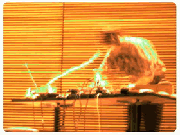
PHOTOGRAPHING ACOUSTIC SPACES
"The American Loren Chasse is one of the most important international artists working in the areas of environment and sound. His ability to listen and to transform an object into “musical instrument” is the most identifying feature of his work.
If field recordings are more and more common in “experimental” music, then Loren Chasse does not only have a different way of using sound, but he manages to “photograph” with his microphone the acoustic spaces in which he works.
Chasse shifts the traditional frontier of art by blurring the differences between music and sound art, if it can even be assumed that they exist. Beyond his activities as a musician and his several collaborations, he is a teacher in the San Francisco School District where he organizes workshops on skilled and creative listening." From INTERVIEW: LOREN CHASSE, PHOTOGRAPHING ACOUSTIC SPACES by Luca Bergero. This text is republished in collaboration with Digicult.it. It was released on March 2006, and has been edited for republication on newmediaFIX.
Posted by jo at 05:22 PM | Comments (0)
Urban Picture:
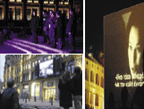
The Moving Image in the Public Environment
Urban Picture: The Moving Image in the Public Environment; July 6th, 2006; Lewis Media Centre, Westminster, London SW1.
With moving image displays becoming a major aspect of the urban landscape The Moving Image in the Public Environment Conference will look at themes of - New Media, Urban Space, Public Sphere, Social Value and Civic Culture in the Urban Environment - and the evolution of new concepts for art in the public realm that demand the use of diverse forms of emergent media. It will focus on the development of digital art, external screens, video projections, media and light festivals in urban settings and will consider the potential for cultural programmes, expansion of audience, different use for city spaces, public art programmes and turning cinemas ‘inside-out’.
Speakers:
Dan Dubowitz, Artist and Director of Civic Works will talk on New media for city wide projects: The Peeps’ for Ancoats, Manchester and ‘Hobo’ for Sunderland. This will be the first time he will speak publicly about ‘the peeps’, a large scale permanent artwork for the public realm developing between 2003-2007 and comprising 15 discreet sites imured (walled in to) in the rebuilt fabric of the city and viewed through peepholes. ‘hobo’ for Sunderland is an itinerant public art work-akin to a festival programme.
Mike Gibbons, Chief Project Manager, Live Events, BBC, will highlight the rapid developments made in outdoor screening in the United Kingdom over recent years, considering emergent technology, new partnerships and the ground breaking Big Screens projects, that are bringing city squares to life.
Shane Walter, Director of leading agency onedotzero, who are celebrating their 10th anniversary this year with a series of international events, will talk about prominent digital artists and groups that are working in the public realm, as well as his own work, and the potential of what can be done.
Amsterdam based Mirijam Struppek, urbanist researcher, consultant and curator of Urban Screens 05 will talk on: The Potential of Outdoor Screens in Urban Society.
Steve Manthorp is coordinator of Digital North, the umbrella body for digital arts organisations across the Northern Way. He completed the installation of the city centre screens in Bradford this year and will discuss how to build culture into a big screen project.
David Gryn, Director, Artprojx, has been holding a number of successful film and video art screenings at the Prince Charles Cinema in Leicester square, and will consider the Potential of Contemporary Visual Art in the Context of the Cinema.
Gini Simpson, Head of Media Arts, SPACE, will focus on the vastly increased demand for new technology by artists and local communities. She will look at means of building audience and participant bases, while linking artists, arts organizations and local communities.
Gill Cooper, Head of Arts and Culture, City of York Council will consider the benefits of Using Digital Media and Light-Based Artists for Public Art Installations in Historic Settingshaving developed stunning public art instillations in the centre of York that used the latest in lighting technology.
Michael Pinsky, a leading contemporary visual artist, has completed an array of commissions in the public realm using video art and digital projections and will discuss his instillations in Doncaster and Darlington.
Lucy Bullivant, architectural curator, author and critic, her latest book Responsive Environments: Architecture, art and design is published by the V&A this year, looks at the use of Electronic Surfaces and Interactivity in Architecture.
Following the success of the sell-out First National Public Art Conference, this event will consider one of the most innovative and major growth areas in this field. Key professional practitioners will explore the potential use of the moving image in the visual arena of our public spaces and the creation of large scale permanent artwork for the public environment. Hear the latest thinking, keep up with recent developments, learn how emergent technologies can be used for diverse cultural programmes and contribute to the debate.
Organised by Art and Architecture Journal
Posted by jo at 02:34 PM | Comments (0)
AIR :: AREA'S IMMEDIATE READING

Test Run
AIR :: AREA'S IMMEDIATE READING is a public, social experiment in which people are invited to use Preemptive Media's portable air monitoring devices to explore their neighborhoods and urban environments for pollution and fossil fuel burning hotspots.
Participants or "carriers" are able to see pollutant levels in their current locations, as well as simultaneously view measurements from the other AIR devices in the network. An on-board GPS unit and digital compass, combined with a database of known pollution sources such as power plants and heavy industries, allow carriers to see their distance from polluters and other AIR devices. In addition, the devices regularly transmit data to a central database allowing for real time data visualization on the website.
Preemptive Media is getting ready to launch AIR in New York City this September. Come help us beta test the devices and data visualization application currently in development on Saturday, June 24, from 1-5pm at Eyebeam Art + Technology Center, New York City. More information on the
workshop and to enroll.
Posted by jo at 01:41 PM | Comments (0)
Landlines Workshop
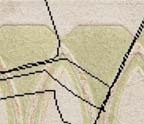
Urban Digital Peel
Artist/Researchers at the University of Huddersfield Centre for Excellence in Digital Design Jen Hamilton and Jen Southern are offering a series of workshops at the Media Centre in Huddersfield next week (June 19 – 23, 2006). The workshop introduces a new technology they call "Landlines".
Landlines uses GPS-enabled mobile phones to notate urban environments. The programmed phone sends images and spatial co-ordinates live to a website. Personal memories of a place, controversial regeneration, and historical are uploaded, and archived as line maps and 'tracked' photographs on a website.
For Hamilton and Southern, these maps can be used to discover what specific places mean to people, and how these places are used. The workshop investigates the correspondence between planning, urban regeneration and design, with the Landlines technology. Workshop is open to all.
Workshop Agenda:
- Introduce the Landlines application;
- Have participants use Landlines to make a map of the area, according to their own specifications and ideas;
- Return to the Media Centre and discuss the maps made by participants, and see individual map notation on-line
- Discuss Landlines potentials; outline and ‘brainstorm’ modifications
‘Landlines’ technology was developed in an artist/industry partnership between Hamilton and Southern and Onteca Ltd, Liverpool, and funded thru a NESTA ‘ITEM’ grant in 2004.
Sign-up Details: There are half-day workshops:
Monday 19 10 am – 1 pm 2 pm – 5 pm
Tuesday 20 10 am – 1 pm 2pm – 5 pm
Wednesday 21 10 am – 1 pm 2pm – 5 pm
Friday 23 10 am – 1 pm 2pm – 5 pm
and ONE full day workshop:
Thursday June 22 10 am – 12 pm 1 pm- 5 pm
All participants please REGISTER!
To do that send an email to: jen[at]24elements.net Include your name, contact phone number, chosen date, and whether you are attending a morning or afternoon session. Minimum group size is 5 people; contact phone number: Jen @ 01484 424862;
All participants will be contacted via email regarding their sign-up. There is no cost to participate in this workshop. For all day workshop (Thursday only) lunch will be provided. Workshop location: The Media Lounge, main floor (enquire at front desk to be directed to room) @The Media Centre 7 Northumberland Street Huddersfield, HD1 1RL Media Centre tel: 0870 990 5000
Posted by jo at 12:49 PM | Comments (0)
Master Study Interface Cultures

Call for Participants
Master Study Interface Cultures at University of Art and Design in Linz Austria; (4 semester)--The Interface Culture masters degree program, founded by media artists Christa Sommerer and Laurent Mignonneau, is an artistic-scientific study to educated media artists and media researchers in creative and innovative interface and interaction design.
The study lasts two years and concentrates on project-oriented and theory-based training in interactive digital media, combining art with research, the development of projects and prototypes with scholarly publication.
Subjects thought include: interactive art, interaction design, game design, tangible interfaces, auditory interfaces, fashionable technologies, wearable devices, intelligent ambiences, sensor technologies, telecommunication and new experimental forms of human-machine, human-human and machine-machine interactions.
Artistic expressions include among others: interactive art, net art, software art, robotic art, sound art, noise art, games and story telling, mobile art as well as new hybrid areas like genetic art, bio art, space art and nano art.
A specialty of the program is its strong collaboration with the Ars Electronica in Linz, where students can show their projects on a yearly basis and thus get in contact with the top experts of the media art and design field. See previous projects of student works at Ars Electronica 2005.
Professors:
Prof. Dr. Christa Sommerer, media artists and researchers
Prof. Dr. Laurent Mignonneau, media artists and researchers
Lecturers:
Dipl.Ing. Martin Kaltenbrunner, Researcher / Ph.D. candidat Dipl. Ing. Christopher Lindinger, Computer Scientist / Media Artist, director of research and innovation of the Ars Electronica Futurelab. Mag. Sabine Seymour, Researcher/Designer in Fashionable Technologies TIMES UP, media art initiative Mag. Andreas Weixler, Composer / Media Artist in Audio-visual interaction
Dr. Sabine Payr, Researcher in multimodal interfaces and e-learning Mag. Gebhart Sengmüller, Artist / Media Archaeologist, VinylVideo Dipl. Ing. Robert Praxmarer, Researcher / Artist, Mag. Simon Bauer, media technician and developer
Entrance Examination: July 6th and 7th 2006
Deadline for Application for Entrance Examination: June 23rd 2006
Application forms can be downloaded at: http://www.ufg.ac.at/portal/DE/zum_studium/studienabteilung/238.html
Please send your filled in application form & required documents (curriculum vitae & passport copy) by June 23 2006 to the study department at:
Study Administration
University of Art and Industrial Design, Linz
Hauptplatz 8, first floor, room 1.24
4010 Linz, Austria
Telephone: 0043/732/7898 Internet: http://www.ufg.ac.at/studienabteilung
studien.office[at]ufg.ac.at
Required materials for the entrance examination on July 6th and 7th 2006
Candidates are asked to bring examples of their digital works and digital productions, for example from their previous studies as well as a copy of their bachelor thesis and any other examples of their practical works as well as an expose (can be in written, image, auditory or interactive form) of what type of work and research they want to conduct during the Interface Culture master study program.
More information about the Interface Culture study at: http://www.interface.ufg.ac.at institut-medien.office@ufg.ac.at
Interface Culture Brochure downloadable at: http://www.ufg.ac.at/files/17282/interface_brochure_6.pdf
Dr. Christa Sommerer
Professor for Interface Culture
Institut for Media
University of Art and Design Linz
Sonnensteinstrasse 11-13
4040, Linz, Austria
Tel: +43-732-7898324
christa.sommerer[at]ufg.ac.at
http://www.interface.ufg.ac.at
http://www.interface.ufg.ac.at/christa-laurent
Posted by jo at 12:43 PM | Comments (0)
Matthew Slaats
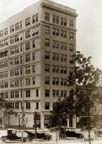
My Name is Madison
Taking Madison, WI as its subject, My Name is Madison is an Augmented Reality Game that allows users to explore and interact with the urban landscape from a multitude of perspectives. This project approachs the city as a layered environment. Players understand the development of place through the eyes of history, culture and fantasy.
Using GPS enabled hand held computers, participants take on the roles of both recipient and creator, performance in context. While walking about the streets, they are provided with information that enhances their understanding of the environment and then gives them the tools to create their own interpretations of place. Documentation of these events will be posted to mynameismadison.
The project opens as a part of the Games, Learning and Society Conference taking place in Madison, WI, June 15-16.
Posted by jo at 12:28 PM | Comments (0)
Christina Kubisch
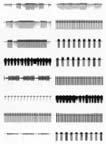
Electrical Walks: Samples of Raw Sounds
In 2003, Berlin-based sound artist Christina Kubisch began an ongoing project called Electrical Walks. This project employs specially built headphones that receive electromagnetic signals from the environment and convert them into sound. Kubisch maps a given territory, noting “hot spots” (ATM machines, security systems, electronic cash registers, subway systems, etc.) where the signals are particularly strong or interesting. She then loans the headphones to the public, allowing participants to undertake an auditory dérive through the invisible network of electromagnetic information.
To date, Kubisch has undertaken her own personal walks in Germany, England, France, Ireland, Japan, Latvia, Sweden, Switzerland, Slovakia, Spain, Taiwan, and the United States, and has held public walks in Berlin, Cologne, Karlsruhe, Bremen, Oxford, and London. To accompany the interview with Kubisch in Cabinet no. 21, she has provided us with thirty sound samples gathered by her while walking through various cities. Go to Cabinet Magazine to listen. [via BLDGBLOG]
Posted by jo at 09:38 AM | Comments (0)
June 13, 2006
Home Entertainment

where old technologies go to die
The network is great, but if you're in Paris, June, 12-17, you get ice cream!
Home Entertainment is an installation proposed by Fabrica, constructed out of industrial storage shelving and stacks of obsolete technologies from the 1980s – dial telephones, VHS tapes and old school ghetto blasters, recreated in perfect detail in flawless white ceramic. The effect is that of a mausoleum of defunct consumer electronics from the recent past, the place where old technologies go to die.
Right in the center of all this frozen obsolescence flickers an electronic screen, the only sign of life within the installation space. This screen too is made of white ceramic, but the electronic display shows a moving image sequence of hundreds and hundreds of ghostly faces, peering intently out of the window and trapped in a never ending video loop. These are the faces of passers by in the street who, by touching a special sensor set into the store window, have triggered a video camera to record a short sequence – 24 frames or one second of moving image – of themselves to add to the exhibition. Each day the exhibition grows as more and more passers by add themselves to the artwork.
Home Entertainment is both a work of interactive art and a design piece. It raises questions about the relationships between technology, innovation, nostalgia and the uncanny. At the same time it articulates an approach to interactive art which stresses a transactional or relational form of audience engagement whereby passers by in the street are invited to take an active part in the ongoing construction of the show. This approach derives equally from video game culture and the critical art theory of relational aesthetics.
As design is not always tangible and necessarily related to real products, on June 9th from 6pm – 9pm, the young Thai Fabrica designer Prima Chakrabandhu will present a unique design performance. An unusual way to experience and taste ice–cream which will be proposed to colette visitors in a wide range of unknown flavours, original decorations and new colours.
Posted by michelle at 04:09 PM | Comments (0)
Geotagthings
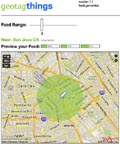
Assigning URLS Locations in the Physical World
Geotagthings--by Julian Bleecker and Will Carter--is a simple way to assign any web resource — anything with a URL - a location in the normal, human physical world. The Internet and other networks are very rapidly spilling out into the physical world. Whether you call it pervasive networks, ubiquitous computing or the geospatial web, one can easily anticipate that the networks need geographic semantics. In the physical world, location means more than a uniform resource locators (URLs). In the physical world, the data that is sluicing around also needs to know where it is according to an additional set of geographic information, such as latitude / longitude, or relative location to canonical landmarks, or simply the town or city in which that previously non- geotagged data has relevance.
Geotagthings is an important component of the larger toolkit of collaborative mapping projects. It provides a bottom-up resource for networked public contributions to mapping the web and making web resources "findable" and relevant to activities in the physical world. Geotagthings is pluggable. It's not a destination, nor a community site. It's meant to be used by destinations and community sites, or simply while going about your business, surfing the web. [via pasta and vinegar]
Posted by jo at 12:19 PM | Comments (0)
Régine Debatty at Sonar

Google Earth & Google Maps Hacks
From UFO to George Clooney sightings, from the nearest Kosher restaurant to the nearest sex offender, from the location of avian flu outbreaks to a review of the greenest golf course, from fresh beers to a new partner to share them with… As part of its restless bid to rule the worlds – both the online and the offline ones - Google has made it easy for us to find anything we need. Google wasn’t the first to offer interactive online street maps and routing but its powerful and highly readable system makes us wonder why we used to be so thrilled with good old Yellow Pages.
When the search engine released Google Maps in February 2005, independent programmers seized the opportunity to customize the system. Four months later, Google released the API that took the mapping application to the next level, allowing hackers and amateurs to refashion maps that geographically illustrate any kind of vital or outlandish information. Diluted into this grassroots plethora of Google Map hacks (have a look at the Google Maps Mania blog and you’ll see what I mean), one can find here and there projects that explore the possibilities of Google Maps under an artistic perspective.
It doesn’t mean that artists are slow to jump on the bandwagon. They just didn’t wait for Google to engineer the tools that would allow them to renew our experience of topography. I’m not only referring to the locative media trend which emerged over the last half decade but also to works that anticipated, well ahead of their time, what Google Earth would one day be. In 1994 already, ART+COM came up with "Terravision", an installation that enabled users to navigate –topographically but also chronologically– in a 3D model of the globe by moving a tracking device in front of a projection of the Earth.
And in the ‘80s, Michael Naimark’s "Golden Gate Fly-over" moviemap allowed users to navigate around the San Francisco Bay Area at fast speeds using images filmed by a gyro-stabilized helicopter camera and satellite navigation. Hopefully, the pieces selected for the Digital Art a la Carte section demonstrate that if one of the roles of artists is to pioneer technologies and applications, another one is to offer a fresh perspective on those that have already fallen into the mainstream.
Anders Weberg & Robert Willim, "Surreal Scania"
http://recycled.se/surreal/img/stills/index.htm
Christine Hanson, "Delocator"
www.delocator.net
Jim Nachlin, "GarbageScout"
http://garbagescout.com
Michael Frumin, Eyebeam R&D "OGLE"
http://ogle.eyebeamresearch.org
Rick Silva, "Satellite Jockey"
http://satellitejockey.net
Steve Coast, "Openstreetmap"
http://wiki.openstreetmap.org
Zack Denfield, Nika Smith, Brent Fogt, Kyle Mulka, "Blue Puddle"
www.bluepuddle.org
Sonar Festival--Digital à la carte: 15 June, 2006
Régine Debatty writes and makes research about the way artists are (mis)using emerging technologies. She is also a consultant for corporations, festivals and art commissions.
Posted by jo at 11:44 AM | Comments (0)
"EJECT" VIDEOPERFORMANCE FESTIVAL
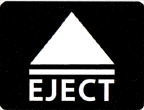
CALL FOR SUBMISSIONS (VIDEO)
EJECT: FIRST INTERNATIONAL VIDEOPERFORMANCE FESTIVAL OF MEXICO CITY - All artists of any discipline will be able to participate with a piece of video-performance or performance registration (documentation) whose duration be not longer than 10 minutes.
Deadline: June 24, 2006. In order to encourage the use of video as a support to create performance pieces, the National Council for the Arts through the National Institute of Fine Arts, Ex Teresa Arte Actual, CENART's Multimedia Center and P3RFORM4NC3 call to artists and groups dedicated to performance and others disciplines to participate.
- The works should be delivered in an envelope closed and lettered as follows: EJECT FIRST INTERNATIONAL VIDEOPERFORMANCE FESTIVAL OF MEXICO CITY. Address: Ex Teresa Arte Actual. Lic. Verdad no. 8, Col. Centro, C.P. 06060, México D.F. The projects sending by express post-delivery should be lettered with the legend: “WITHOUT COMMERCIAL VALUE – FOR CULTURAL END ONLY”.
- Only pieces presented in VHS, VCD, DVD or MiniDV format will be accepted.
- An envelope with the following printed information should be enclosed: title, name of the artist or group, telephone, e-mail and post address, brief resume of the artist or group and brief video description. For the case of performance documentation the performance date is required too (date, place, festival, credits of camera, etc.)
- The reception deadline will be June 24th, 2006. The works sent by ail or express delivery only will be accepted according of postmark date.
- The members of the jury (3 Well-known Mexican artists) will select 25 videos having image quality and proposal originality as criteria. Their failure will be unappealable.
- Videos selected will integrate EJECT, First International Videoperformance Festival of Mexico City which will be celebrated from 2nd to 4th of August at ExTeresa Arte Actual and from 9th to 11th of August at CENART's Multimedia Center. All those whose pieces would had been selected will be inform by email and after the festival a videobrouchure would be delivered that will include all
selected pieces and a participation diploma too. Also, selected pieces will be exhibited in diverse electronic media.
- The selected pieces will not be returned. The Documentation Center of Ex Teresa Arte Actual will select pieces of its interest in order to integrate them in it. For protection, remainder works will be destroyed for which is recommended to register author’s rights in all cases.
- This festival is done without profit interests for which the organizers will not take charge of expenses that could be generated for artists and groups participation (transportation, lodging, honoraries neither postage and delivery expenses).
- Any case not established in this document, most be presented to the jury in order to get a resolution.
For more information please contact
Pancho Lopez
EJECT curator and organizer
Phones: + 52 55 5522 9093 / +52 55 5522 2721
Email: p3rform4nc3 at hotmail.com
Website: www.p3rform4nc3.com
Posted by jo at 11:29 AM | Comments (0)
Phillipe Rahm: Architect

Corporeal Space, Transmitting Bodies
REVERSE is a project dealing with a specialist inversion: the loss of information instead of receiving it. Its objective is to create spaces where data is lost where information diminishes, inverting the present-day system where data is distributed through electromagnetic projections in the cinema, on television and public announcements. In each case, the objective is not to receive information but to lose it, changing our state as receivers of information into that of transmitters of information. We estimate that the amount of information that we receive from our environment through our senses as being 10 bits to the power of 9.
REVERSE is an architectural and urban project that aims to produce negative information and a negative information environment--at least 10 raised to the power of -9. The field of action is the same: electromagnetic space, now however, the direction is reversed. Our bodies change from being to receivers to transmitters.
The infra-red beam directed to the cinema screen becomes cold and black. All bodies emit energy in the form of electromagnetic radiation. Our skin, at a temperature of between 33º and 36ºC emits infra-red radiation. If an object in our environment is colder than our skin, the heat our bodies lose in the form of radiation will be directed towards this colder object. Our body, placed before the screen becomes literally a projector of invisible information. This is the inverse state that we seek: changing from a passive to an active state, we become transmitters in a suddenly receptive environment.

Expo 01: A certain quantity of energy: our proposal for the Neuchâtel Arteplage [artbeach] at the 2001 Swiss National Exposition is designed to act solely on the quality of the air, as an architectural act performed on the raw material of architecture, which is space. Thus, there is no longer any recourse to shape, image, volume or surface. The aim is to work on the air itself, to alter its chemical characteristics and bring about a change in the physiological relationships between the human body and the environment.
Thus, architecture ceases to be a composition or opposition of heterogeneous elements such as figure and background, shape and surface, filled space and void, but becomes an internal change in what constitutes space, i.e., air as a physical medium. Space, improperly described as a vacuum, is recognized in its corporeality. The result is a reconquest of space as a quantity of air and air as matter, with its weight, density and physical and chemical characteristics, in which the human body is immersed.
Philippe Rahm (1967) studies at the Polytechnic school of Lausanne and Zurich. He obtained his architectural diploma in 1993. He was associated until 2004 with Jean-Gilles Décosterd into the Architects Office "Décosterd & Rahm, associés". He works currently in Lausanne ( Switzerland ) and in Paris ( France ). In 2002, he was chosen to represent Switzerland at the 8th Biennial of Architecture in Venice. He has participating in a number of exhibitions worldwide (Archilab 2000, SF-MoMA 2001, Museum of Modern Art of the City of Paris 2001, Tirana Biennial 2001, Valencia Biennial 2003; Lisbon Biennial 2003, Graz Biennial 2003; CCA Kitakyushu 2004, Mori art museum 2005, Frac centre, Orléans, Centre Pompidou, Beaubourg 2003-2005) Philippe Rahm stayed at the Villa Medici in Rome (2000. He is Master of the Diploma Unit 13 at the AA School in London, professor at ECAL Lausanne, visiting professor at the Ecole Nationale Supérieure de Beaux-Arts of Paris in 2003, Mendrisio Academy of Architecture in Switzerland in 2005. He is currently working on several private and public projects like a house for artist Fabrice Hybert (France), a new restaurant for the ENSBA in Paris, an urban planning for the Vassivière area in France, and a Park in Austria.
Posted by jo at 11:26 AM | Comments (0)
Shadows
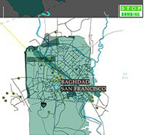
Paula Levine
"...Shadows from another is a series of hypothetical mappings, both web based and site specific, that use Global Positioning Satellites to imagine the impact of political or cultural changes that takes place in one location, upon another. Collapsing what is ‘foreign’ and what is ‘domestic,’ these hybrid spaces are new territories, redefined through new border or land configurations.
The longitude and latitude of each bombsite in San Francisco is marked using a GPS device, the same technology used by the military to target sites in Baghdad, Iraq. These sites are mapped, chronicled and documented with photographs, showing what currently exists at these locations. The series offers variations on the impact of political or cultural traumas, such as wars, shifts in borders and boundaries as the transposed spaces collapse the safety of distance and allow distant and foreign events to be translated and experienced on local ground." From New and Recent Art by Paula Levine, newmediaFIX.
Posted by jo at 11:05 AM | Comments (0)
BodyDaemon: A Bio-Responsive Internet Server
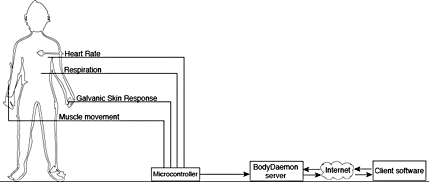
BodyDaemon, by Carlos Castellanos, is a bio-responsive Internet server. Readings taken from a participant's physical states, as measured by custom biofeedback sensors, are used to power and configure a fully-functional Internet server. For example, more or fewer socket connections are made available based on heart rate, changes in galvanic skin response (GSR) can abruptly close sockets, and muscle movements (EMG) can send data to the client. Other feature's such as logging can be turned on or off depending on a combination of factors.
BodyDaemon also includes a client application that makes requests to the BodyDaemon server. The client requests and server responses are sent over a "persistent" or open socket. The client can thus use the data to continuously visualize, sonify or otherwise render the live bio-data. This project is part of larger investigations focusing on the development of protocols for the transfer of live physiological and biological information across the Internet.
BodyDaemon represents the early stages of investigations into the viability of systems that alter their states based off of a person's changing physiological states and intentions - with the ultimate goal of accommodating the development of emergent states of mutual influence between human and machine in a networked ecosystem. [via Switch 22]
Two clients have been developed for BodyDaemon:
1. Combat by John Bruneau
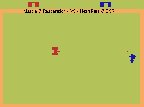
Combat is a game developed by Atari in 1977. It runs on the Atari 2600 home consol system. Two tanks, each controlled by a different player, battle it out in a single screen arena. The pixels are big and mighty and carry with then a good helping of nostalgia.
The task of controlling each tank in Combat is split between two body statistics. One controls steering and the other controls thrust and shooting. All actions are determined by the rise and fall of each stat. For example, if heart rate was in charge of steering then a drop in the user’s heart rate would cause that particular tank to turn right, and I raise in heart rate would cause that tank to turn left. Each round ends after 2 minutes, 16 seconds at which point the next round starts and new teams are formed.
The Combat Client was created with Max/MSP, Jitter, and Javascript. It utilizes two key externals, in order to function. The first of which is the OSC and UDP objects by Matt Wright which allow Max/MSP to communicate with the BodyDaemon server. The other external is jit.atari2600, an Atari 2600 emulator/manipulator object written by Kyle Buza. This external allows me to directly access the original Atari Combat game ROM.
2. Gravitons and Graviolis by Aaron Siegel

Gravitons and Graviolis is specifically designed to translate the signals from the bodydaemon server in a manner creating a simulated orbital system of particles. The signals are transposed in the corresponding manner:
EKG: speed of particles
GSR: range of hue of particles
Respiration: number of particles on the stage
EMG: disable background drawing to allow for "pixel painting"
Preliminary code sketching was done in anticipation of this project in the form of gravitons and graviolies.
For more information on this project visit the following web sites:
ccastellanos.com, wiki.ccastellanos.com
John Bruneau's client
Aaron Siegel's client
BodyDaemon will be exhibited at ZeroOne/ISEA2006 this summer.
Posted by jo at 10:00 AM | Comments (0)
VloggerCon
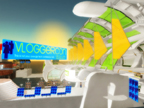
In Second Life, Too
The video blog conference under the name of vloggercon was held in San Francisco on June 10 & 11. Because the event was sold out, it also took place in Second Life. The location was the Hipcast Conference Center at the Shalida sim. Video.
VLOGGERCON 2006 is the intersection between media-makers and technology. A space for dialog and interaction. Of creation and collaboration. A media village born on the internet, and making camp for one weekend in San Francisco. In the past year, videoblogging has grown into a myriad of forms with a worldwide voice. And your voice is needed at Vloggercon– after all, the media is being made by you so it’s your voice that we want to hear! Vloggercon is a two-day collection of roundtable discussions about the emergence and the future of this new medium; not a series of lec-tures. (via Tao Takashi and unmediated]
Posted by jo at 08:23 AM | Comments (0)
Sonic Graffiti
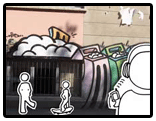
Geo-tagged musical graffiti
Chia Ying Lee's Sonic Graffiti invites urban artists to collaborate and create music together, while allowing the passersby to enjoy it as well. A system of devices enables graffiti artists to create and geo-tag music in the urban space with real spray cans:
- The sound cap has to be snapped on the top of spray cans to spray out sounds and do simple sound manipulations with gestures. Users create music by overlaying/remixing various paint/sounds from the caps. Each cap can store up to 4 sounds in its memory card. They can be loaded from computers or portable devices like iPod, mobile phone, etc. Gestures to manipulate sound include fade in/out and scratch. Several artists spraying at the same time can create a sound composition.
- The controller is used for listening to the music with earphones when creating, and positioning sounds. It also comes with a recording part can be used for collecting sound samples from the city.
- The Boom box provides a shared listening experience for a group of creators in the public. Collaborations can be achieved both synchronously and asynchronously.
- Audiences can download a dedicated software player to install in mobile devices. Each graffiti is a small radio station. The player tunes into the music of the nearest sonic graffiti automatically while you go through the city. You can also mark the locations of music you like, hence make a personal sonic graffiti map.
This project gives graffiti audio meanings. It may change people’s viewpoint about graffiti. The music can also serve as the soundtrack reflecting the vibes of the city.
More details on Chia-Ying Lee's thesis blog. My images of her installation.
Related: spatial graffiti, Wearable inkjet printer for street art, Audio messages left in space, Graffiti Analysis projections, Hektor the graffiti machine, emergency spray can, Bench'Mark. [blogged by Régine on we-make-money-not-art]
Posted by jo at 08:19 AM | Comments (0)
June 12, 2006
Drew Hemment
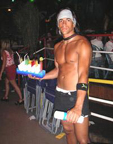
Last Night An Arphid Saved My Life
"...What can we learn from the fact that this experiment in introducing a controversial new technology took place in such an unlikely location? It is happening amongst people who have a proven appetite for playing with the limits of their natural bodies, but beneath the radar of the technology's natural critics, a world away from the cultural institutions that play host to the likes of Orlan and Stelarc.
Baja Beach Club is not a place where new cultural movements are born, not even the kind of dark crevice where things grow. This may be less to do with marketing the instruments of 'control' as fashion, more about sowing a seed with a wider market in mind. Once a technology is out there, a fact of every day life, it is near impossible to roll it back. In Baja's case it is more a case of perception than the facts on the ground. If there is a war going on, you will not find it in Barcelona. Instead it is being fought in the column inches of the international papers and blogs that gave the story oxygen..." From Last Night An Arphid Saved My Life by Drew Hemment.
The implications of RFID will be explored at an international conference in Manchester UK on July 21-22 organised by Futuresonic in association with PLAN - The Pervasive and Locative Arts Network.
Posted by jo at 07:15 PM | Comments (0)
We're Not Gonna Take It!

Protest Karaoke-Style
We're Not Gonna Take It, by Amos Latteier, is an interactive public art project that allows you to record your own protest songs using the telephone. You can create a song about issues you wish to protest (such as corporate globalism, your landlord's poor repair record, or bad produce at the supermarket). You record your song by using the telephone like a karaoke machine, singing along to rock music. Your personal protest song will then be delivered to the politicians of your choosing.
From Jonah Brucker-Cohen's Gizmodo interview with Amos Latteier: In the world of creative interventions into popular technology, projects that make us question how we consume and use digital devices are often those that maintain our attention. Using this credo as a starting point, Toronto, Ontario-based artist, Amos Latteier creates work that explores the lighter side of technology. Poking fun at everything from corporate software presentations with his PowerPoint performances to creating homebrew prosthetic limbs with the “Prosthetic Ass”, his work examines the subtleties of DIY culture and the potential “emotional” impact of simple devices.
Re-purposing consumer electronics in inventive ways, his project, “Calculator Haikus”, creates poetry from upside-down calculator displays to emphasize how a playful approach can often yield unexpected results. On the software side, his inquisitive PowerPoint lectures employ the bland presentation software to create absurd relationships between viewer and speaker. Gizmodo caught up with Latteier to discuss his artistic practice, creative philosophy, and aim to infuse mild absurdity into standardized teaching methodologies and mass-produced software and hardware. Interview and photos after the jump… [via Coin Operated]
Posted by jo at 04:59 PM | Comments (0)
Neighbourhood Satellites
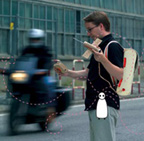
Environment-Sensing Adventures in the City
As we move through the city, mobile devices allow us to enjoy remote networking and immersion in personal entertainment. These preoccupations, however, lessen our sensitivity to what is happening directly around us, and often we learn about our own environmental conditions through mediated sources. What if mobile technology could reconnect us to our surroundings by observing environmental data directly, data that had been obscured from us before?
Neighbourhood Satellites--by Myriel Milicevic--consists of handheld sensing devices, powered by light, which enable people to monitor their local environment in a playful way, combining physical exploration and real-world data with digital gameplay. Each satellite monitors air quality, cellular signals, and light levels. The data it collects is presented in three different modes. ‘Status’ mode simply displays the current conditions. In ‘game’ mode the satellite leads a parallel existence inside a small video screen, navigating amongst the offending pollutants to be analysed. Its orientation mirrors the position of the satellite in your hand as you capture specimens and avoid self-contamination.
Greater pollution produces more challenging gameplay. You may have to go elsewhere to find cleaner air, less radiation, or more light to recharge. In ‘map’ mode the system receives data from all the other ‘satellites’ being carried by people in the area, and displays on a map their location and contamination level. Carriers might choose the cleanest path to walk or, in a spirit of risky play, purposely seek the most contamination; either way, the city’s pollution topography is dramatically plotted.
Through this playful grass-roots monitoring, the presence of contaminants in a community can be known and charted by anyone. This awareness encourages a more conscious individual behaviour, which spreads cumulatively to neighbouring communities. QuickTime Movie (by Andrea Pierri)
Posted by jo at 04:30 PM | Comments (0)
Heath Bunting + UBERMORGEN.COM
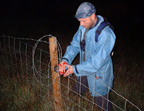
(former) net artists
OVERGADEN – Institute of Contemporary Art in collaboration with Artnode will open two solo exhibitions by Heath Bunting and UBERMORGEN.COM as well as a special exhibition that joins the work of the two artists. Heath Bunting and the duo UBERMORGEN.COM. Two pioneers, rebels and stars of net art. This is the first time they exhibit together. Almost without computers! Curated by Jacob Lillemose: June 15 – July 16, 2006; Private view: Wednesday June 14, 2006, 5 pm – 8 pm; Hours: Tuesday-Sunday 1 pm – 5 pm.
Cutting, Climbing, Crossing will present a number of Heath Bunting’s recent works which deal with issues of borders, identity and physical space. Central to the exhibition will be the world premiere of Bunting’s ongoing project "The Status Project," a mapping of the multi-layered logic of the mobility and legal routes of the social system. The work will be presented as wall-mounted diagrams, an interactive database and a 4,200-page manual!
[F]originals: Authenticity as Consensual Hallucination is the third and closing part of an international joint venture between OVERGADEN – Institute of Contemporary Art /Artnode, [plug.in] and Hartware MedienKunstVerein. The exhibition will be a classical painting show, consisting of 6 large square canvasses with digital prints of the official seals from UBERMORGEN.COM's projects from the last five years. The paintings are “[F]originals” – originals and forgeries – and refer to the ambiguous status of the 'documents' that UBERMORGEN.COM produce through their dealing with issues of our technology-based culture.
dayplandrugblog. two ways to live your life as a (former) net artist features another world premiere or actually many works that deal with diaries. Heath Bunting will show 365 of his daily what-to-do maps (one for each day of 2005) drawn by hand on paper, while UBERMORGEN.COM will show prints of one month of the online “drug blog” together with the video “PsychOS”.
In connection with the project a number of publications will be available. Heath Bunting will print his “Day Plan Guide” along with the “Project Status Manual” and for the UBERMORGEN.COM show a catalogue edited by Alessandro Ludovico (neural.it) will be published in late August.
The project is the result of an ongoing collaboration between OVERGADEN – Institute of Contemporary Art and Artnode with the ambition to bring international computer-based contemporary art to Denmark and to get computer-based contemporary art out of the new media ghetto.
The project is generously supported by Pro Helvetia – Schweizer Kulturstiftung, British Council in Denmark, the Austrian Embassy in Copenhagen and the Danish Arts Council.
UBERMORGEN.COM are currently exhibiting at Hartware MedienKunstVerein, Dortmund.
OVERGADEN
Institute of Contemporary Art
Overgaden Neden Vandet 17
DK-1414 Copenhagen K
Phone +45 32 57 72 73
Mail info[at]overgaden.org
Web http://www.overgaden.org
Tuesday-Sunday 13-17
Posted by jo at 04:09 PM | Comments (0)
Goal 2006
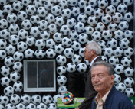
A Global Goalllllll
American artist Jon Winet often uses new media to comment on contemporary media culture. He's previously immersed himself in the realms of soap operas and political campaigns, in collaboration with Margaret Crane, and in his newest endeavor he takes on the mega media spectacle that is the World Cup. Goal 2006 leverages the international attention directed at this sporting event to raise awareness of deeper issues related to globalization. The project takes many forms, including a multilingual website, an SMS/MMS project, and an exhibition to be held June 26-July 5, at Stuttgart, Germany's Rocker 33|Dialekt. The website revolves around 'a virtual football card in 64 versions, featuring updates and RSS media feeds for the participating FIFA countries, original video, audio and photography, and field reports worldwide.' The site successfully mimics the rich, celebratory design style of any other sports page, but each player's card is accompanied by reports of environmental and social challenges specific to that locale, as a result of globalization. The SMS/MMS project allows for phone-based daily downloads and rich text messages with similar information. The sign-up page for this service refers to it as 'media research,' thus implicating Winet's audience in his broader study of the products and processes of media consumption. - Marisa Olson, Rhizome News.
Posted by jo at 03:52 PM | Comments (0)
de Pong Game™
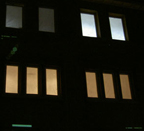
PONG Augmented/Recycled
De Pong Game is a recycling of the famous game PONG [Atari 1975-1977]. This new version has been built with Flash [Action Script] by Arjan Westerdiep for Recyclism™. De Pong Game explores the concept of Augmented Reality by using and interacting with urban architectures [buildings] as background for the game; the game is projected on a building and the limits of that building become the limits of the game area.
The projected ball bounces along the limits of the walls. The software also uses the windows as obstacles for the game. So the ball is limited to the frame of the building. As you touch the ball with the slider, its speed increases, and because the ball bounces on all the obstacles of the architecture, it becomes more and more difficult to play. [Related: Space Invaders]
Posted by jo at 03:20 PM | Comments (0)
Sun.Dial

Web-Cam Display Clock
Texas based artist, Max Kazemzadeh’s Sun.Dial project is a "an internet-based installation project that fosters a sense of shared global space and time. The principle system consists of twelve LCD displays suspended from an overhead apparatus in an outward-facing ring. This circular display is the hub of a world-wide input system. Each screen displays the information from one of twelve webcams located at intervals around the world. Each camera faces upward, capturing only the sky in each location. This creates a light gradient ring that displays the current state of the sky’s light at points around the globe. When it is dawn in one screen, it is noon a few steps over, and nightfall a few steps down from that. A connection is created between the hosting site, where sun.dial is located, and the locations capturing the light of the sun. The piece is in a way a digital incarnation of the astrolabes and orreries that were the beginnings of technology’s global perspective." [blogged by Jonah on Coin Operated]
Posted by jo at 01:12 PM | Comments (0)
June 09, 2006
Memento
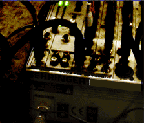
A Monument to South African Youth
On 16 June 2006, South Africa celebrates the 30th anniversary of Youth Day. The act of remembrance is shaped by a multitude of senses ranging from sight, sound, physical touch and smell. This year Gallery MOMO invites you to join us in commemorating Youth Day through the experience of sound. Nathaniel Stern, João Orecchia, Shane de Lange, Johan Thom and Dinkies Sithole will work together to create a Memento - a sound sculpture to commemorate Youth Day. At 16:00, one hour performance, drinks served. 52 7th Ave, Parktown North, Johannesburg, South Africa.
The artists will draw from their own, particular experience of life in contemporary South Africa to formulate a personal, aural response to the celebration of Youth Day. For example, both Shane de Lange and Nathaniel Stern are best known as artists working with digital media to create art: de Lange creates experimental sound by appropriating and sampling sounds from various sources including music, the body and even the sounds of a paper bag; Stern is known as a new media artist who uses interactive digital technology, often drawing the viewer and the artwork together in a new interactive, symbiotic whole.
Other participating artists like João Orecchia, Johan Thom and Dinkies Sithole work with media such as musical instruments, video, performance and even their bodies to create experimental works that more often than not, refuse easy classification as ‘visual art’.
Nonetheless, all the artists share a playful, experimental approach towards the creation and presentation of their work. In this way, each artist will prepare a series of aural responses to the commemoration of Youth Day. [via nathaniel's blog]
Posted by jo at 12:48 PM | Comments (0)
Listening and Dancing in Second Life
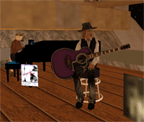
Taking Your Avatar to a Concert or Dance Class
"...A couple of Sundays ago, I took my avatar to a small pond where about a dozen people lingered in the late afternoon sun, floating on inflatable rafts and inner tubes while a pair of animated swans jerked their way across the water. Everyone was turned toward Few, sitting on the deck above the pond with his acoustic guitar, and everyone nearby could hear a feed of the real-life Hokin, from his real-life basement, playing cover songs.
While I dug Few's proficiently-played but laid-back standards, I wasn't here to decide whether this was the best version of "The Girl from Ipanema" I've ever heard so much as to check out the experience-- and it was surprisingly engaging. If it seems strange to come to a video game to watch a concert, remember that we've been listening remotely to live shows since the first days of radio. In that sense, this is nothing new-- and while it's more disorienting than tuning in to the Grand Ole Opry, it's more rewarding than other options, like watching a streaming video of a rock show through a tiny RealPlayer window. At least in Second Life, you can move the camera..." From Get That Out of Your Mouth #24: The Show Must Go Online by Chris Dahlen.
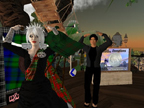
"...Now with the growth in dancing in this alternative reality, I have more of an incentive to make an avatar for myself and start wondering around and going to clubs, get-togethers and, even, dance studio. This notice caught my attention:
This past Tuesday, the Takeshi's Dance Studio in Second Life held an event to teach people how to dance. Plus, they will soon be building a theater and they need dancers ... Dancing doesn't just take place in virtual clubs. Events on private islands also feature music and dancing. Earlier this year, Creative Commons hosted a party...
In "Get That Out of Your Mouth #24 - The Show Must Go Online," Chris Dahlen describes the experience of listening to music in Second Life, how indie bands take virtual tours and make money, and the limitations of gestures and dance in this virtual world:
Players also can't control their avatars with any spontaneity or nuance; if you want to dance at a show, you can trigger an animation that runs your avatar through the steps, but you can't personally step in to make the arm rest on your partner's back just so. The same problem applies for performers. If you look closely at Few as he's playing guitar, you'll see that he can't strum or move his hand on the fretboard, and his face is trapped in a stiff mask, like a dummy in a vintage Disney World ride. And while you can add more animations and poses to an avatar, if you have the time and you're handy with 3-D modeling software, you can't make the spur-of-the-moment gestures that even stiff indie rockers need to liven up their acts.
- And Rik Riel (his SL name) in his "Dancing with myself... with other people" post, says that he goes to a lot of SL events and music gigs. He describes how dancing works:
In Second Life, you are given a small set of pre-defined dance animations that you can trigger from your keyboard. It's easy to pick up other animations at parties or from friends. You can easily perform everything from a waltz to b-boying to country two-step (not to mention more, uh, provocative dancing).
But he's not really sold on this virtual dancing:
A real basic question is Why would you do this? Virtual dancing provides none of the perks of real world dancing, either the joy of movement, the physical response to music you are digging, the pleasure in touching another person, or the pride of executing a difficult move. There's no learning curve, no physical exertion, no effort to anything, except maybe the effort involved in designing your own custom animations.
I've been dancing my whole life, from all of the terrible 80's trends (smurf, running man, pac man, etc.) to popping and locking, salsa, tap, and now lindy hop. There are few other moments when I am happier than when I am dancing. There is nothing to compare to sharing great music with someone you care for swaying in your arms. I love dancing so much, I help administer the largest lindy hop community website on the net, Yehoodi.com. [blogged by Doug on Great Dance Weblog]
Posted by jo at 12:26 PM | Comments (0)
Anechoic
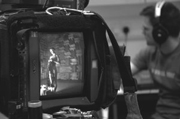
The Sound of Clothes
Over the Spring '06 season, SHOWstudio is embarking upon a series of projects devoted to exploring The Sound of Clothes. Continuing our commitment to re-thinking mainstream fashion editorial, we believe fashion audio to be a genuinely new frontier. Beyond overlaying imagery with non-specific sound - such as favourite songs or ambient music - the aim of The Sound of Clothes series is to explore a range of audio possibilities, such as discovering the actual sound a garment makes.
Anechoic is a 'collections story' project that uses sound instead of visuals to interpret the essence of key garments the A/W '06-7 season by leading fashion brands. A live recording session in a specialist recording studio -a hemi-anechoic chamber- on 1 June 2006 was used to create a series of groundbreaking interactives that for the first time in fashion media, detailed the precise sound of fashion materials such as feathers, sequins, glass crystals and beads, nylon, taffeta, leather, velvet, jacquard, zips and metallic chains.
Posted by jo at 12:16 PM | Comments (0)
Digital Cartographies:
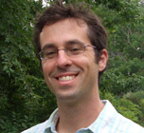
From Metageography to Locality in Online Navigation
"Abstract: When Internet technology entered into popular culture in the 1990s, the virtual dominated the discourse with talk of cyber-worlds, fragmented communities and disembodied individuals. Today, location and social connection define the parameters of the media. This new orientation has redirected network activity away from early predictions of virtual isolation and towards a social connectivity that is decidedly located and contextual. In this essay, I examine changes in the popular understanding of digital space and digital subjectivity. I begin with a discussion of the metaphor of mapping in postmodernism and cyberspace and I suggest that such metaphors, premised on the conceptual distinction between real and virtual, have given way to the localized and embodied mapping of Web 2.0. Technical, industrial and cultural changes in digital culture over the past several years have created a distinct digital social space wherein the virtual world is anchored by the growing and persistent visibility and parallel commodification of everyday life." From Digital Cartographies: From Metageography to Locality in Online Navigation by Eric Gordon.
Posted by jo at 10:56 AM | Comments (0)
SPECTROGRAPHY
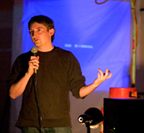
@ Waves 2006 and Bandits-Mages 2007
SPECTROGRAPHY by Ewen Chardronnet & Rasa Smite: In 2004, RIXC and Ellipse led, together with their partners from Slovenia, Finland, Norway and Iceland, the 2000 cultural programme called “Trans-Cultural Cartography”, on the occasion of the celebrations connected with the enlarging of the European Union.
A closing performance of “Etonnante Lettonie” (“Surprising Latvia”) will be made in the evening at the Bandits-Mages digital festival, in Bourges, following a workshop and a collective digital art and sound art exhibition at the Point Ephémère in Paris.
The theme proposed by RIXC and Ellipse for this trans-regional project is "spectography". A process of visualization and sonification of the data of the electromagnetic spectrum will, amongst other things, present some of the work done by the RT32 radiotelescope in Latvia and the technologies of the transmission and creative process of sound and image by means of live techniques on the net or via satellite.
The workshop and its set-up will build up and explore transmission channels live on the web and via satellite between RIXC in Riga and the Point Ephémère in Paris. Two simultaneous workshops in Paris and in Riga and interactions with bases situated in Lyon, Bordeaux, Strasbourg as parts of the ECM network will explore the means to gather, process and transmit information. The “Studio RIXC” site will supply the project’s permanent information. The “Spectography” project is meant to link both workshops via the internet and satellite. Both workshops are the preparatory events to the 8th “Art+Communication: Waves” festival organised by the RIXC in Riga in 2006.
Posted by jo at 10:45 AM | Comments (0)
Simulacrum Populi (a.k.a. "MultiCultureMolecular Humans")

PAYSAGES PARALLELES
Simulacrum Populi (a.k.a. "MultiCultureMolecular Humans") by Jaanis Garancs at Festival Bandits Mages, Bourges: The term 'multiculturemolecular virus' is used as a (slightly ironic) metaphor for human physical and mental interaction – through genes, memes and code. This interaction could be also described as sharing, exchange, competition and conflict among various nations, ideologies and cultures.
Forces of human natural life cycles, human passion, the will and spirit move the 'multiculturemolecules'. It can be a striving for balance, dominance or survival from individual – to state or whole ethnos scale. Either living in symbiosis with others, adjusting or changing themselves or taking somebody else's place – in various parallel power levels.
Diplomats, tourists, spies, PR agents, guest workers, mixed family children, soldiers, refugees, etc., spread 'viruses' or 'anti-viruses' that bring both 'illnesses' as well as 'cures' to them.
What is more important in the today's globalisation context and mediated reality, culture clashes, economical competition and personal privacy challenges? Is it the mass of combined number of inhabitants, nations gross domestic product, income-per-capita, age-structure? Or – it is the organisation level, cultural vitality or 'spiritual strength' of an individual? This artwork does not give the answer, but tries to show the possible bridges (interferences) between mental and physical social ambiences. Lightly humorous comments on some 'popular phobias', 'nostalgias' and 'conspiracy theories' are combined with a somewhat dark future vision on mixed digital and organic realities.
Realisation: (premiere at the Ars Electronica Festival 2002) SEE VIDEO (RealMedia) | snapshots (JPG)
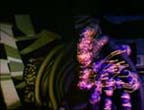
Interactive installation, 3D stereo projection with 3D (8-channel, XYZ) sound. Visitors can observe dynamic scenes made of letters, signs and symbols. These 'molecules' contain fragments of language (i.e. Latin-, Arabic-, Asian- etc. words and characters) and symbols of cultural identity: country flags, landscape, trademark and other imagery. On visitor activity the global map 'morphs' and zooms into landscapes, city streets and human figures that also are made of the signs. During user inactivity period the scene influxes back into a world map made up of pulsating characters, e.g. from languages typical to the according world part.
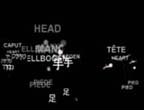
Users can change navigate scenes with several joysticks by changing the viewpoints and density of scenes. Approaching the human figures, their bodies appear to be made also from names of the body parts in various languages. By zooming into the figures and the body parts, the 'resolution' increases: e.g. 1) 'head', 2) 'hair+face', 3) 'lips'+'cheek’, 4) 'upper lip' + 'lower lip', etc.
The density and activity of avatars in specific area makes influence on the surrounding area and avatars (following the rules similar to the Game-of-Life). The avatar presence in various scene parts and mutual 'collisions' induce 'firework' and 'fusion'-like effects on their 'molecules'. When one avatar leaves some area, some other avatar entering that space partially 'repaints' that environment with its own 'molecule traces' or 'catch' and get 'infected' by surrounding 'foreign molecules'. The stereoscopic projection and quadraphonic sound creates an audiovisual illusion of ghost-like presence in the room (projected images – 'walk in and out' of the screen). The remaining traces also create an impression of ever changing landscape or fluid city.
Posted by jo at 10:11 AM | Comments (0)
Semantic Web
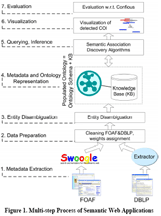
ARDA Holding Your MySpace Against You
New Scientist reveals that the Pentagon's NSA in the form of ARDA (Advanced Research Development Activity) are interested in the information people post about themselves on social networking sites like MySpace and are funding research into it's mass harvesting. A paper entitled Semantic Analytics on Social Networks presented at the W3C's WWW2006 conference revealing how data from online social networks and other databases can be combined to uncover facts about people was part-funded by ARDA. ARDA according to New Scientist is an organisation whose role is to spend NSA money on research that can solve some of the most critical problems facing the US intelligence community principally the problem of how to make sense of the massive amounts of data they collect. [posted by stunned to Net]
Posted by jo at 09:47 AM | Comments (0)
Playmobiel
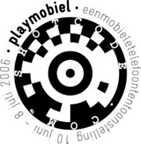
Txt PLAYMOB ON to 3553 for Daily Art
The PLAYMOBIEL exhibition showcases artists whose work explores mobile phone technology in playful way. The casting is pretty impressive.
Scanner composed music using tapped phone conversations; Blast Theory is famous for their mixed reality games; Arno Coenen designed a floor mosaic based on the interface of a Nokia telephone; Gerald Van Der Kaap handed out a mobile phone plus free minutes to a girl from Amsterdam to film and photograph herself; Leonard van Munster made a few hardware projects using the cell phone as a remote control device (image on the right); Esther Polak uses GPS to visualise the tracks of people resulting in a drawing; together with twodotone, PIPS:lab developed a software for mobile phones that can scan drawings and transform them into beats; Aryn Kaganof shot a feature film on mobile phone cameras; Kate Pemberton designs logo's and designs as wallpapers for the cell phone as well as cross stitching patterns; etc.
Apart from the show at the Arti space, a parallel exhibition will be accessible all over the world by mobile phone. By sending a text message PLAYMOB ON to 3553, you will be sent a short audiovisual work of art to your mobile phone every day of the exhibition. You can also use the ShotCode of PLAYMOBIEL: this 2D barcode contains an encoded link to a website. By taking a picture using your camera phone, you get direct access to the website (see instructions).
Playmobiel, at Arti, in Amsterdam, from June 10 till July 8. [blogged by Régine on we-make-money-not-art]
Posted by jo at 08:20 AM | Comments (0)
June 08, 2006
Avatar Body Collision and the Aotearoa Digital Arts
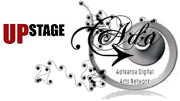
ADA Swaray
The second ADA Swaray takes place this Sunday, June 11, 9pm NZ time. Join members of Avatar Body Collision and the Aotearoa Digital Arts network for virtual cocktails, fine frocks, flowing conversation and a few surprises.
The ADA Swaray is a social meeting space for digital artists and other interested people, in the online performance environment UpStage. All you need to participate is a browser with the Flash Player plug-in. Check http://www.worldtimeserver.com for your local time.
Posted by jo at 04:15 PM | Comments (0)
Furthernoise.org presents
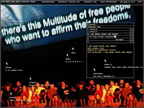
Month Of Sunday's Live A/V Net Performances
Furthernoise.org - Month Of Sunday's Live A/V Net Performances, Visitors Studio, 11th June 2006. Visitors Studio is an online place for real-time, multi-user mixing, collaborative creation, many to many dialogue and networked performance and play. Chat with other users while you upload and mix your sounds, images and movies in real-time.
16.00 -16.45 hrs Paul Wilson & James Smith: For this next Month of Sundays performance Paul Wilson and James Smith are mixing an audio / visual 'typography of place' where field recordings are combined with reprocessed images and sounds made in the extreme environment of former weapons testing lab at Orford Ness. They have collaborated on a range of projects which centre around techniques of sonic typography: using linguistic and alphabetic processes and systems to convert images, places and words into sound.
Recent projects have included a commission for The Wire magazine where the publication's covers of 2005 were reprocessed into a twelve-minute audio mix, and two installations for the upcoming 'Paintwork' exhibition at the Praxis Hagen gallery, Berlin where The Fall's '27 Points' album cover has been translated into both sound and (moving) image.
16.45 - 18.00 - Open Mix: Everyone is welcome to join this Open Mix which is one big A/V collaboration including contributions from online viewers in a host locations & time zones. For anyone who wants to contribute to this mix, media files must be a maximum of 200k and can be mp3, swf, flv & jpg formats. All mixes will be recorded to be featured in the next issue.
Log into file mixing studio - http://www.visitorsstudio.org
Links:
Paul Wilson - www.n-spaces.net
James Smith - www.3L-project.co.uk
Vistors Studio (VS) - http://www.visitorsstudio.org/about_vs.html
Credits - http://www.visitorsstudio.org/about_vs.html#credits
Posted by jo at 02:18 PM | Comments (0)
Coco Fusco

OPERATION ATROPOS
OPERATION ATROPOS is a documentary about interrogation and POW resistance training. Director Coco Fusco worked with retired US Army interrogators who subjected her group of women student to immersive simulations of POW experiences in order to show them what hostile interrogations can be like and how members of the US military are taught to resist them. The group of interrogators is called Team Delta, and they regularly offer intensive courses that they call “Authentic Military Experiences” to civilians. The documentary includes interviews with the interrogators that shed light on how they read personalities, evaluate an interrogatee’s reliability, and use the imposition of physical and mental stress strategically. More fundamentally, however, the film shows how interrogators rationalize what they do and how they imagine both themselves and their enemies.
Operarion Atropos will open at Elastic Space on 13 June 6-9 pm. The exhibition runs from 17 June to 30 July open 1-6 Saturday and Sunday and by appointment; 22 Parfett St. London, E1 1JR.
Coco Fusco, born and based in New York is a interdisciplinary artist and writer and is one of the most significant and influential performance and video-artists (also an articulate and outspoken theoretician, as well as an active curator). She deals with issues such as globalisation, gender-specific conflicts, cultural colonisation and intercultural theory and practice. Her work is an ongoing reflection on the conditions of (women's) bodies in globalising and technologically imbued environments.
She has performed, lectured, exhibited and curated around the world since 1988. She is the author of English is Broken Here (The New Press,1995), The Bodies That Were Not Ours and Other Writings (Routledge/inIVA, 2001) and the editor of Corpus Delecti: Performance Art of the Americas (Routledge, 1999) and Only Skin Deep: Changing Visions of the American Self (Abrams, 2003).
Fusco’s recent art projects combine electronic media and performance in a variety of formats, from staged multi-media performances incorporating large scale projections and closed circuit television to live performances streamed to the internet that invite audiences to chart the course of action through chat interaction. Her works have been included in such events as The Whitney Biennial, Sydney Biennale, The Johannesburg Biennial, The Kwangju Biennale, The Shanghai Biennale and VideoBrasil.
ELASTIC RESIDENCE is a non-profit gallery space for projects and durational performance. It is an artist-run space established in 2004, aimed at giving artists dealing with challenging contemporary material, direct access to exhibiting opportunities.
info[at]elastic.org.uk
0207 247 1375
Posted by jo at 01:56 PM | Comments (0)
Aula 2006
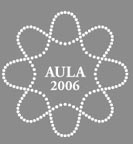
Movement / Mobility 2.0
Aula 2006 is an event (Wednesday, June 14) about the direction society, culture and technology are heading in. The theme Movement points to mobile 2.0 (mobility meets web 2.0), the overlapping of the physical and the virtual, and the social movement-like nature of new technologies. On a personal level, movement is about not staying still but taking action to shape the big global issues we face in the future.
We'll hear about movement from Clay Shirky the New York University professor who coined the term social software, Alastair Curtis the new Head of Design at Nokia, Martin Varsavsky founder of the global Wi-Fi network FON, and venture capitalist Joichi Ito who has invested in several successful second-generation Web companies including, SixApart and Technorati.
Movement also means a section of a piece of music, and the gathering will include interventions in music and dance. This event will be less of a conference, more an intimate gathering of people to discuss, detail and experience critical topics.
The event will take place at Bio Rex theatre in Helsinki. Attendance is free and open to the public - no advance registration is required. It is also possible to attend the dinner following the event at restaurant Via. Table reservations must be made in advance. After dinner, the event will continue with movement on the dance floor at Ahjo club in Hotel Klaus K to beats by Jukka Perko and Samuli Kosminen.
For enquiries, please contact Andreea Chelaru at andreea[at]fjord.fi.
Posted by jo at 09:48 AM | Comments (0)
Space Invaders 2006

Isn't Just a Fictional Space
Video game, as an interactive medium, has been designed for many different purposes such as education, entertainment, advertising and etc. What makes a game compelling as an experience in order to satisfy different purposes is the purpose of Space Invaders 2006. "Space Invaders 2006 " -- by Evan Barba and Kuan Huang (aka Hawk) -- is a public video game which isn't just fictional space that the players escape into but takes the advantage of a real world space with the architecture inside and transforms them into a game playground. Basically, "SI 2006" is a video game which is projected onto a building. The player controls an aircraft by moving his/her body in the space to shoot down the invaders before they move off the building.
Keywords: Outdoor projection, Video game, Architecture, Motion capture [Quicktime video] [via pasta and vinegar]
Posted by jo at 09:37 AM | Comments (0)
V1B3: Video in the Built Environment
![]()
Call for Participation
V1B3 is requesting submissions of short videos* that in the broadest terms possible, explore public space though human interaction, intervention and the mechanisms that influence and control the experience of the city.
V1B3 is an international curatorial project that aims to present video art that responds to the conditions of site specificity and a public viewer-ship. Urban planners and architects are used to shaping cities by means of infrastructure, zoning and buildings. However, other modes of intervention exist that are capable of influencing the development of a city. Communicative media interventions can transform public spaces.
V1B3 Summer06 will be presented in conjunction with the University Film and Video Association conference, sponsored by Chapman University in Orange, California. The US screening will occur during the UFVA conference [August 1ST-5th] in Orange, CA. The UK screening will be held at the London Study Center.
V1B3 Summer06 will have a companion DVD developed for publication and purchase.
July 7th DEADLINE: Application can be found at http://www.v1b3.com
US Contact:
Mat Rappaport
1511 North Astor St
Milwaukee, WI USA
info[at]v1b3.com
Sceenings Will be August 1st – 5th
* up to 2 minutes in duration. Works longer than 3 minutes will not be considered.
Posted by jo at 09:12 AM | Comments (0)
Turbulence Commission:
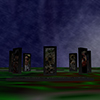
"Monolith[s]" by Michael Takeo Magruder
Monolith[s] juxtaposes two icons of British culture: stone circles (Stonehenge in particular) and the British Broadcasting Corporation (BBC). "We are in a gravitational pull of past and future." (1)
Lacking declarative evidence of its original purpose, Stonehenge is a site of contested meaning. "It suffers from polysemia, in that it signifies a range of meanings, discursively contested through image and text." (2) Visitors are kept at a distance, no longer permitted to walk among the stones and physically experience their immense scale.
In "Monolith[s]," Magruder has appropriated the perspective that many images of the monument give: that of the majestic site at a distance, the glow of the sunset or moonrise radiating from the horizon, its backdrop. But Magruder's virtual world IS approachable—indeed, the user may immerse herself in it or fly above it. As she does, the temporal and spatial dimensions of her own immediate environment are absorbed and rearranged into a constantly evolving virtual realm in which the history of the Information Age materializes.
Formulated according to motifs and proportions of ancient architecture, infused with fundamental mathematics of modern digital communication systems, each genesis of the artwork's geometry is unique. Variables such as the time of day, the viewer's location on the Earth, and the position of the Earth around the sun are incorporated into the artwork, thus instilling into the realm functions of a rudimentary clock, global positioning system, and solar calendar.
Requirements: The technical specifications are detailed on the Setup/Help page. Please read them before proceeding.
"Monolith[s]" is a 2006 commission of New Radio and Performing Arts, Inc., (aka Ether-Ore) for its Turbulence web site. It was made possible with funding from the National Endowment for the Arts.
BIOGRAPHY
Michael Takeo Magruder is an American artist based in the UK who received his formal education at the University of Virginia, USA, graduating with a degree in biological science. His artistic production has been exhibited worldwide and encompasses an eclectic mix of forms ranging from futuristic stained-glass windows, digital light-screens and modular sculptures, to architectural manipulations, ephemeral video projections and interactive net-installations. His work seeks to reflect upon the dualistic nature of media as both information source and cultural stimulant.
References:
(1) Jeanette Winterson, "Weight"
(2) Andy Letcher, Jenny Blain, & Robert J. Wallis, "Re-viewing the Past: Discourse and Power in Images of Prehistory."
Posted by jo at 09:04 AM | Comments (0)
Perlin's Law
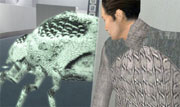
How Free Do We Want to Be?
"...For a long time now, I’ve been struggling with a conundrum of interactive storytelling that I dubbed “The Problem of Internal Consistency” in a lecture I gave at the Game Developers’ Conference in 1995. I also wrote about it in an earlier Designer’s Notebook column, “Three Problems for Interactive Storytellers,” back in 1999. The essence of the Problem of Internal Consistency is this: how do we balance the player’s desire for freedom with the designer’s desire to tell a consistent, coherent story? What do we do when the player wants to do something that doesn’t work with the plot that we’ve laid out? Refuse him permission to do it, and take away his freedom? Or allow him to do it, and destroy our story? I never came up with a good answer for it.
So last November, I went to a conference called Virtual Storytelling ’05 in Strasbourg, France. It was a small enough conference that every session was plenary—you didn’t have to choose between sessions, so as long as you showed up, you were bound to hear everything. Ken Perlin was one of the speakers, and in the middle of his lecture, he made an almost throwaway remark that really brought me up short. This was what he said, the thing that I think is so important:
Ken Perlin’s Law: The cost of an event in an interactive story should be directly proportional to its improbability..." From The Designer's Notebook: Introducing Ken Perlin's Law by Ernest Adams, Gamasutra. [Via Game + Girl = Advance]
Posted by jo at 08:22 AM | Comments (0)
IntelligentDesigner@MonkeyTown
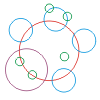
Easily Create Rich Multilayered Living Music
I have been super busy getting IntelligentDesigner* (ID) ready for general consumption. Officially its due this Fall - but you can check out its most recent iteration at two upcoming events. If you are in Pittsburgh (PA, USA), it will be part of The Urban Garden Party at the Mattress Factory this Friday, June 9th. If you are in Williamsburg (Brooklyn, NY, USA) next Friday, June 15th, the show with the ChristianScienceMinotaur is sure to be a trip. (links with details follow).
The Mattress Factory event will incorporate dance, projection and sound, as performance artists move their bodies in relation to the living sounds manipulated in real time.
At Monkeytown ID will be aurally and visually woven into the improvisational musical act of ChristianScienceMinotaur. By way of a bongo-height touch screen kiosk, audience members can alter the music that Nat and Leo (XSM duo) play. The audience gets to DJ with live living musicians.
I am diligently working on getting my website in order to better communicate what this is all about. In the meantime, the best way to understand this new musical paradigm is to go check it out for yourself.
Mattress Factory:
http://www.mattress.org/index.cfm?event=ShowFeature&id=2
MonkeyTown:
http://www.monkeytownhq.com/littlefury.html
ChristianScienceMinotaur:
http://www.littlefurythings.net/
Jason Van Anden's website:
http://www.smileproject.com
* IntelligentDesigner is net software that enables pretty much anyone to control things in an uncontrollable way. ID was originally invented to enable improvisational behavior simulating human emotional mechanics between his life-size emotive robots Neil and Iona. In its current incarnation, ID can be used to easily create rich multilayered living music from samples, with many more esoteric applications coming down the pike. Details will be found on Jason Van Anden's website, smileproject.com, soon.
Jason Van Anden
Posted by jo at 08:17 AM | Comments (0)
MMO Questionnaire

Surveillance in Virtual Worlds
I'm conducting an investigation into surveillance within massively multiplayer online games such as World of Warcraft and Second Life. The questionnaire will take between 2 and 20 minutes to complete depending on how much information you're willing to supply. I'm interested in stories and observations so feel free to ramble.
Read more on my research below, or jump right to the questionnaire.
Many players are unaware of surveillance being conducted by game administrators, often justified as a means to enhance game play and control cheating. Players within some MMOs are also tracking and recording other player’s movements, and conversely, creating methods to protect the privacy of their own digital personas. The rise of surveillance (and counter-surveillance) techniques and technologies within these virtual worlds is an extension of the pervasive monitoring of individuals in real-world environments. Many real-world technologies (such as bugging, video recording and location tracking) are being reproduced in virtual worlds and can be classified as a form simulated surveillance. [posted by Christo on Selectparks]
Posted by jo at 08:11 AM | Comments (0)
IMAGES FESTIVAL 2007
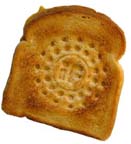
Call For Submissions
The Images Festival annually exhibits a selection of new media art and Live Images as part of the festival. Images works with several Toronto galleries, production centres and other alternative exhibition spaces to show artworks incorporating the moving image and interactive media, music and performance.
Among the artists whose live performances and new media works have been featured in past festivals: Tom Verlaine, Aki Onda, Daniel Barrow, Susie Ibarra + Lori Freedman, mpld, Willy Le Maitre, Hop-FU. The Shalabi Effect, Bruce McClure, Zoe Beloff, Semiconductor, Michael Brynntrup, Bob Ostertag + Pierre Hébert, the presstapes, Saint Dirt Elementary School, GUH, People Like Us, Instant Places, badpacket…
DATES: Deadline for receipt of entries: Early deadline: 30 June 2006; Late deadline: 30 August 2006. The 20th annual Images Festival runs April 5-14, 2007 in Toronto, Ontario, Canada. Submission results will be sent out by mail or email in late January, 2007.
Posted by jo at 08:02 AM | Comments (0)
June 07, 2006
Gaming McDonalds:

RTMark & Abrupt Social Change
On Monday at the International Serious Games Event in England, "McDonald's Interactive" director Andrew Shimery-Wolf announced that "We can no longer stand by while McDonald's corporate policies help lead the planet to ruin." The group, he added, was breaking away from its parent company to directly address the fast-food giant's unsustainable ways. Inspired by the training videogame America's Army, MI devised a game that can simulate various environmental and business conditions and how manipulating different aspects can affect both the bottom line and ecological problems like deforestation. By running sims, they realized that Abrubt Social Change (ASC), not mere "ethical consumerism," is the answer. Shimery-Wolf told attendees at the games conference:
The concept of Abrupt Social Change, or ASC, is an old and respectable one, a shortcut from rationality to the nerve centers of power that has often accomplished what more systemic approaches cannot. The British Occupation of India, the Vietnam War, even feudalism in Europe were only ended through ASC movements.
And just as governments and NGOs have sometimes assisted ASC movements abroad, so we can be a force for Abrupt Social Change here at home. We in the Interactive Division are using all of our autonomy within McDonald's to do so.
1. For one thing, we are appealing to McDonald's franchisees to allow their restaurants to serve part-time as meeting areas where plans for mobilization can be developed, hatched, and acted upon. We have commitments so far from seven owners in Decatur, Illinois, Tucson, Arizona, and Troy, New York.
2. We will offer direct financial assistance from our divisional budget to groups actively involved in effecting ASC, within or outside of franchisee restaurants.
3. We will help develop technologies useful to mass mobilization, such as the cell-phone text broadcasters so useful in the Ukraine in the recent Orange Revolution. As for McMarketplace, it will serve as a tool to explore methods for change, and to learn just how governments might be forced to adequately control corporations.
Again, we strongly feel that legislation is indeed our only hope, and what we must fight for via Abrupt Social Change.
"Ethical consumerism" or other market-based approaches will not help. A recent poll showed that 83% of UK consumers intend to purchase ethically on a regular basis; 5% actually do. And boycotts and other forms of consumer pressure are valiant but ineffectual, capable of producing only momentary, localized changes in corporate policy. As for "ethical investment," its potential is sadly quite small.
No, economic forces won't save us; there's a reason we have governments, voting, and laws that must be obeyed. But since governments won't create the right laws without popular pressure, helping to generate that pressure is the only responsible choice, the only true CSR [Corporate Social Responsibility].
If it sounds too good to be true, that's cuz it is. The presentation, which followed the release of the free McMarketplace video game, is reportedly the work of Yes Men-like art/activist consortium RTMark. As far as I can tell, the actual McDonald's has not yet responded publicly to the presentation.
Download the Powerpoint presentation here. [posted by Paul Schmelzer on Eyeteeth: A Journal of Incisive Ideas]
Posted by jo at 06:00 PM | Comments (0)
Networked things and the old/new objectivism
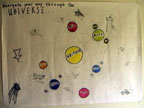
Renaissance?
"...In any case, what strikes me in this "renaissance of things" is the creeping tendency to fetishise (to reify?) the object. This happens too in social software, and user-centred design. Both 'the social' and 'the user' become paramount, yet remain unexamined. More people are citing Latour's influence, often summarised along the lines that objects have agency too, which is technically correct. But Latour isn't interested in objects, he's interested in relations - in actant-networks, collectives of humans and non-humans, and processes of translation.
If we actually follow Latour, or any of the critiques of ANT, then it's not the things themselves that are interesting, but rather the imbroglios they comprise. Julian and Nicolas suggest this when they claim "a new kind of digital, networked ecology in which objects become collaborators," but objects have always been collaborators. The word 'object' comes from Latin 'to throw in the way,' which may explain why people fall back on the idea that we now need to integrate all of these objects into our understanding of the digital. But, at the risk of stating the obvious, the digital is always already material and real. So why a "renaissance" at all?..." From Networked things and the old/new objectivism by Anne Galloway [blogged by Anne on Purse Lips Square Jaw]
Posted by jo at 05:34 PM | Comments (0)
Metaverse meets mash-up:
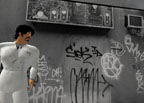
FREE CULTURE REMIX IN SECOND LIFE
Metaverse meets mash-up: come June 15, there's going to be another Free Culture/Creative Commons event in Second Life, this one springboarding off the recent CC Art Show 2006 at NYU and the Sharing is Daring event at Harvard. The object here is to take the art featured at those sites, and then remix it for an in-world showing on the 15th. You can do the remixing with Photoshop and other standard tools, of course, but for this event, the ideal medium is SL itself. Which is what I did with an Untitled photo by Joseph Gergel (above), uploading it as a texture, displaying it in-world, and using it as a backdrop for a dramatic screenshot, above.
No doubt Residents can come up with way better remixes, taking the appropriately-licensed art from here and here*, then converting them into screenshots, 3D sculptures, interactive sites, whatever. I'm looking forward to reporting on what comes out of this.
Deadline for submission is end of June 13. E-mail a screenshot of your entry to Jennifer Yip of Creative Commons (Genevieve Junot in SL), and be sure to include your RL and/or SL name for proper credit. Prizes will be virtual CC t-shirts and other tchotchkes, real and virtual. In any case, do come to the event to share your work, and hopefully meet some the original artists who may also be in attendance. (Full disclosure: I'm now honored to be a part-time consultant for CC's events and activites in SL.) ... [blogged by rubaiyat on New World Notes]
Posted by jo at 01:42 PM | Comments (0)
ambient_light
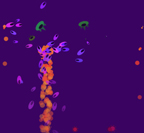
Virtual Ecosystem
ambient_light--by Annie Spinster and Carl Collins--consists of a virtual ecosystem containing a number of classes of organism. The creatures form a complex food web with interactions between individuals leading to emergent properties such as flocking and population cycles. This environment is linked to that of the gallery via a system of pressure sensors which send information to the program through a microcontroller. The system is fed information about which of six chairs is occupied at any time, and certain patterns of chair occupation cause various species to be unleashed. The overall balance of chair occupation also leads to a reactive drift of organisms across the environment.
The installation will be on private view on 13 June 6-8pm at the Summer Show, Sir John Cass Department of Art, Media and Design, Central House, 59 Whitechapel High Street, London E1 7PF (nearest tube: Aldgate East). The exhibition continues 14-16 June 10am – 8pm, 17 June 10am – 5pm, 18 June 10am– 4pm.
At the heart of the project is a store of virtual energy points which flow through the food web, affecting many of the creatures' local variables, and so their appearance and behaviour. The energy points are eventually returned to the virtual environment through death and metabolism. The energy points behave as a catalyst to facilitate interactions and reactions between individuals.
The work is called ambient_light because of the way the light reacts to everything that happens within the environment. These reactions are not really emergent properties as such - they are more like visual clues to emergent properties within the system such as population cycles and the overall flow of energy.
The ambient_light installation consists of a laptop running the Processing software, connected to a large LCD display. Pressure sensors attached to six seating units collect data and send it to Processing via a Wiring microcontroller board.
ambient_light - web version
Posted by jo at 11:39 AM | Comments (0)
ZOT!
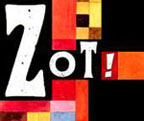
From Nowhere to Nothing
ZOT! was formed in 2005 by Luca Tanzini (theremin+video), Luca Cascino (drum), Nicola Cascino (guitar) and Patrizia Musino (sax) as an improvisational, experimental multi-media ensemble. The final outcome of early 20th Century thought was to make pure cinema as visual music and express oneself through a rhythm that stood for nothing but itself. The project is based around improvisational use of mixed technologies (analogical - digital) that allow to realize and adapt the ideas of the first experimenters in a contemporary live-video-music performance.
ZOT! creates a space where any sound, text, video or texture, is treated as a possible contribution to the ambient situation, every performance must be different, surprise, chance and variety are far more important. The visual aspect will be, instead, created in real time, using ZOT! own original computer-software: RandomCinema and Musica a Colori.
In occasion of their trip to one of the most important avantgarde arts-electronic festival in Europe - EXPO 2006 - Manchester UK. ZOT! will perform in Dublin at lower deck on 23th of June 2006.
ZOT!/LESA (Situationist Space)
"Music-Video and Poetry from nowhere to nothing"
(websites)
http://www.myspace.com/zottovolante
http://www.media.unisi.it/liberarte/zot.html
http://www.media.unisi.it/liberarte/lesa.html
Related projects: CABERNET VOLTAIRE (Free Form, Free Music, Free Everything)
Posted by jo at 09:21 AM | Comments (0)
The Museum of Television & Radio
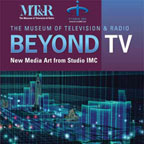
Beyond TV: New Media Art from Studio IMC
The Museum of Television & Radio Presents Beyond TV: New Media Art from Studio IMC An Interactive Gallery Exhibit in the Spielberg Gallery, 6/2 - 8/31, 2006. Visitors are offered the opportunity to experience technologies used in video games, the Internet, social software, and cell phones.
Comprised of five separate pieces--CINE 2.0, Swarm, freeSTYLE, Zig Zag Muzig Block, and LifeForce--this exhibit of interactive art offers visitors the opportunity to experience technologies used in video games, the Internet, social software, and cell phones—all of which will ultimately have an impact on television as we know it today.
CINE 2.0 (Collaborative Immersive Networked Environment, pronounced "sign") by Artists: James Tunick, Miro Kirov, and Houston Riley with Tony Rizzaro and Braden Weeks Earp: CINE 2.0 is a mixed-media environment inspired by Star Trek: The Next Generation’s Holodeck. Multiple users fly through an urban datascape in an immersive environment by using body gestures. Participants in the environment can also collaborate to compose music and, in addition, people out in the city itself can send photographs from their cell phones to be incorporated into the datascape environment.
CINE takes the computer screen out of the box and reconfigures it as a life-size environment. Control of visuals and sound takes place through full-body gestures rather than just mouse-clicks. As the traditional computer screen and mouse-keyboard interface transforms to fill the room, future entertainment platforms like CINE will enhance collaboration among multiple users, opening up whole new worlds of learning, art, creativity, and play. CINE is powered by a network of servers and computers that includes Studio IMC's BlackBox and IMCvote mobile technology.
Swarm by Daniel Shiffman: Swarm paints a digital portrait of the viewer. Stationary viewers will see their portrait, while moving ones will produce an image more like an abstract painting.
Swarm is an interactive video installation that implements the pattern of flocking birds (using Craig Reynold’s “Boids” model) as a constantly moving brush stroke. Taking inspiration from Jackson Pollack’s “drip and splash” technique of pouring a continuous stream of paint onto a canvas, Swarm smears colors captured from a live video input of the person looking at the screen, producing an organic painterly effect in real time. The person viewing the screen becomes part of the art.
freeSTYLE by Dana Karwas: freeSTYLE is a music video created entirely from cell phones. Video clips and text messages are sent in by cell phone, which are then sequenced at random and mixed with music to create a living, abstract music video. Participants can send a video or text message to 1[at]dk22.com.
Cell phones offer an extension of one's identity. Users can send messages to freeSTYLE and, in return, they will hear and see their messages free-styled back to them with an added beat. Guided by a hip-hop beat of choice, the user can hear and see their mobile presence in the form of a living music video.
Zig Zag Muzig Block (ZZMB) by Inhye Lee : Going beyond the tradition of the children's mix-and-match toy, ZZMB allows the viewer to create new characters from four existing singing characters by rotating or sliding each block. Playing with ZZMB's blocks also creates new musical compositions.
Each top, middle, and bottom block plays a different character's voice, harmony (chord), and rhythm (beat) of music, which are written as parts of complete scores. Users can make variations of the sound by applying different voices, chords, or rhythms from other blocks. When blocks are matched to compose one of the original, matching characters, users can hear the full original score. Slide the blocks to the side to make more musical variations.
LifeForce by James Tunick: LifeForce transforms the cell phone into a digital paint brush and musical instrument. The work comes alive only when the viewer participates, waving a cell phone to "paint" with light and sound. Multiple users can control the pulsing visuals as well as push sounds across the space.
Powered by Studio IMC's BlackBox media player and custom software, the installation invites viewers to collaborate utilizing a flatscreen, stereo sound, and cell phones. The work is a commentary on the need for more participatory art forms in contemporary museums, and strives to validate the mobile device as a tool for creative expression. LifeForce envisions a future in which such artistic tools are common to public spaces like city sidewalks and sides of buildings.
Studio IMC (Interactive Multimedia Culture)—a New York City-based new media agency comprised of an international team of artists and software engineers—envisions the future of group entertainment and collaboration and imagines what's waiting for us beyond the relatively passive, "hands-off" experience of watching TV. Studio IMC fuses old and new media concepts and technologies to create a brave new world of participatory—at times even immersive—media consumption. There are no "Do Not Touch" signs here—instead, you're encouraged to touch everything and actually become part of the artwork yourselves.
Posted by jo at 08:38 AM | Comments (0)
June 06, 2006
Sousveillance/Surveillance

Interventions
[...] For an intervention on images, and in a sousveillance / surveillance context this time, Austrian activists Quintessenz created an anonymous surveillance system that uses a face-recognition software to place a black stripe over the eyes of people whose images are recorded (via Wired).
New Scientist reported today on a video surveillance system that scrambles people's faces to protect them from unwarranted monitoring. Developed by Swiss company EMITALL Surveillance, the algorithm of the technology singles out any people in a video feed, on the basis of their movement, and disguises them digitally while leaving the rest of the scene intact (Videos 1, 2 and 3). Only those in possession of the encryption key can unlock the scrambled regions and identify the people shown on-screen.
The system can even use different encryption keys to scramble the identity of particular people under surveillance, says Touradj Ebrahimi, founder of EMITALL Surveillance (thanks Emily!)
More broadcast disruption: SVEN - Surveillance Video Entertainment Network, a real-time video performance system that detects when people look like rock stars instead of criminals. Once a potential rock star is detected, music video effects are triggered so the surveillance stars get a treatment worthy of Cecil B himself; TV Predator, a picture frame that attacks the tv and prevent it from working properly; OiTV, a misbehaving attention-seeking TV. [blogged by Régine on we-make-money-not-art]
Posted by jo at 12:42 PM | Comments (0)
Digital Maosim: The Hazards of the New Online Collectivism
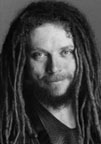
Collective Action or Collectivism?
"In "Digital Maosim", an original essay written for Edge, computer scientist and digital visionary Jaron Lanier finds fault with what he terms the new online collectivism. He cites as an example the Wikipedia, noting that "reading a Wikipedia entry is like reading the bible closely. There are faint traces of the voices of various anonymous authors and editors, though it is impossible to be sure".
His problem is not with the unfolding experiment of the Wikipedia itself, but "the way the Wikipedia has come to be regarded and used; how it's been elevated to such importance so quickly. And that is part of the larger pattern of the appeal of a new online collectivism that is nothing less than a resurgence of the idea that the collective is all-wise, that it is desirable to have influence concentrated in a bottleneck that can channel the collective with the most verity and force. This is different from representative democracy, or meritocracy. This idea has had dreadful consequences when thrust upon us from the extreme Right or the extreme Left in various historical periods. The fact that it's now being re-introduced today by prominent technologists and futurists, people who in many cases I know and like, doesn't make it any less dangerous"." From John Brockman's Introduction to Digital Maosim: The Hazards of the New Online Collectivism by Jaron Lanier, Edge. See Collective Action is not Collectivism by Howard Rheingold. Other responses, 2.
Posted by jo at 11:46 AM | Comments (0)
Recombinant Media Labs
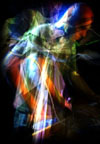
Thomas Brinkmann + Thomas Koner
Fresh from headlining at Montreal’s MUTEK festival and his hometown in Cologne, Germany, you are invited to attend a very special educational event where Thomas Brinkmann himself will pilot a series of provocative real time “sessions” on the science of sonic propagation hosted by Recombinant Media Lab's [RML] director of operations, Naut Humon. Come and meet Thomas as he demonstrates mixes and manipulations on the extraordinary SURROUND TRAFFIC CONTROL immersive sound system. This is pure beat banging, texture mapping techno that’s totally out of the ordinary and then the KLICK format utilizes his experimental vinyl cutting techniques. Don’t miss this chance to be up close and personal with the music.and its creator in a high resolution research environment.
Though he’s been famed for productions on his own Max Ernst and Suppose labels, Brinkmann gained a prominence in the experimental and electronic community for his full-length remixes (or as he terms them, “variations”) of material by Richie Hawtin and Mike Ink. The variations were made possible by playback of the original records on a turntable of Brinkmann’s own design, which included two tone arms with separate outputs for left and right channels…. With the two arms playing the track simultaneously from two different positions, previously nonexistent patterns are extracted from the music.
He is a former artist of the famous art school in Düsseldorf, but got kicked out because of his radical arguments and modern thinking in terms of art. He started doing scratch loops in the beginning of the 80s because he liked the idea of a step sequencer. Mathematically thought out, he developed a precise art of scratching the the grooves with a sharp knife-like instrument into the vinyl. Complex grooves were the result and he started to do variations with the Studio 1 records, by using his special designed record player with the two systems. He turned down the speed and came up with a dopplereffect which sounded like dub.... His sound can be described as machine music with just a little bit of organic bump enough to make you jump & move. Each bass drum, each hi hat is detectable. This goes from very abstract minimal music to a more Krautrock electronic approach. Accomplished artist and generous performer, Thomas Brinkmann likes to say that it’s all a question of turning knobs with precision and subtlety. If fate plays in his favor, no doubt that all spectators confronted by his savoir-faire will have little chance against being magically struck by the force of his devastating dynamics.

THOMAS KONER: FROM THE OUTSKIRTS OF NOTHING TO THE SUBURBS OF THE VOID: absence and emptiness.in cinematic space at RECOMBINANT MEDIA LABS, SF. a LIVE AUDIO / VISUAL WORKSHOP PERFORMANCE IN TWO SESSIONS OVER TWO EVENINGS Thursday, June 22nd at 8:00 pm and Friday, June 23rd at 8:00 pm . $15 per session in advance on Paypal. Reservations are strongly suggested! Capacity is limited.
Thomas Koner is one of the most respected electronic composers in the genre, over the past 15 years, Koner's dedication to intensive sound research and collaborations with leading filmmakers has placed him at the epicenter of where sound and contemporary art collide. Beyond that, he is half of the legendary techno act Porter Ricks, their releases on Chain Reaction and Force Inc. have electrified and influenced a vast array of producers and admirers. His current works that combine and extend auditory image experiences has been awarded the top prizes at Ars Electronica, Transmediale, and numerous significant film festivals. A number of those international exhibition video works will be shown here in a performative context at RML's surround cinematic symposia.
Recombinant Media Labs seeks to foster the creative evolution and development of cutting edge techniques for real time spatial media synthesis; techniques which incorporate and push the formal aesthetic/technical boundaries of surround cinema, immersive audio/visual environments and live musical performance. [via Rhizome]
Posted by jo at 11:04 AM | Comments (0)
Nathaniel Stern
![]()
Between Text and Flesh
"Staged via various media, Nathaniel Stern’s work enacts the interstices of body, language and technology. It seeks to force us to look again at the relationships between the three, and invites us to experiment with their relation. His body of work can, perhaps, be described as an exploration of the interstitial itself–revisiting between technology and text the dangerous spaces of enfleshment, incipience, and process.
Stern’s revisitations plunge us into a confrontational world of performance where Stern, as actor, provocateur and artist, invites us to enter into the performance and engage in the seriousness of play. The work encourages the viewer to interrogate their perceptions of the everyday and the relations they have with themselves, to others and the world around them..." From Between Text and Flesh by Nicole Ridgway, NY Arts Magazine.
Posted by jo at 10:55 AM | Comments (0)
Remote
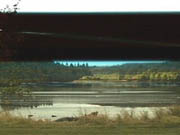
From Installation to Itinerary
Remote--Plimsoll Gallery, Hobart, Tasmania; 3-23 June 2006: 'Remote' brings together artworks by five artists that connect the local and global through digital media – Susan Collins (UK), Pete Gomes (UK), Derek Hart (UK/Tas), Nancy Mauro-Flude (Tas/Netherlands) and Martin Walch (Tas).
These artists explore their relation to the real world and their works demonstrate how that transaction might be constituted today when any firm sense of presence (real space) and immediacy (real time) is exacerbated by technologies that problemmatize notions of nearness and remoteness, such as the televisual, tele-communications and global positioning systems. What is a common point of departure for all is a confounded sense of place and proximity. The resulting inventory includes screen and projection-based moving image work, webcast transmissions, site-specific interventions and locative media.
Curated by Vince Dziekan (Monash University, Melbourne), the exhibition’s distinctive scenography is characterised by its distribution across the Plimsoll Gallery and its surrounding environment. This incorporation of other locales in the immediate proximity of the Centre for the Arts into the overall sweep of the ‘expanded’ exhibition results in the transformation of the exhibition from being experienced as an installation into something more likened to an itinerary.
This is further supported by the addition of a locative media artwork by the artist/curator created specifically to direct and focus the exploration of this broader ‘ecology’ of spaces. The work promotes the mobility and agency of the viewer by linking distributed media contents to a series of locational markers that situate this narrative across the ‘in-between’ spaces of the exhibition.
The exhibition experience is supplemented and extended by an exhibition website, designed by Superbia. Extensive information about the artists and inventory is available, plus descriptions regarding the exhibition’s scenography and locative media aspects. Two essays have been commissioned for the online catalogue: a curator’s essay by Vince Dziekan and a contributor’s essay by Scot Cotterell (Tas).
For a press package or more information, contact: Vince Dziekan [vince.dziekan[at]artdes.monash.edu.au]
Posted by jo at 10:32 AM | Comments (0)
Ursula Endlicher
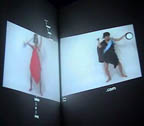
HTML Movement + Impersonations
Join Ursula Endlicher for this year's "studios on view". She'll be introducing a new work-in-progress, html_butoh, in which she will re-create the structure of original websites using a movement alphabet based on the "html-movement-library." She will explain how everyone can submit their versions of html-performances to this library.
Ursula will also perform an excerpt from her new series Website Impersonations: The Ten Most Visited which is again built upon the ideas of the html-movement-library, incorporating them here within the enactment of a popular website.
Other artists showing work are June Ahrens, Peggy Cyphers, and Suhee Wooh. Where: 315 Broadway, 5th Floor (between Duane/ Thomas Street); When: Saturday, June 10, 4-8 PM [Ursula's performance is scheduled for 7 PM.]
Posted by jo at 10:20 AM | Comments (0)
EXTENDING EXPERIENCES

CALL FOR PAPERS
While players of video games have always been waiting for the next generation of technology, less fuss is made about next-generation experiences. If such experiences are already there, what are they like? What would be the 21st-century-equivalent to the experiences of Andy Capp's Tavern's customers who rushed into the bar to play Pong until the machine got jammed with coins? Ask a script writer, a political mod artist, a middleware developer, a computer game researcher, and someone who has traded off his social contacts in real life for a high-level character in a MMOG – and you will be overwhelmed by the diversity of what makes an experience worth striving for.
Department of Media at the Faculty of Art & Design of the University of Lapland and Mediapolis Innomedia project will publish a multidisciplinary book on player experiences in early 2007. The book will be a compilation of peer-reviewed articles. Respecting the department of Media's tradition of combining research with design, the book aims to piece together contemplations from researchers, designers, and those in-between, within or outside the academia.
On one hand, the extending might mean creating games that allow new kinds of experiences or are more emotional, maybe by implementing innovations regarding for example gameplay, graphics, sound or the interface. Also the players are creative. Their use of games in a way designers did not intend alters their experiences. On the other hand, the extending takes place concept-wise. In the wake of new forms of games and playing new types of players get introduced to digital games. Thus, the concept of player experience has to assimilate very different takes on how, where, when and why games are played and experienced. No matter from which viewpoint one looks at the player's experience, it seems that it poses challenges for those trying to observe or analyse it, not to mention those who are trying to understand it in order to be able to design something new.
Topics that the authors are invited to be address from the viewpoint of the players experience include, but are not limited to the following, and case-studies with an artistic or an industrial perspective are also welcomed.
Games
- Game genres and gameplay concepts, abstract games, story-based games
- Game design "trends", e.g. movie-like games with no HUDs
- Graphics and sound; audiovisual styles, cel-shading, photorealism, sound-based games
- Different player setups; one or many, local or online, one-vs-one, team-vs-team, etc.
- Avatars and other player representations
- Innovations; new gameplay concepts, platforms, input devices, interfaces, AI
- Different types of games; online multiplaying (both hc & casual), mobile and portable games, pervasive and VR games
- Content; games not only for entertaining, i.e. "seriousness" of games, in-game advertising
Players
- Different player groups and motivations; e.g. newbie, casual, hc, professional, senior, grrl, and mom gamers
- The role of "fun" in players' experiences
- Player identities
- Games as media for human relations
- Players' goals, emotions, motivations, expectations
- Consequences of playing
- Borderline activities; guild/clan webfora, mods, machinima, real-money trade of in-game assets
Methodological challenges for research and design
- Games as form of art, propaganda or education
- Design research from all viewpoints
- Philosophy of the experience
- Game-related experiences vs. other experiences
- Player's experience compared to user's/reader's/viewer's experience
- The applications of cognitive psychology, affective computing, HCI, Media Studies, etc. on understanding the players' experiences
IMPORTANT DATES
All papers will be reviewed by an independent review committee, which will provide written feedback on each paper. NB: Due to popular demand, the abstract submission deadline has been extended from the original.
June, 19. 2006 Abstract submission (was: June 5th)
June, 26. 2006 Notification of acceptance (was: June 12th)
Sept, 5. 2006 Submission of full papers
Jan, 10. 2006 Submission of final papers
SUBMISSION INFORMATION AND FORMATTING GUIDELINES
Abstract
The abstract will summarise the contents of the paper and should contain from 150 to 200 words.
Please submit the abstract along with the additional information in plain text format using the electronic submission form on the website.
For more details, please visit the book's web page.
INFORMATION ABOUT THE REVIEW BOARD
The line-up of the review board will be announced later on the book's web page.
INFORMATION ABOUT THE EDITORS
Please visit the book's web page to view the editors' bios.
Posted by jo at 09:55 AM | Comments (0)
Mikon Hall of Worlds
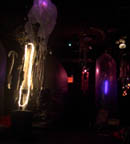
A Living Cabinet of Curiosities
Mikon Hall of Worlds is a monthly exhibition (next event: Sunday July 9, Noon to 6PM] of computer controlled exo-oceanic life created out of found objects, fans, motors, pantyhose, and horseshoe crab shells.
Mikon--created by IFAM--is a micro-museum of computer and voice driven kinetic sculpture, sound, and a viewer-manipulated virtual zooarium of imaginary life forms. Inspired by the Wunderkammern of the 18th century, Mikon is a super-condensed macrocosm, a storefront cabinet of curiosities. Mikon seeks to instill the wonder of speculative biology in its viewers, who have both the opportunity to animate aspects of the exhibition and to observe the unpredictable behavior of its components. In creating an otherworldly ecology, Mikon promotes the appreciation of the real ecologies that it emulates.
A computer has been programmed to simulate a small system of living things, which cycle through quiescence and activity. Attendees can affect this system through triggering sensors and uttering voice commands. Mikon is a growing thing, becoming more nuanced with every show, expressing itself through new visual, sonic, and sculptural elements.
Date and Time: Sunday July 9, Noon to 6PM
Location: Collective: Unconscious, 279 Church St., just south of White. Take the 123456ACEWRNQ to Canal Street, Franklin St., or Chambers St.
Price: $5
Contact:
Phone: 347.245.7078
Email: Daniel Green, hebdemnobad[at]yahoo.com
Posted by jo at 08:45 AM | Comments (0)
June 05, 2006
Evolving Sonic Environment

Room to Develop "Perception" of its Occupancy
Evolving Sonic Environment -- Usman Haque with Robert Davis, Psychology Department, Goldsmiths College, London -- consists of two embodiments: a society of sonic devices distributed in a room and a mechanism for recording and reviewing the history of the population. It is hoped that the collective behaviours of the devices will be affected by the way that the room is occupied (by people or other mobile objects) and, as such, the room will develop a "perception" of its occupancy. One might say that the society of devices together function as a "people sensor", though there are no "people sensing" functions built into the individual devices.
Drawing on the work of Gordon Pask, Donald Hebb and Andrew Adamatzky, the project is an architectural experiment to investigate how one might construct an interactive environment that builds up an internal representation of its occupants through a network of autonomous but communicative sensors. [Read more >>]
Posted by jo at 05:03 PM | Comments (0)
Second Life Exhibition Opportunity

'The New West: An Exhibition of Virtual Folk Art'
Artists are invited to submit work for a specially created area of the online community Second Life (SL).
Art must be created within SL, using easy-to-learn modeling tools. Textures can be made in paint programs and uploaded to the SL world for use. Ideas will be accepted approximately one-two months before the conference date. Artists will be instructed how to set up their own avatar in SL, and given parameters for the actual artwork creation. All work is due before the conference to allow the jurors time to adequately examine and interact with the works. Criteria will include orginality, skill, aesthetic qualities, and interaction. Example images will be posted in the near future. This competition is hosted by the game collective, Ludica, with support from Linden Labs, makers of Second Life.
The best of show will be on display at the San Jose Museum of Art throughout the ZeroOne / ISEA2006 Conference.
Posted by jo at 03:31 PM | Comments (0)
New Cartographies of Networks and Territories

ELSE/WHERE: MAPPING
The blog ELSE/WHERE: MAPPING promotes the book of the same title. The book charts the ascendancy of mapping (in the digital age) as a fundamental design process--a powerful interdisciplinary strategy that links people and places, data and organizations, and physical and virtual environments.
The site outlines the contents of the book's four sections [networks, conversations, territories, mapping] juxtaposing archival maps and experimental prototypes to open a new dialogue among disciplines.
The book also includes a visual representation of the text.
Posted by michelle at 03:08 PM | Comments (0)
When Ghosts Will Die
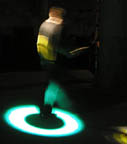
Stories Stitched Together "on the fly"
When Ghosts Will Die, a performance-installation that utilizes multi-sensory elements such as sound, video, light, and text controlled by motion-tracking technology, tells the story about the dangers of nuclear proliferation. Inspired by the play, "Copenhagen", by Michael Frayn, it explores the use of non-linguistic elements in the service of making poetry and telling stories. The artists and programmers involved on the project include Steve Gibson, Dene Grigar, Will Bauer, Jim Andrews, and John Barber.
"When Ghosts Will Die" involves one-two performers and envisions the space as a 3D grid simultaneously within a central computer and a physical performance space. The performers move through this environment and evoke the multi-sensory elements with hand-held tracking devices and in so doing interact with these elements through three potential phases of nuclear proliferation: 1) Disharmony, 2) Destruction, and 3) Disintegration. These three phases are intended to evoke the first nuclear explosion, the "Trinity" test in New Mexico on July 16, 1945, that took place just weeks before the nuclear bombs exploded over Hiroshima and Nagasaki, Japan.
Using the tracking device, the performers can move through the space choosing the element they wish to utilize for telling the story. In this way, the story takes on a rhapsodic quality: it is literally stitched together "on the fly" and changes wtih each telling. The mood of the space is designed to match the phase that the performers reach. Disharmony, for example, offers slightly discordant sounds that increasingly give way to cacophony, as well as video footage representing growing belligerence. Destruction sees the dropping of the bombs and corresponding sounds of buildings falling into rubble. The final phase, Disintegration, takes performers to the motif of the work: that the destruction derived from these weapons will be so complete that even "ghosts will die," an allusion to Michael Frayn's "Copenhagen" that sits at the heart of this project.
The story is meant to shock those participating into a deeper awareness of the horrors of nuclear warfare. Politically speaking, the work's message – that the development and deployment of weapons of mass destruction not only test a country's power but also its humanity – speaks to artists' "responsibility to envision alternative futures... and shape the way people think, live, and interact" (Edward Shanken). [via]
Posted by jo at 12:31 PM | Comments (0)
Re:Project
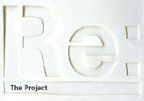
Locating déjà vu
The Re:Project is a technological probe and visual database of recounted moments of déjà vu experienced by you. Signs planted around San Francisco pinpoint exact locations of previous moments of déjà vu, and are color coded in relationship to which type of phenomenon occurred there. On each Re:Project sign is a URL and GPS coordinate. By using a mobile phone, you can text message your location and any relevant information/ description of your experience to the URL provided. This catalogues your déjà vu experience, and connects you to the Re:Project community, where you receive text message notifications of the déjà vu phenomenon as they occur around the city. Each text message includes the location of the occurance and a statment or question, which is meant to challenge your established understanding of the site and provoke a new, or at least different, view of your environment.
The Re:Project hopes to reinterpret the phenomenon of déjà vu through existing technologies, forging connections between mental and physical spaces that are otherwise left undiscovered. [via textually.org]
Posted by jo at 12:00 PM | Comments (0)
Shilpa Gupta
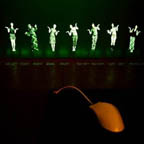
The Dwindling Power of Individual Reason
Bose Pacia presents recent work by Shilpa Gupta from May 17th through June 24th. Shilpa Gupta creates artwork using interactive websites, video, gallery environments and public performances to probe and examine subversively such themes as consumer culture, exploitation of labor, militarism and human rights abuse. In her debut solo exhibition in New York, Gupta presents an interactive video installation as well as other multimedia works and photography.
Her Untitled, 2004-2005 (interactive video) is an interactive new media installation in which the viewer is invited to manipulate a large wall projection. The projection features several figures in fashionable camouflage clothing engaged in various poses. The absurdity of their gestures and costumes recall both the mimicry games of childhood and the unforgiving rigor and conformity of military drills. In enabling the viewer as a participant, the work comments upon the dwindling power of individual reason in the face of 'mindless violence' borne out of fundamentalism and imperialism.
Her Untitled, 2005-2006 (touch screens) initially appears benign in content. One screen presents a bucolic landscape, another, the laughing faces of children, a third, a misty window. As the viewer touches each screen to initiate activity, darker truths emerge. The lush countryside of Kashmir is dotted with military guards and the smiling children are innocently posing alongside the remains of a bomb blast. From the misty window, a finger follows that of the viewer to spell out a militaristic alphabet: A for army, B for bomb, C for curfew. Gupta guides her audience to reveal the fear and uncertainty that pervade everyday life in this contested terrain and more broadly, demonstrates how truth is a fragile construction utterly dependant on the direction and intensity of one?s gaze.
Shilpa Gupta was born in Mumbai, India in 1976 and studied sculpture at the Sir J. J. School of Art there. She has exhibited widely and recent shows include the Havana Biennial (2006), ICC Tokyo (2005), Edge of Desire (New York, 2005) and Century City at the Tate Modern (2001, London). She was also commissioned to create Blessed Bandwidth.net, a net art project for Tate Online. In 2005 she was a runner-up for the Leonardo Global Crossings Award, Leonardo Magazine, MIT Press and in 2004, she was awarded the prestigious Transmediale Award in Berlin. Upcoming projects include the 2006 Sydney Biennial, the 2006 Liverpool Biennial and a two-person exhibition at Daimler Chrysler Contemporary in Berlin. Gupta currently lives and works in Mumbai.
Bose Pacia is located at 508 West 26th Street on the 11th Floor, in the Chelsea district of New York City. Gallery hours are Tuesday through Saturday from 12 to 6 pm and by appointment.
Posted by jo at 11:39 AM | Comments (0)
Is MySpace a Place?
![]()
spatial nature of MySpace
Networked Performance pointed me toward an interview (download in PDF) with Networked Publics speaker Henry Jenkins and Networked Publics friend danah boyd about Myspace. The site, popular with teenagers, has become increasingly controversial as parents and the press raise concerns about the openness of information on the site and the vulnerability this supposedly poses to predators (Henry points out that only .1% of abductions are by strangers) and the behavior of teens towards each other (certainly nothing new, only now in persistent form). In another essay on Identity Production in Networked Culture, danah suggests that Myspace is popular not only because the technology makes new forms of interaction possible, but because older hang-outs such as the mall and the convenience store are prohibiting teens from congregating and roller rinks and burger joints are disappearing.
This begs the question, is Myspace media or is it space? Architecture theorists have long had this thorn in their side. "This will kill that," wrote Victor Hugo with respect to the book and the building. In the early 1990s, concern about a dwindling public culture and the character of late twentieth century urban space led us to investigate Jürgen Habermas's idea of the public sphere. But the public sphere, for Habermas is a forum, something that, for the most part, emerges in media and in the institutions of the state:
The bourgeois public sphere may be conceived above all as the sphere of private people come together as a public; they soon claimed the public sphere regulated from above against the public authorities themselves, to engage them in a debate over the general rules governing relations in the basically privatized but publicly relevant sphere of commodity exchange and social labor. The medium of this political confrontation was peculiar and without historical precedent: people's public use of their reason (öffentliches Räsonnement). In our [German] usage this term (i.e., Räsonnement unmistakable preserves the polemical nuances of both sides: simultaneously the invocation of reason and its disdainful disparagement as merely malcontent griping. (Habermas, 27)
Nevertheless, the salon, the café, and the parliament were key places that instituted this kind of discourse, and they succeeded the court, which was explicitly spatial.
But Myspace and the new sites of network culture are different from the media of old. If they are—in general—not places of rational discourse, they are venues in which publics gather. Is Myspace media? Yes. Is it a place, maybe? In my book, MMORPGs such as World of Warcraft definitely are. So do we exclude myspace just because it is not rendered in three dimensions? Are spaces media themselves? Are media spaces? Could be (think of the Seattle Public Library). I don't have any easy answers on this, even as Anne Friedberg and I work on our essay for the upcoming Networked Publics book.
[blogged by Kazys Varnelis on Networked Publics]
Comment by danah boyd:
spatial nature of MySpace
Over on Networked Publics, Kazys Vernelis asked Is MySpace a Place? I wrote a comment in response that others might find interesting. (And perhaps prompt folks like Anne to put me in my place.)
I would argue that MySpace is a 'place' in that it's a locatable site that people "go to" and it has structural walls regulated through being logged in, being inside the domain, etc. But I would argue that this is not that important. Instead, I would focus on how MySpace is an 'imagined space' (stretching Anderson's 'imagined communities') where the space is framed by the perceived rituals, norms and acts that constitute MySpace participation. [I would also argue that MySpace is a 'medium' in a McLuhan sense because of its role in 'extending man' into the virtual for social engagement. In this way, participation might destroy the platial nature of MySpace by letting people participate in imagined communities where MySpace is simply a channel through which communication and performance occur. But it does not destroy the spatiality invoked.]
I think things get confused by bringing Habermas into the fold because his definition of spatiality is rooted in the public sphere which is entirely framed by discursive engagement. He sees identity as constructed in private such that the public sphere is the gathering of private individuals for the purpose of verbalized communication. Nancy Fraser is useful in this way because she argues that a core component of publics is the way they allow individuals to negotiate identity. Pulling in Goffman in response to Fraser, spatiality is constructed by shared situationalism through which impression management can take place.
This is where I end up talking about 'digital publics' because the nature of public life in a new networked age relies on architectural properties not normally present in (unmediated) social life - persistence, searchability, replicability, invisible audiences. While we can turn to celebrity culture and mass media's role in collapsing contexts (Meyrowitz) to get a grasp on what's going on, negotiating these types of publics is new for most people. Digital publics are tricky because they rely on a networked structure, not a group structure dictated by audience or location. The same turn that complicates digital publics complicates issues of spatiality. In short, what are the boundaries? This is why i'd argue that it's an 'imagined space' instead of a space as we normally conceptualize it.
[How terribly am I misreading theoretical ideas of space and place?] [blogged by danah on apophenia]
Posted by jo at 11:12 AM | Comments (0)
Live Performance

hymn[two]
On Tuesday June 6, 2006 at 9:00pm new media artist Jason Sloan will perform the next work in the hymns series of telematic performance works. hymn[two] will be broadcast live on the web. The hymn series will conclude later this summer with hymn[three] which will also be broadcast live on the web.
Leading up to the event jason will occasionly be online in his studio testing the equipment so feel free to check out the feed. if you just see an "x" broken image icon or grey box, don't panic, the camera is just offline. Jason is planning more live telematic actions summer. Be sure to check out the web site for more information.
Posted by jo at 10:59 AM | Comments (0)
Book Review
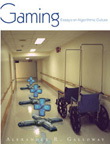
Gaming: Essays on Algorithmic Culture
Review of Alexander R. Galloway's Gaming: Essays on Algorithmic Culture by Thomas Beard, commissioned by Rhizome.
The literature of video games is a curious one. Ranging from Martin Amis's all but forgotten debut, Invasion of the Space Invaders -- a compendium of hot tips for arcade classics like Defender -- to the coin-op psychologizing of Charles Bernstein's "Play It Again, Pac-Man" and beyond, it somehow manages to encompass at once the enthusiasms of that British belletrist and analyses from every imaginable clique of critical theory. Different as those two camps might be, a recent addition to this growing body of work, Alexander R. Galloway's Gaming: Essays on Algorithmic Culture, has drawn from both. An NYU professor, media theorist, and founding member of Radical Software Group (RSG), Galloway states from the outset that his is a book "about loving video games," setting him firmly apart from the more clinically-minded of his peers. That said, the book is hardly the stuff of fanboy effusion, but rather a skillful address to the broad intellectual histories of gaming and a likely source of new debates.
Beginning with the idea that video games are actions, as opposed to traditional forms of image or story, Galloway attempts to outline a poetics for the medium. Much like the film scholars of previous decades, making their case about the unique qualities of the art they treasured, he situates the study of games as needing new conceptual frameworks, new models of thought, presenting a four-part schema to outline the nature of action within them. He claims that the medium¹s most fundamental relationships exist between two axes, that of the operator-machine on the one hand, and the narrative world of a game‹its diegesis‹and exterior properties, on the other. Simply put, each quadrant translates to one type of action. There are diegetic-machine acts, ambient rustlings where the game is running without operator input (day turns to night, a fireplace crackles), nondiegetic-operator acts like setting preferences or choosing weapons, diegetic-operator acts like moving or firing those weapons, and finally nondiegetic-machine acts, which include both disabling acts like 'game over' and network lags as well as enabling acts like power ups. Structured with an Aristotelian rigor, these categories could prove quite pertinent to the future of video game criticism, accounting as they do for the cybernetic dynamism so basic to the experience of gameplay.
Equally thoroughgoing is Galloway's history of the first-person shooter, whose roots he traces through a study of subjective camerawork in film. Citing such examples as Notorious' drugged-up Ingrid Bergman, Robert Montgomery's failed noir experiment, Lady in the Lake, and the knife-wielding predators of Psycho and Halloween, he positions the perspective as almost exclusively marginal within cinema, frequently used to depict mental affection, detachment, or monstrosity. Of course, according to Galloway, there is one exception to this otherwise awkward way of seeing, the cyborg. He argues that we view the subjective POV of Robocop and the Terminator, all bleary video and cursor prompt, as more acceptable than that of a character in, say, Dark Passage precisely because conflating the machine of the camera with an already mechanized body makes for a far less dubious pairing than with that of a human. So it's through a movie like Predator that Galloway sees a link, aesthetically speaking, to video games, where the first-person perspective is hardly marginal. Instead, it's quite crucial to the vision, the action of play. "Where film failed," he writes, "games succeed." A thoughtful mapping out of Marshall McLuhan's proposal about finding old media in new ones, the essay points toward the larger project in digital aesthetics, a quest of origins.
Traditional notions of realism are parsed in a similar fashion, revealing their unique relevance to gaming. Looking outside the verisimilitudes offered by ever-increasing polygon counts, Galloway considers gaming "a third moment of realism," after those based in image and narrative. Since the gamer is required to act, not simply look or read, Galloway sees the realism of a game as inextricably bound to the social context in which it is played. "Any game that depicts the real world must grapple with this question of action," he maintains, positing that America's Army, despite its high-end design, is actually not realist insofar as it's disconnected from the lived realities of the vast majority who play it. Games like Under Ash, however, by setting their conflicts within the Israeli occupation, are occasions for genuine realism, at least by the Palestinians who play them, if not others.
Theories of allegory are also revised and updated by Galloway in what is perhaps the most provocative essay in the collection. Following Gilles Deleuze and expanding some of the ideas in his earlier book, Protocol, he contends that video games are consummate expressions of what it means to live in a network society. Deleuze saw the highway as epitomizing a major phenomenon of late twentieth century culture, allowing endless mobility that was nonetheless entirely controlled. So too with video games, Galloway argues, which, despite appearing to offer a liberating smorgasbord of option and outcome, simply hide the lateral system of information control that characterizes contemporary existence. Unlike earlier, "deep" allegory, as typified by forms like cinema, what Galloway calls "allegories of control" are not ideological manipulations, but a complex process of masking new forms of control as an escape from older ones. Though I wonder about this last point, and the limits it places on the possibility of alternative play.
By centering a means of control in the deep-seated architectures of gaming, Galloway recalls older critiques of Hollywood. He puts forth, for instance, that a seemingly progressive update of the imperialist Civilization would still be subject to the same regulatory principles as the original. In much the same way, certain theorists in the seventies saw narrative film of all stripes as a political dead end. Outlandish as the claims of Laura Mulvey and company might look now, they instigated critical dialogue that was nothing short of vital; perhaps Galloway's article will do the same.
The book then closes, appropriately enough, with a discussion of counter-gaming, something of a new media analogue to counter-cinema, a la Peter Wollen, in which Galloway considers the work of artists like JODI, Cory Arcangel, and Anne-Marie Schleiner. But no matter how virtuosic their respective manipulations might be, for Galloway, a true avant-garde of video games is still ahead of us. Moving beyond a dominant preoccupation with visual elements, he ends by calling for creative intervention into more basic concerns: "We need radical gameplay, not just radical graphics." Such a statement leads one to think about what the future holds for video game criticism as well. Who will be the Greil Marcus of Mario? The Sontag of Shenmue? The Hoberman of Halo? Those are all questions that will no doubt answer themselves in coming years, but, given his project of analyzing the poetics of these particular social forms, one might say already that, in Galloway, the medium has found a contender for its Fredric Jameson.
Thomas Beard is the Program Director of Ocularis, a non-profit media arts organization based in Brooklyn. He has also served as a programmer at the Cinematexas Film Festival, and curated screenings and exhibitions at such as venues as Aurora Picture Show and the Museum of Modern Art, New York.
Thomas Beard
Program Director
Ocularis
at Galapagos Art Space
70 North 6th Street
Brooklyn, NY 11211
http://www.ocularis.net
Posted by jo at 10:43 AM | Comments (0)
Designing the Not-Quite-Yet
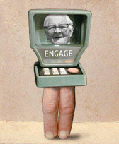
Call for Participation
Call for Participation in a workshop--Designing the Not-Quite-Yet: Ideas and Methods for engaging the Public in a Digital Future of their Choice--on 14th September, during HCI2006.
How do we broaden the constituency of design? How do we help people engage with social and political transformations engendered by technology? How do we enable the appropriation of an invasive, yet intangible, 'internet of things’? This workshop will explore the potential of innovative methods, such as performance, public art, games, etc, to: * deliver methods that help people do 'design thinking' * widen the design franchise * base the design of future technologies more closely on society's needs and desires.
The day is intended to open discussion on how to engage more people in design in the context of an increasingly digital world – one in which designed information spaces surround the ordinary spaces we occupy. Ambient intelligence, pervasive computing, augmented reality, smart buildings and clothes, identity tagging, … the digital future is promised as connectivity 'anytime, anywhere', as seamless flows of information between environments, objects and people. More than ever this will see social practices and institutions embedded in technology.
The social challenges arising from these developments have been noted, but Human-Computer Interaction (HCI) specialists have not fully engaged with the question of how to design for them. These challenges are particularly interesting because they require users to think like designers or submit to being run by the software surrounding them. This workshop asks how we can create the competent and empowered 'end-designer'.
We would expect methods drawn from the arts, education and science/social science to be relevant and we invite you to bring them and share them at this event running during HCI2006. So if you work to involve, engage or educate the public on the potential of digital technology – especially in innovative or experiential ways – or you'd like to know more about how to do it, sign up. The emphasis will be on sharing practical work, not formal presentations.
A particular feature of this workshop is the participation of a group of artists commissioned by Space (a London media arts and education charity) under the umbrella of looking at the potential of identity tagging technologies, such as RFID, and communicating this potential to the public. They will be demonstrating their work on public engagement to the wider conference during the afternoon. There will also be a chance for other participants to showcase their methods alongside these interactive exhibits. So, it is a chance to take HCI in a truly interdisciplinary direction and feed this into the conference as a whole.
Please note that attending this workshop is a little different from most conference workshops as it is running alongside the conference itself and parts of the day will see the two events merging. The approximate schedule is as follows:
Meet 9.30 for brief introductions, before heading on to:
Alan Newell of the University of Dundee and Maggie Morgan of Foxtrot Theatre HCI2006 keynote on using performance to elicit design requirements.
~11am – 1pm: Workshop participants share experience and practice.
~2pm – 3.30: A panel-type session will provide an opportunity for leading experiential learning tasters and exhibit artworks/demos – this will be open to the general conference to attend. Workshop participants will lead this (mostly by prior agreement) and it will be a chance to experience the methods talked of.
~4pm – 5.30 Participants regroup, review progress and look to the future.
Attending:
It is possible to sign up just for the workshop by paying the workshop registration fee (this will include entrance to the conference sessions mentioned above). If you are at the conference, you may sign up for the workshop without cost by sending an expression of interest as outlined below. (If you do sign up, you will be expected to attend all of it.)
Expression of interest:
In all cases, to participate please send Ann Light (annl[at]dcs.qmul.ac.uk) a description of your work/interest up to a maximum of 3 pages by 9th June. Please include any practical activities you would like to lead in the session and whether you are interested in demonstrating/describing these to a wider conference group. You will be notified of our decision by 16th June, in time for the end of early-bird registration (23rd June).
Workshop organisers:
Ann Light is a member of the Interaction, Media and Communication Group at Queen Mary University of London and co-runs a campaign called "Transform-Ed" (www.transform-ed.org) on bridging the divide in society's comprehension of the potential of digital networks. She is chair of trustees for a digital media charity (www.fiankoma.org) and edits UsabilityNews (www.usabilitynews.com) on a part-time basis. She was once a drama teacher and still uses this background in her interpretation of 'interaction design'.
Pat Healey leads the Interaction, Media and Communication Group and Augmented Human Interaction Laboratory at QMUL. He is interested in the potential of digital technologies to provide uniquely flexible media which transform human communication. Pat's research applies models of human communication - drawn mainly from psychology and sociology - to understanding these processes.
Gini Simpson is the head of SPACE Media Arts, based in Hackney, East London. SPACE Media Arts undertakes large scale electronic arts projects linking artists and communities and provides open access to new technology in East London. This has included working with award winning artists, street gangs from Bow and patients at a London psychiatric hospital. Previous to this, Gini worked for DDB Advertising and Magic Lantern productions iTV. She has produced art events nationally and internationally, including the production of the first New Media marquee and field at Glastonbury Festival.
Posted by jo at 10:22 AM | Comments (0)
OneSmallStep: a MySpace LuvStory
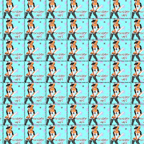
Cut/Paste Identities
We are not ourselves. We cut and paste as we are cut and pasted. We are the remix of images and sounds that never existed outside of this mediated dream. And we are happy to exist this way.
OneSmallStep: a MySpace LuvStory is an unfolding automated jam - a conscious sampling and randomized regurgitation of MySpace.com media archeology wherein desire, fantasy and fetish form a composted feast for the withered and lonely senses in an eternally habitual loop of voyeuristic consumption, spectacular regurgitation, virtual intimacy and identity production/consumption.
With each launch, OneSmallStep runs continuously while randomly remixing content form a database that is periodically updated. OneSmallStep is a conceptually interactive work, and also, a non-clickable work.
OneSmallStep: a Myspace LuvStory is a project developed for Concept Trucking, an exhibiton venue maintained by LeisureArts that uses MySpace as its platform. It hosts work that critiques, mimics, or otherwise utilizes the structural logic of social networking sites and other Web 2.0 phenomena.
Posted by jo at 09:26 AM | Comments (0)
June 02, 2006
Second Life & Flickr Mashups
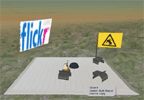
Alas, Second Life! Web 2.0 in a Virtual World
Second Life has been my new hacking obsession ever since I bought a laptop fast enough to run it. I don't spend a lot of time socialising in the gameworld, but I am fascinated by the possibilities for makers of new user interfaces, useful virtual objects and playful toys. With every object being scriptable, aware and active, it's a proving ground for Everyware.
Version 1.10 was released last week, and hidden among the exciting new visual modeling possibilities of shiny rendering and flexible objects was Second Life's own XMLHTTPRequest: llHTTPRequest. Using asynchronous callbacks, it gives the platform an important new capability: communication with the web on demand. A lot of what we are learning about AJAX makes sense here, in this world of Asynchronous Lindenscriptinglanguage And Some-sort-of-data (ALAS!)
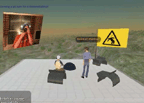
I've spent a few hours hacking on some toy objects with this new capability, starting with the mashup de rigeur: Flickr integration. My home in SL now sports a simple picture frame. Touch it and it looks up your avatar name to see what your favourite Flickr tag is, picks a random picture with that tag from Flickr and displays it on its surface. If it hasn't met you before, it asks you to tell it what tag to use.
Because Second Life is so wonderfully visual, here's a little demo movie that I recorded with Tom Coates:
how it works ... [posted by Matt Biddulph on Hackdiary] [via Wonderland]
Posted by jo at 04:37 PM | Comments (0)
Zipper Orchestra
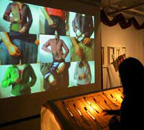
Ziptease
Zipper Orchestra is an interactive video installation that combines the Conductor Musical Score as a physical controller and the Zipper Actions Collage Video as musical display.
The screen is filled with 9 video clips from different people zipping and unzipping their clothes. By moving 9 physical sub zippers and 1 main zipper attached in a canvas, users can control the individual zipper motion in the screen as a conductor. The main long zipper will control 9 motions all together. As the audience zips and unzips zippers on the musical score different pitch of string instrument come out from the speaker.
A work by Joo Youn Paek (who also made the polite umbrella!), in collaboration with Gabe Barcia-Colombo (sound design) and Leif Mangelsen (software tech). [blogged by Régine on we-make-money-not-art]
Posted by jo at 04:06 PM | Comments (0)
Second Life
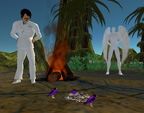
User Creates Virtual Ecosystem
Wagner James Au sez, "While taking a break from the UK game industry to raise her child, a programmer created a self-contained ecology on a Second Life island, with numerous species and natural phenomenon that must work together to keep the system function: clouds rain on the land, nourishing the plants (which also respond to sunlight), bees spread pollen to help the plants reproduce, birds eat seeds to keep the plants from growing out of control, and so on."
If I was to turn off the clouds the whole system would die in about six hours," Laukosargas Svarog tells me. "Turn off the bees and [the plants stop] growing, because nothing gets pollinated. And it's the transfer of pollen that signals the plants to drop seeds. The seeds blow in the wind, and if they land on good ground according to different rules for each species, they grow when they receive rain water from the clouds. It's all interdependent. Link (Thanks, James! ) [blogged by Cory on Boing Boing]
Posted by jo at 03:48 PM | Comments (0)
Interface and Society
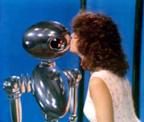
Accessing the "Technosphere"
Interface and Society: Deadline call for works: July 1 - see call; Public Private Interface workshop: June 10-13; Mobile troops workshop: September 13-16; Conference: November 10-11 2006; Exhibition opening and performance: November 10, 2006.
In our everyday life we constantly have to cope more or less successfully with interfaces. We use the mobile phone, the mp3 player, and our laptop, in order to gain access to the digital part of our life. In recent years this situation has lead to the creation of new interdisciplinary subjects like “Interaction Design” or “Physical Computing”.
We live between two worlds, our physical environment and the digital space. Technology and its digital space are our second nature and the interfaces are our points of access to this technosphere.
Since artists started working with technology they have been developing interfaces and modes of interaction. The interface itself became an artistic thematic.
The project INTERFACE and SOCIETY investigates how artists deal with the transformation of our everyday life through technical interfaces. With the rapid technological development a thoroughly critique of the interface towards society is necessary.
The role of the artist is thereby crucial. S/he has the freedom to deal with technologies and interfaces beyond functionality and usability. The project INTERFACE and SOCIETY is looking at this development with a special focus on the artistic contribution.
INTERFACE and SOCIETY is an umbrella for a range of activities throughout 2006 at Ateleir Nord in Oslo.
Posted by jo at 03:09 PM | Comments (0)
Experts Discuss MySpace Issues
![]()
[Whose]Space?
MySpace, with more than 78 million registered accounts, is but one of numerous social networking web sites and chat rooms that would be affected by proposed federal legislation to restrict access to such sites. The new bill, an amendment of the 1934 Communications Act, would require all schools and libraries that receive federal funds to restrict access to these digital tools and online communities.
Henry Jenkins, co-director of the comparative media studies program, and danah boyd (S.M. 2002), a Ph.D. student at the University of California at Berkeley and a leading researcher on MySpace.com, recently discussed the role of social networking sites for youth, the forces fuelling the new restrictions and the effects of limiting participation in new media.
Jenkins's current research, commissioned by the MacArthur Foundation, seeks to identify the core social skills and cultural competencies young people need in order to become full participants in the cultural, political, economic and social life of the 21st century. His new book, "Convergence Culture: Where Old and New Media Collide," will be published this summer.
Funded by the MacArthur Foundation, boyd investigates how youth participation in digital publics, like MySpace, affects identity formation and socialization. Her work explores the nature of informal learning and cultural engagement by youth.
What is MySpace and what is the controversy over it?
Boyd: Structurally, social network sites are a cross between a yearbook and a community web site. MySpace is a social network site where individuals create digital profiles and link to others ("friends") within the system -- similar to sharing home pages.
While MySpace allows 14- and 15-year-old users to restrict who can see their page and contact them, most users opt to make their profiles public. The primary concern is that this openness puts youth at risk, making them particularly vulnerable to predators.
Jenkins: More broadly, teens and adults have developed different notions of privacy: Young people feel relatively comfortable sharing aspects of their lives (for example, their sexual identities). In some cases, teens do not fully understand the risks of making certain information public.
What do "social networking software programs" provide participants?
Boyd: By giving youth access to a public of their peers, MySpace provides a fertile ground for identity development and cultural integration. Youth view MySpace as a place where they can be who they are, joke around with friends and make certain to stay in the loop about everything that is going on around them.
How do MySpace skills fit into adult culture?
Jenkins: Just as youth in a hunting society play with bows and arrows, youth in an information society play with information and social networks. Over the past decade or so, adults have been learning how to interact across multiple communities and negotiate with diverse norms. Social networking services are more and more being deployed as professional tools, extending the sets of contacts that people can tap in their work lives. It is thus not surprising that such tools are also part of the social lives of our teens.
What would be the effect of the proposed legislation on youth?
Boyd: This legislation is targeting MySpace, but it would also block blogging tools, mailing lists, video and podcast sites, photo-sharing sites and educational sites like NeoPets. So it would extend current regulations -- such as the Deleting Online Predators Act -- that require all federally funded schools and libraries to deploy Internet filters. The law is so broadly defined that it would limit access to any commercial site that allows users to create a profile and communicate with strangers.
What about the deterrent effect on predators?
Boyd: Unfortunately, predators lurk wherever youth hang out. Since youth are on MySpace, there are bound to be predators on MySpace. Yet, fewer than .01 percent of all youth abductions nationwide are stranger abductions: Youth are at far greater risk of abuse in their own homes and in the homes of their friends than they ever are in digital or physical publics. Also, police currently patrol MySpace, just as they patrol other areas where youth hang out. Many are thankful to know where youth go online because it helps them do their job.
How might the new legislation relate to the "digital divide"?
Jenkins: The early discussion of the digital divide assumed that the most important concern was ensuring access to information, as if the web were simply a data bank. But the web's power comes through participation within its social networks. What a kid can do at home with unlimited access is very different from what a kid can do in a public library with 10 or 15 minutes of access at a time and with no capacity to store and upload information.
You have previously compared virtual socializing to the unfettered play in the backyards of the 1950s. Have new media changed the nature of play?
Jenkins: What teens are doing online is no better and no worse than what previous generations of teens did when their parents weren't looking. The difference is that as these activities are being digitized, they are also being brought into public view. Parents are experiencing this as a loss of control, but in fact, adults have greater control over these aspects of their children's lives than ever before.
One of the biggest risks of these digital technologies is not the ways that they allow teens to escape adult control but rather the permanent traces left behind of their transgressive conduct.
Boyd: While integrating into cultural life is critical during these years, the actual process is not always smooth or pleasant. Bullying, sexual teasing and other peer-to-peer harassment are rampant among teenagers. MySpace did not create teenage bullying but it has made it more visible to many adults. This visibility can provide a window through which teen mentors can help combat this issue.
Could you offer a political framework for considering MySpace and laws to limit access to it?
Jenkins: Right now, MySpace and the other social network tools are being read as threats to the civic order, as encouraging antisocial behaviors. But we can easily turn this around and see them as the training ground for future citizens and political leaders. Young people are assuming public roles at earlier and earlier ages. They are interacting with larger communities of their peers and beginning to develop their own styles of leadership.
We further exaggerate this participation gap when we restrict the ability of these youth to use social networks via school and library computers.
To read the full text of the proposed legislation, visit tinyurl.com/z8vu3 (PDF file).
A version of this article appeared in MIT Tech Talk on May 24, 2006 (download PDF).
[via the MIT News Office]
Posted by jo at 11:29 AM | Comments (0)
Patroling the Web

World Wide Web Watch
From the BBC, 2006: "Web users to 'patrol' US border":
"Web users worldwide will be able to watch the Texas border A US state is to enlist web users in its fight against illegal immigration by offering live surveillance footage of the Mexican border on the internet. The plan will allow web users worldwide to watch Texas' border with Mexico and phone the authorities if they spot any apparently illegal crossings."
From Heath Bunting, 1997: CCTV - World Wide Watch: Improve self policing with further absented police force. [posted by Chris Byrne on Institute for Distributed Creativity's List]
Posted by jo at 11:12 AM | Comments (0)
Low Drone

Trans-border hopping
Low Drone, commissioned for Tijuana Calling, melds the lowrider, a customized vehicle with hydraulics and candy coated paint, with the functionality of the drone, an unmanned aerial vehicle equipped with surveillance cameras that has been standard U.S. military fare since the ‘60s.
The LowDrone is the world’s first flying lowrider, outfitted with wireless video transmission capabilities and conditioned for remote aerial flight. Through the Low Drone website, users can simulate flight over one of the most surveilled spaces on the planet: the U.S./Mexico border between Tijuana and southern California. By Angel Nevarez and Alex Rivera.
More US/Mexico border stories: Trainers for border crossers, Dentists on the border Mexico / U.S.A., a new U.S. border fence, etc. Via alt_imagen. [blogged by Régine on we-make-money-not-art] [Related: Breaking Through the Stereotypes: Art and Media Activism from Tijuana byArmin Medosch]
Posted by jo at 10:38 AM | Comments (0)
Experimenta @ FACT
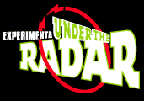
Under the Radar
Kill your television! Get ready for a totally wicked exhibition. Experimenta Under the Radar invites UK audiences to experience and interact with the high voltage works of Australia’s best and most innovative media artists: 16 June - 28 August, 2006.
FACT, the Foundation for Art & Creative Technology is the UK’s leading organisation for commissioning and presentation of film, video and new media art forms. FACT exists to inspire and promote the artistic significance of film, video and new and emerging media.
Includes:
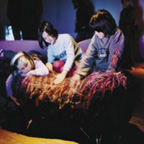
ZiZi the Afffectionate Couch (2003) :: Stephen Barrass, Linda Davy & Kerry Richens: An invention inspired in equal parts by a shaved poodle, a fluffy Persian cat, and an exotic alien sea slug, ZiZi growls when sat on, purrs when touched, and emits soft groans of delight if you stroke her long fur. If left alone, ZiZi mews for attention. ZiZi is an affectionate ottoman couch that asks for emotional support while offering physical comfort. The responses are triggered by touch-sensitive cables, which are sewn into the fluffy upholstery of the couch. While Barrass claims that ZiZi’s personality is based on his pet Dalmatian Ziggy, we can safely assume that the artist does not sit on his dog.
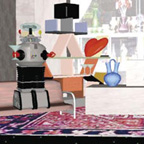
Op Shop (1999-2002) :: Stephen Barass: Cluttered from floor to ceiling with bric-a-brac, Op Shop is a virtual environment that is transformed by sound. Unlike most interactive interfaces where communication occurs by means of a stylus, mouse or other device, Op Shop encourages collaborative interaction. By singing into the microphone a visitor can disturb the virtual objects; a high-pitched wail can shatter glass. By singing and sustaining a low note, they can smash a table. An ever-changing choral score emerges as multiple participants explore the effects of their vocal range. This cacophony of hums, croons, shrieks, claps and whistles, punctuated by percussive shattering and laughter, propels the visitor towards an unexpected finale.
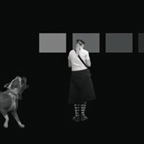
Dislocation (2005) :: Alex Davies: What happens when we can’t trust what we see with our own eyes? As visitors peer into the portals of Dislocation, they become auto-voyeurs seeing and hearing unnerving scenarios play out behind them only to discover the room is empty when they turn around. Ingeniously programmed by Davies to overlay pre-recorded sequences with realtime footage, the simultaneous presence and absence of these phantoms defies rational thought and experience, and creates a haunting atmosphere. The work creates an environment of deception and uncertainty whose subtlety and cunning displaces our reliance upon, and trust of, our own distinct emotional responses to the presence of others.
Posted by jo at 09:51 AM | Comments (0)
Next UpStage Walk-Through and Swaray
![]()
Online Performance Environment
The next open walk-through in UpStage will be on Wednesday 7 June at the following times: California, USA: 2am; New York, USA: 5am; UK: 10am; Western Europe: 11am; Finland: 12am; Australia - NSW: 7pm; NZ: 9pm. Check http://www.worldtimeserver.com for your local time.
The open walk-through is a chance for you to learn about the UpStage environment and to play around in it with others. To participate, point your browser at http://upstage.org.nz:8081/stages/presentation at the appointed time; if you'd like to log in & learn how to use UpStage, or if you already know how & want to come & have a play around, please email me for a log in: helen[at]creative-catalyst.com
Another date for your diary is Sunday 11 June, 9pm NZ time: the second ADA Swaray will take place, with more mischief, mayhem and maybe even a little morsel of discussion ... put on your best frock and join us at http://upstage.org.nz:8084/stages/swaray on sunday.
Posted by jo at 08:41 AM | Comments (0)
June 01, 2006
UPGRADE! BOSTON:
![]()
ERYK SALVAGGIO
UPGRADE! BOSTON: ERYK SALVAGGIO -- Join us for a presentation by net artist Eryk Salvaggio followed by a dialogue between Eryk and Brooke A. Knight. WHEN: June 1, 7:00-9:00 p.m. [details]
Called "The Harry Potter of the Digital Avant Garde" by the Dutch Press, Eryk Salvaggio has been creating internet art since he was 17 years old. His work has been compared to "a more human Andy Warhol," and strictly adheres to his own "6 Rules Toward a New Internet Art." This formula has led to articles in the New York Times* as well as mentions in ArtForum, alongside several international exhibitions and talks.
Turbulence commissioned Salvaggio's "American Internet" in 2002, and he curated "Duchamp's Ideal Children's Children: Net.Art's Brat Pack" for Turbulence's Guest Curator series in 2003. He's currently working on "MySpaces," a piece about the projection of self onto social networking sites such as friendster and myspace, and a degree in New Media and Journalism at the University of Maine.
Artist and educator BROOKE A. KNIGHT has been working with digital media for over a dozen years. His current interests include webcams, the landscape, and text in all forms. Knight is Assistant Professor in the Department of Visual and Media Arts at Emerson College, Boston. He received his MFA in photography from CalArts in 1995.
Links:
*September 11, 2001
American Internet
Duchamp's Ideal Children's Children: Net.Art's Brat Pack
MySpaces
Eryk Salvaggio
Brooke A. Knight
<< UPGRADE! BOSTON: NANCY NISBET AND AMBER FRID-JIMENEZ >>
WHEN: June 29, 7:00-9:00 p.m.
WHERE: Art Interactive
Upgrade! Boston's schedule is available here: http://www.turbulence.org/upgrade/archive.html
Posted by jo at 11:51 AM | Comments (0)
Turbulence Commission:

"mobotag" by Marta Lwin
mobotag reveals the hidden layers of a city through an active exchange of location based media and text messages via the cellphone. It's collaborative phone tagging of the city. Part virtual graffiti, part walking tour, "mobotag" creates a spontaneous and easy way for tagging a neighborhood via the cellphone. Send and view messages, images, videos and sounds. See art, read stories, and watch a hidden layer of the city reveal itself. Respond with your media and participate in the creative expression and mapping of your neighborhood. By sending a text message to "mobotag", with your city location, you begin an interactive tour of a neighborhood. Using a unique geocoding feature, "mobotag" tells you what other messages exist in your local area. In the near future "mobotag" will also feature art projects including "flyHere," a mobile phone audio installation featuring native bird calls; "bugBytes," collectible graphical bugs originating at major telecoms around NYC; and "lookHere," a written work in short form by a native NY writer.
"mobotag" is a 2006 commission of New Radio and Performing Arts, Inc. (aka Ether-Ore) for its Turbulence web site. It was made possible with funding from the Jerome Foundation.
BIOGRAPHY
Marta Lwin is an artist, technologist, and researcher who recently completed her masters at the Interactive Telecommunications Program at NYU. Her background is both in art and activism. In the early to late 90's she worked with Greenpeace, UNEP, and Women's Environmental Network and Reclaim the Streets (UK). After joining a loose network of artists at Backspace in London, Lwin became interested in the creative use of technology as it relates to biology. Currently, her work focuses on the intersection of art and technology and includes projects that critically challenge and subvert accepted perceptions of the relationship between nature and technology. Her work has been shown at galleries in Europe and New York. Publications covering her work including networked_performance, Engadget, Core77, Treehugger, Cool Hunting, MocoLoco, WorldChanging, Rhizome and We Make Money Not Art.
Posted by jo at 11:38 AM | Comments (0)
Urban Typhoon Workshop in Shimokitazawa
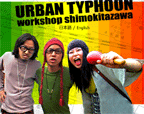
To Produce Alternatives
[Posted by Yukihiko YOSHIDA] We invite creative spirits from Japan and abroad to brainstorm on the present and future of Shimokitazawa, at a time when the government is planning a 26 meter-wide road cutting through its culturally vibrant streets. The Urban Typhoon Workshop--Tokyo, June 26-29, 2006--is a global experiment in participatory design, and includes architecture & design studios, art installations, political cafe, oral history, graphic communication, video, etc.
The objective is to produce alternatives to the government's plan as well as a multimedia testimony to the unique spirit of Shimokitazawa. The workshop itself is a joyous and participatory takeover of the city. Registration deadline: May 31, 2006; Registration fee: 10,000 yen (payable upon arrival at workshop); info[at]urbantyphoon.com
* Urban Typhoon welcomes registration from students, architects, urbanists, artists, designers, media & communication specialists, social scientists, activists, creative people, dreamers, and idealists of all kinds. The number of registrants is limited. Each unit has a small number of participants.
* There are a limited number of homestays available to foreign students, free of charge.
* All workshops will be conducted in English and Japanese.
Workshop units:
* a|Um Studio / New York, Carla Leitao
* Koba. Arch. Lab. / Tokyo, Masami Kobayashi
* CAt /Tokyo, Kazuhiro Kojima & Kazuko Akamatsu
* Save the Shimokitazawa / Tokyo, Kazuho Kimura & Kenzo Kaneko
* Art Harbour / Tokyo, Lehan Ramsay & friends
* Yehuda Safran / Paris, New York
* Studio SUMO / New York, Yolande Daniels & Sunil Bald
* Supersudaca / Chile, Argentina, Mexico, Pablo Corvalan, Felix Madrazo, Manuel de Rivero
* Shimokita Oral History / Tokyo, Taro Taguchi
* Team Un-simultaneous / Tokyo, Hidenori Watanabe
* Alto Majo / Tokyo, Alejandro (Alex) Jaimes, Tomo Takeda, Matias Echanove, Joanne Jakovich
Partners: The University of Tokyo, Meiji University, Cultural Typhoon, Future University-Hakodate, Yoshimi Lab, Save the ShimoKitazawa, Shimokitazawa Forum, Archi-media, coelacanth and associates inc., sumo, a|Um Studio, supersudaca, Misatikoh, sakura mapping project, urbanology.
Posted by jo at 11:25 AM | Comments (0)
ELIZABETH LEISTER
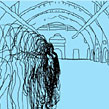
EVERY BODY IS EVERYWHERE AND NOWHERE
Every Body is Everywhere and Nowhere combines performance and technology in an immersive video installation. This new project continues Elizabeth Leister's themes of transformation and control in relation to the body. Leister's performative investigation is informed by a history of body-based performance art, including, Ana Mendieta's "Silhueta Series", "Push Ups", by Vito Acconci and "Up To and Including Her Limits" by Carolee Schneemann. Like the aforementioned, Leister uses video images of body imprints and line drawings, actual and animated, to study the physical and virtual body in space.
What occurs when the body is transformed through our use of technology? The amalgamation of video, performance and drawing in Leister's project links the traditional to the technological and emphasizes the physical impact of our bodies on the world we live in with one another. Our body language, sense of touch, corporeal presence and physical movement through space become invisible as we interact via machines. What is lost? What is gained?
Leister will perform a drawing to define her own physical borders within a specific moment in time and space. This drawing will be made each day for the duration of the exhibit in Leister's Los Angeles studio and transmitted through live-feed via web-cam, into The Morris Gallery in Philadelphia. The traditionally intimate space of performance will expand as the body of the artist is projected across space and time. Made up of shifting light and pixels traveling through cyberspace, the body becomes expansive and limitless.
A second video shows a collage of the imprints left behind by Leister's family and friends: a snow angel, footprints in the sand, a sweater tossed to the ground. A third projection of an animated drawing outlines, frame by frame, a body moving through space. Like the drawing created in the performance, lines are built up to define a path of movement, then reverse and erase.
A computerized voice expresses a desire to be everywhere and nowhere, everyone and no one while a second audio track, taken from Leister's writings, is an overlay of a human voice whispering as if she were light and breath in an unnamed space.
Finally, the video projections will be installed in relation to a set of mirrors to create a kaleidoscope of images that will reflect the body of the viewer. Through live-feed performance, drawing and video the project will juxtapose the physical body and the immateriality of the virtual body.
The exhibition in the Morris Gallery at the Pennsylvania Academy of Fine Arts opens on June 10th and runs through August 20th. The installation, which will open with a free reception June 9 from 6 to 8 p.m., is curated by Alex Baker, the Academy's Curator of Contemporary Art.
Museum hours are Tuesday through Saturday, 10 a.m. to 5 p.m., and Sunday, 11 a.m. to 5 p.m. The Academy is located at 118-128 N. Broad Street in Philadelphia, two blocks north of City Hall. Regular admission is $7 adults, $6 seniors and students with ID, $5 children / youth ages 5-18, free for members and children under age 5.
Elizabeth Leister received an M.F.A. in sculpture from the Milton Avery Graduate School of the Arts at Bard College and a B.F.A. from the Tyler School of Art. In Philadelphia, her work has been exhibited at the Philadelphia Museum of Art and Nexus Foundation for Today's Art. Her work has also been shown at the Delaware Museum of Art, the North Dakota Museum of Art, Art in General and P.S. 122 in New York, and the Kellogg Art Gallery at California State Polytechnic University, Pomona, among others. She has received awards from the Pennsylvania Council on the Arts and the Leeway Foundation.
Posted by jo at 11:06 AM | Comments (0)
MOBILE ASIA COMPETITION 2006

[CALL FOR PARTICIPATION]
MOBILE ASIA COMPETITION 2006: ORGANIZED BY ART CENTER NABI, SEOUL, KOREA :: The progress of mobile technology characterized by mobility, connectivity, and dispersion seems to resonate with the diasporic experiences of Asians who are mobile, dispersed yet connected with each other through socio-cultural dynamics and relations. With the mobile market and its culture expanding beyond Korea, Japan, China, and Taiwan to the Southeast Asia, the need should be raised for reflecting upon the currency of culture and the urgency of new identities that are evolving with mobile technology in Asian region.
Mobile Asia Competition 2006 hosted by Art Center Nabi pays attention to the role of media makers and artists in articulating and expressing the Asian mobile cultures. Artists and media makers always appropriate and challenge the given technology through creative ideas and critical practices to broaden the space of possibilities. Especially, the recent emerging ubiquitous mobile environments requires both popular sentiment and critical thoughts. Mobile Asia competition 2006 investigates the new forms of Asian identities and cultures in the creative works of artists and designers who dare to experiment, play, and wrestle with the mobile technologies.
CATEGORY
1. Works made to be viewed and experienced on mobile devices
(1) Game, Interactive Art
(2) Screen-based arts : Animation, Motion Graphic, Documentary, Music Video, Narrative film, etc.
2. Works made by mobile phones such as camera phone, video phone.
3. Idea proposal for wireless art projects on the theme of ‘connectivity and social network’. Art project that expresses the theme of social network and connectivity while exploring new and artistic ways of using diverse personal media such as mobile phones, laptop, PDA and internet network.
PRIZE: The total award money is US $20.000 and the selected works will be exhibited in various on and offline venues.
Category 1 & 2 (Mobile content): US $10.000
- One winner from each category will be awarded with $5000.
- The works by winners and other selected works will be screened and exhibited at Art Center Nabi, ResFest Korea 2006 (digital film festival), and Korean mobile phone service including DMB channel.
Category 3 (Wireless art proposal): US $10.000
- One winner will be awarded with $5000.
- Additional $5000 and technical support will be offered for the realization of the proposal if the work is decided to be realized for the exhibition at Art Center Nabi.
SUBMISSION GUIDELINES
.Category 1 & 2 seek for completed works, and Category 3 for project proposal.
.Projects that are under development will also be considered for Category 3.
.Project proposal should relate to the theme and topics of the Award
.The works that are already presented or won in other competitions are not eligible for entry.
_HOW TO SUBMIT
.All submissions should be processed through the official online platform.
.Biography, project proposal, and other supporting materials (image, sound, movie files) should be uploaded in appropriate format indicated in each section.
.However, the works applying for Category 1 & 2 should be sent via registered mail in the format of CD-Rom, DVD, Mini DV tape with a copy of filled-out online registration form printed from the website.
Please go to http://www.nabi.or.kr/pages/submission.asp to complete your submission. (all submissions)
Mail address (Category 1 & 2 only):
Art Center Nabi [Att: Mobile Asia Competition 2006]
99 Seorin-dong, Jongro-ku, SK bldg. 4th fl.
Seoul, Korea
110-110
_IMPORTANT DATES
Deadline for Submissions
.Category 1 & 2: August 31, 2006
.Category 3: July 31, 2006
Notification of winners September 15, 2006
CONTACT: For more information, please visit www.mobileasia.org.
Or contact at mobileasia[at]mobileasia.org
Art Center Nabi
99 Seorin-dong, Jongro-ku, SK bldg. 4th fl.
Seoul, Korea
110-110
www.nabi.or.kr
Posted by jo at 10:56 AM | Comments (0)
Invisible Maze
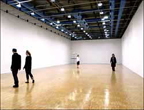
You Make It
Jeppe Hein's Invisible Maze installation is just what its title says: invisible. The promised maze is there but it only materialises as we move around in it. Visitors are equipped with digital headphones operated by infrared rays that cause them to vibrate every time they bump into one of the maze's virtual walls. Thus, the exhibition is perceived as a both minimalist and a spectacular playground. The maze structure spans six different variants, all of them referring to labyrinths from our common cultural history. From the medieval labyrinth in Chartres to Stanley Kubrick's fateful dead end from the film The Shining to Pac-Man. The maze changes from day to day, inviting visitors to make repeat visits.
Statens Museum for Kunst in Copenhagen will present Jeppe Hein: Invisible Maze 10 June - 27 August 2006. The exhibition represents a further development of the exhibition Invisible Labyrinth which attracted 50,000 visitors during its two-month run at the Centre George Pompidou in Paris last year. Via Art Daily. Thanks Joshua. Other work by Jeppe Hein: Distance.
More sound-based spatial installations: audio space + audiotag + audio graffiti, Mapamp, Sonic city, sound mapping, Aura, Akitsugu Maebayashi's audio work, Audio Viscera, electrical walks, aetherspace, etc. [blogged by Régine on we-make-money-not-art]
Posted by jo at 10:15 AM | Comments (0)
Upgrade! Amsterdam
![]()
"Liveness" in Technologised Performance Art
Upgrade! Amsterdam 1.0: [Goes Live!] :: When: June 14 2006 || 20.30 hours || Where: De Melkweg, Theaterzaal, Lijnbaansgracht 234 A, Amsterdam | free admission | | absinthe martinis | | buttons | LIVE webcast: www.fabchannel.com
| Upgrade [Goes Live!] | At Upgrade! Amsterdam we leap into summer by pondering the notion of “live” in the context of technologised performance art. Has the advent of the laptop, and practices such as "live cinema" (realtime visual editing) and ‘live coding” (on-the-fly sound programming) created new performative paradigms? How do algorithms, the laptop and conventions of more traditional forms of improvisation sit together? An evening of sound, image and live ambience:
Artist and film curator Martijn van Boven will take us on a rollercoaster historical ride tracing the roots of live cinema back to avant-garde and abstract film. He is followed by Trace Reddell, Professor of Digital Media Studies, who will pick up where Martijn left, and perform his latest Live Cinema piece "Brink of Disaster”.
Upgrade Montreal colleague Tobias c. van Veen will muse on the various paradoxes of “live performance” in laptop sound art, while all you ever wanted to know about live coding but were afraid to ask, will be exemplified by Jan-Kees van Kampen’s performance"Why is it pt.17?". The latter takes the live coding Toplap Manifesto, and reinterprets it by using a tasty collection of algorithms, inspired by Tom Johnson's Self-Similar Melodies. Last but not least, under the enjoyment of a freshly mixed absinthe martini, Tobias DJs us into the night and gets the party started.
Guests:
| Tobias c. van Veen (CDN) | Is a renegade theorist & pirate, techno-turntablist & writer (Montréal). He is Concept Engineer at SAT and and Project Lead of Sonic Scene in the Mobile Digital Commons Network. He currently hosts The Upgrade! Montreal, and is is doctoral candidate in Philosophy & Communication at McGill University.
http://www.quadrantcrossing.org
http://www.quadrantcrossing.org/blog
http://theupgrade.sat.qc.ca
| Trace Reddell (US) | Is Assistant Professor of Digital Media Studies at the University of Denver, and the graduate director of the M.A. in Digital Media Studies. He has participated in global webcasting projects, and edits an ongoing thread at Electronic Book Review devoted to music / sound / noise and produce shows for Alt-X Audio.
http://www.du.edu/~treddell
http://dms.du.edu/
http://www.altx.com/audio/
| Martijn van Boven (NL) | Is an artist and works as a free-lance film and video curator, focusing on avant-garde film and abstract cinema. He teaches audio-visual Design at the Art Academy of Arnhem (NL). In 2003 he co-founded the new media art centre <>TAG (The Hague).
http://www.tag004.nl
| Jan-Kees van Kampen (NL) | Focuses on networked performances and live composition. He plays in Powerbooks Unplugged, a 4-headed laptop band, and is part of the goto10 collective. He works as a technician for De Waag Society in Amsterdam.
http://vacca.goto10.org
http://pbup.goto10.org
http://www.goto10.org
Posted by jo at 09:47 AM | Comments (0)
The Busycle
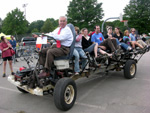
Cross Country Story Collecting Tour
The Busycle, a 15 person pedal powered bus, is taking its first U.S. Story Collecting Tour. The Busycle is a story collection vehicle. The traveling public art piece will start in Boston, and, hauled by a grease/ bio-diesel vehicle, will end in San Francisco. Between, the Busycle will visit cities and collect stories of the people who pedal it.
In cities across the U.S., the Busycle will travel neighborhoods, where anyone willing to pull their weight and pedal can be a Busycle passenger. At the end of the route, a story collection space will be constructed (in places ranging from parks to warehouses to galleries). At this temporary story collection space, everyone has the option of being a participant. And just as the Busycle doesn’t run without the pedaling, this venue doesn’t run without the contribution of stories.
It’ll be an urban play on the campfire as the traditional space for story telling and stories will be recorded on video. Stories recorded in one city will be shared in the next city, connecting the experiences and stories of the tellers and listeners. Everyone is asked to bring a blanket (and their story, if they choose) to the story collection.
The Busycle Cross Country Story Collecting Tour: WHEN: June 2006; STARTING POINT: Boston; MIDDLE POINTS: Providence, Cleveland, Minneapolis, Marquette NE, Minneapolis, Cheyenne, Salt Lake City, Reno; ENDING POINT: San Francisco; CONTACT: Heather Clark / Matthew Mazzotta, 617-721-3475, busycle[at]gmail.com
![]()
The Busycle, under development since 2005, runs solely on the energy of its passengers. All passengers are required to pull their weight and pedal in their seats. The pedal power then moves the Busycle from destination to destination. The Busycle’s public life involves experimental public rides that travel down city streets, where story telling is of the essence. It is our goal that by bringing art and technology clearly into the public realm and as near to the community as possible (what could be closer than riding an art project down the streets where people live and inviting them onto the art?), we will begin to stir a dialogue about the current and universal issues from which the Busycle has grown, while creating a forum for people to pause and enjoy.
Posted by jo at 08:42 AM | Comments (0)
